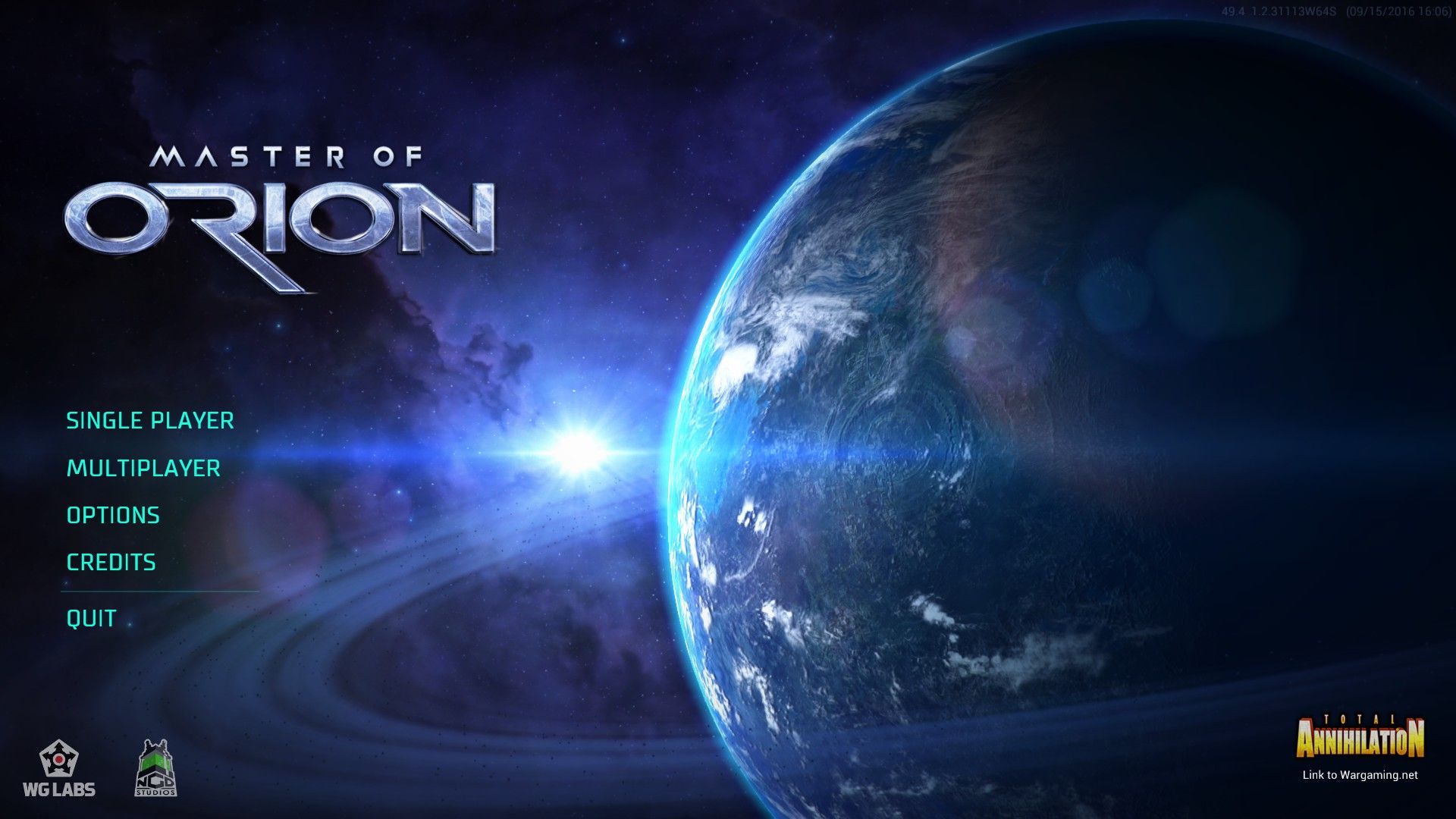|

|
| # ¿ Apr 29, 2024 02:45 |
|
Within Sight of a New Era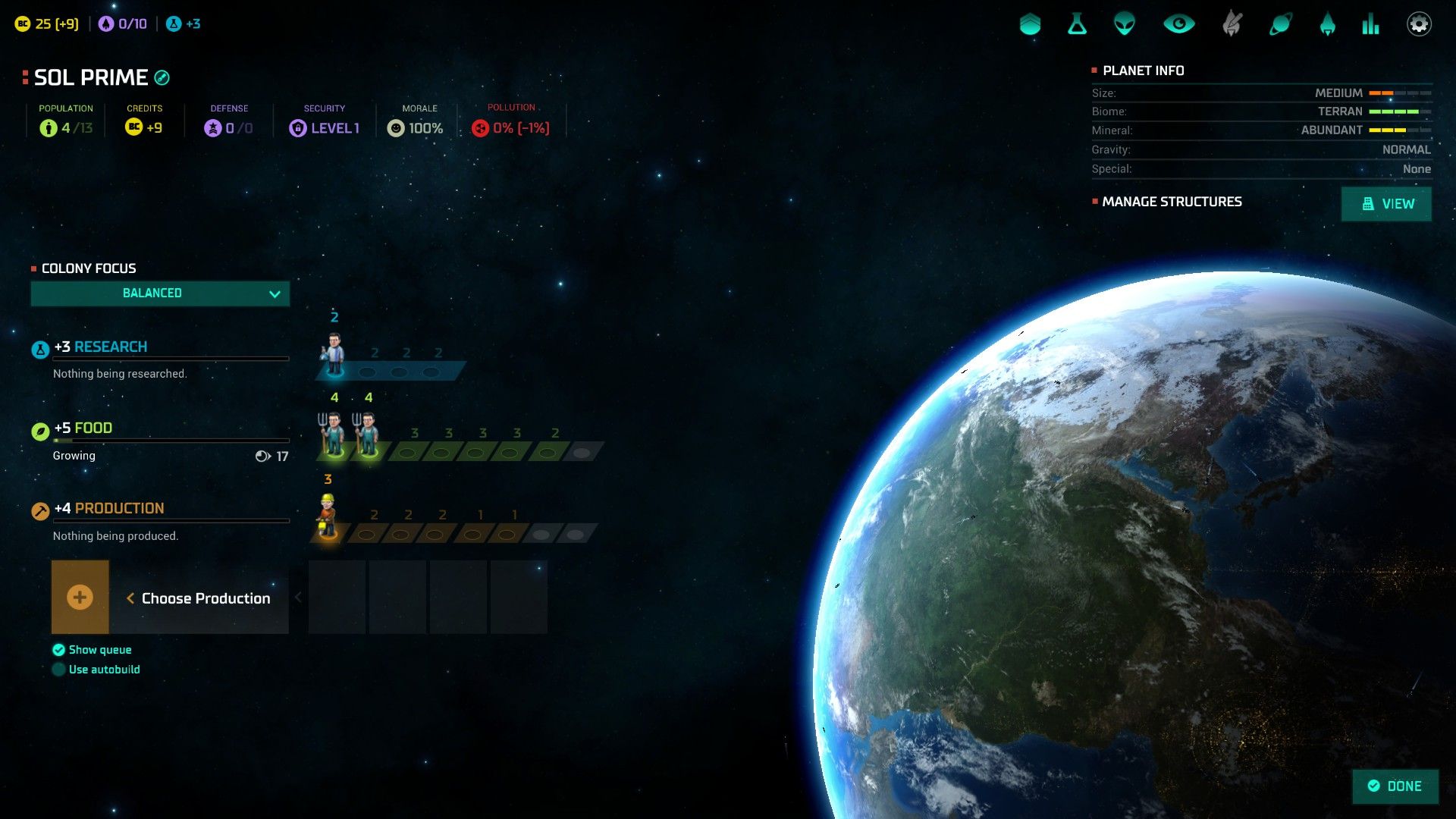 The 24th century is beginning, and the Human Republic rules the Earth, as it has for the past six decades. The collapse of Human prosperity from the disastrous years of xenophobia and war that spanned the 22nd century has largely been reversed in a new era of globalisation and commerce, and the population has at least partially recovered from the Great Blights that nearly drove Humanity to extinction through famine and deprivation. By now, the Human population stands at just over four billion, with approximately five percent of the population employed in total in the critical fields of agriculture, heavy industry, and scientific research. The best agricultural land and deposits of metals and minerals have been developed on Earth, with potential future development likely to meet diminishing returns. 25 trillion Republic credits stand available as investment capital, with an estimated nine trillion more being generated per annum. Each planet has a certain fraction of its potential maximum population available for agriculture or industry, with diminishing returns as more and more population is dedicated to each field, and with the overall potential of agriculture and industry determined by the planet's biome and by available mineral wealth. Our planet has one structure pre-built- our Capital, which provides +1 flat research, food, and production, +25% morale, and increased internal security against espionage, reflecting the established historical infrastructure of the homeworld and its position as administrative center of our civilisation. It, however, costs 3 trillion credits a year to maintain. Each population unit of one billion persons generates 3 trillion credits for us per year. Each billion population eats 1 unit of food per year, with population growth provided by food surpluses over this minimum. This particular change is one I find unsatisfactory- this perhaps made a logical model in Civilisation, which largely focused on pre-industrial populations which often had population growth limited by unreliable food supplies, but for post-industrial societies which can reliably produce the food they need, I liked the Master of Orion 2 model where food consumption is a simple upkeep and population growth occurs at a set rate, possibly boosted by specific projects.  Recent breakthroughs in theoretical physics have revised Human understanding of what is possible in this universe- it is now believed that complex and unpredictable gravitational interactions between the deep gravity wells of stars can create 'channels' in space that can allow objects to be placed into an exotic state that permits faster-than-light travel. Observations in the Sol system itself suggest that two such conduits exist linking Sol to nearby neighbors, while the wealth of the asteroid belt continues to promise great things if it can be exploited. Travel on the strategic map takes one year from any point in a star system to any other point in the same system, representing a general repositioning sometime in the year and whatever military, survey, or construction work is done that year, with multiple-year trips between star systems along their linking conduits. 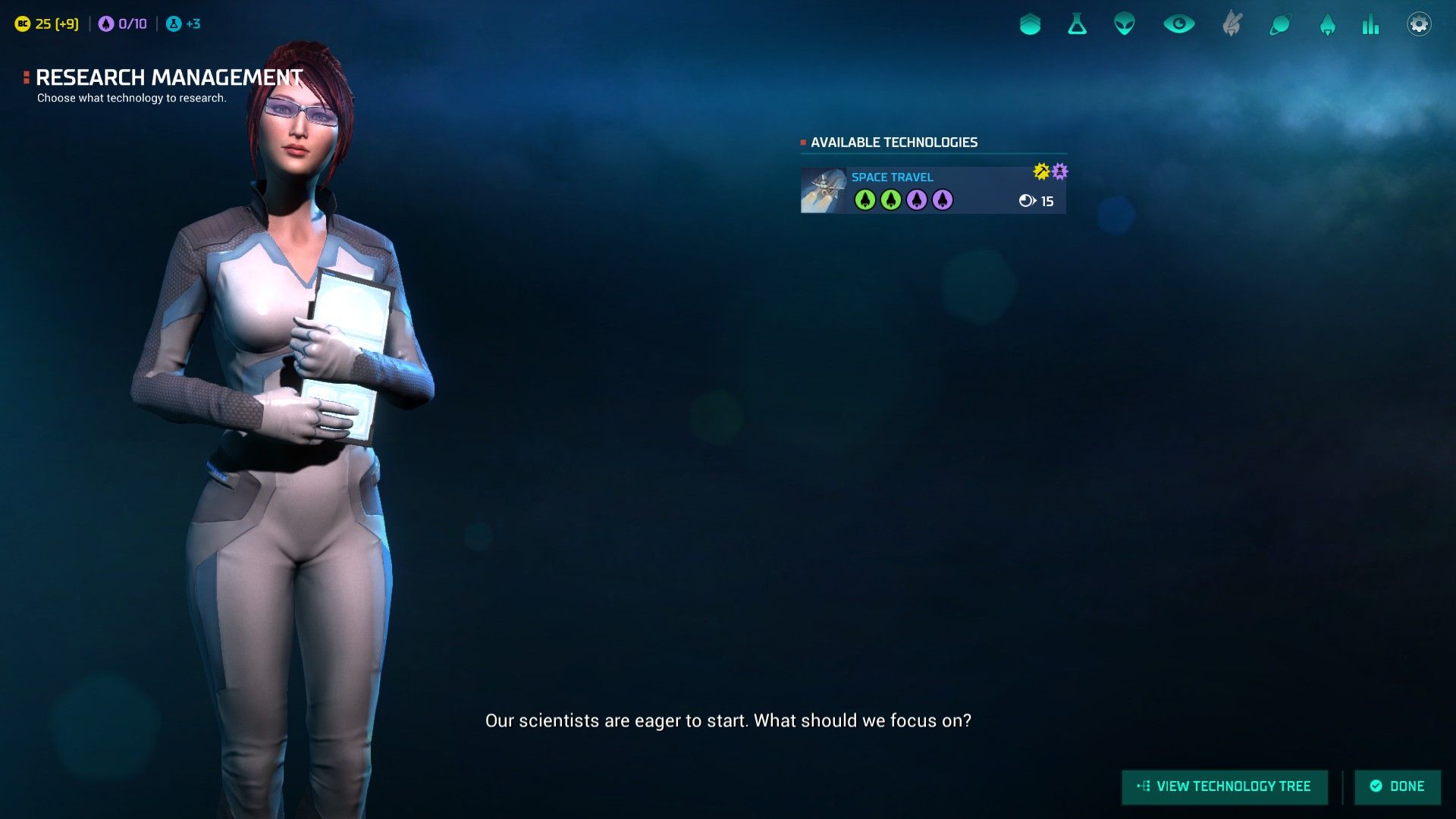 Developing the industry and technology to effectively take advantage of this new theory of FTL travel and to effectively exploit the riches of space, however, is a non-trivial task. Different aspects of the great project to reach out into space are taken up by corporate, academic, and military research teams. With a pre-warp start, there is no choice for the very first technology to research- you must research Space Travel before anything else. The practises of good governance and rule of law that are well-established in the Human Republic will immediately grant us the Government technology for free as soon as we finish researching Space Travel, however. 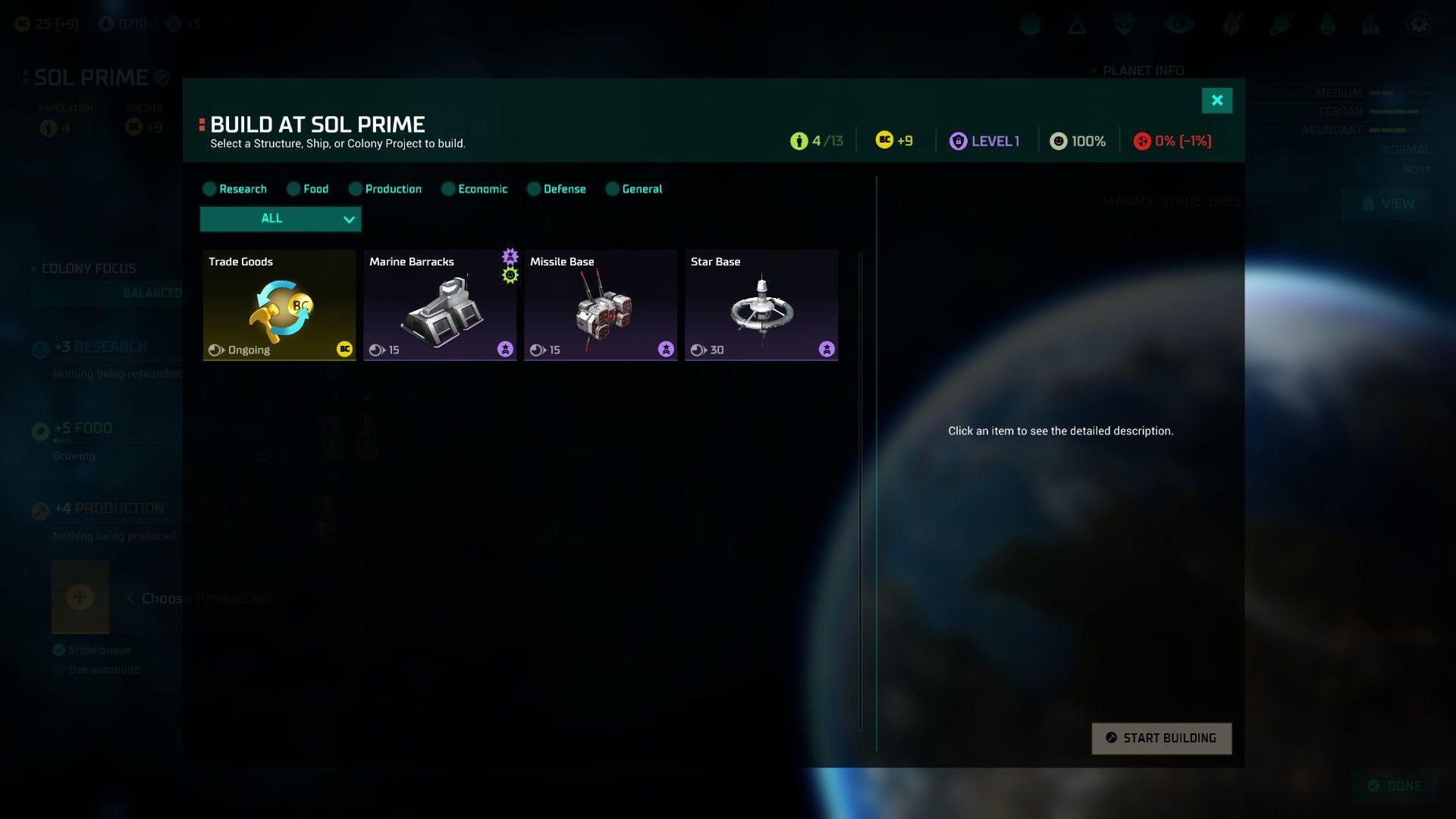 Earth, at the moment, is largely demilitarised, but the Republic's chiefs of staff believe that even with current technology work on an orbital command center for future exploratory and defensive forces could commence. Such an armed space station would also provide a notable defense against whatever unknown threats lurk in the larger galaxy. Without the burden of supporting a major military construction project, however, perhaps Earth could enjoy a somewhat more secure prosperity and swifter progress. President Joshua Alexander, a North American, is the newly-elected President of the Human Republic, and will remain so for the following five years, at least. While President Alexander heads the executive branch of the Human Republic, the Senate and the Popular Assembly make up the real legislative authority, while the bulk of the economy is dominated by private firms and individuals ranging from massive industrial corporations to self-employed individuals running their own small businesses. 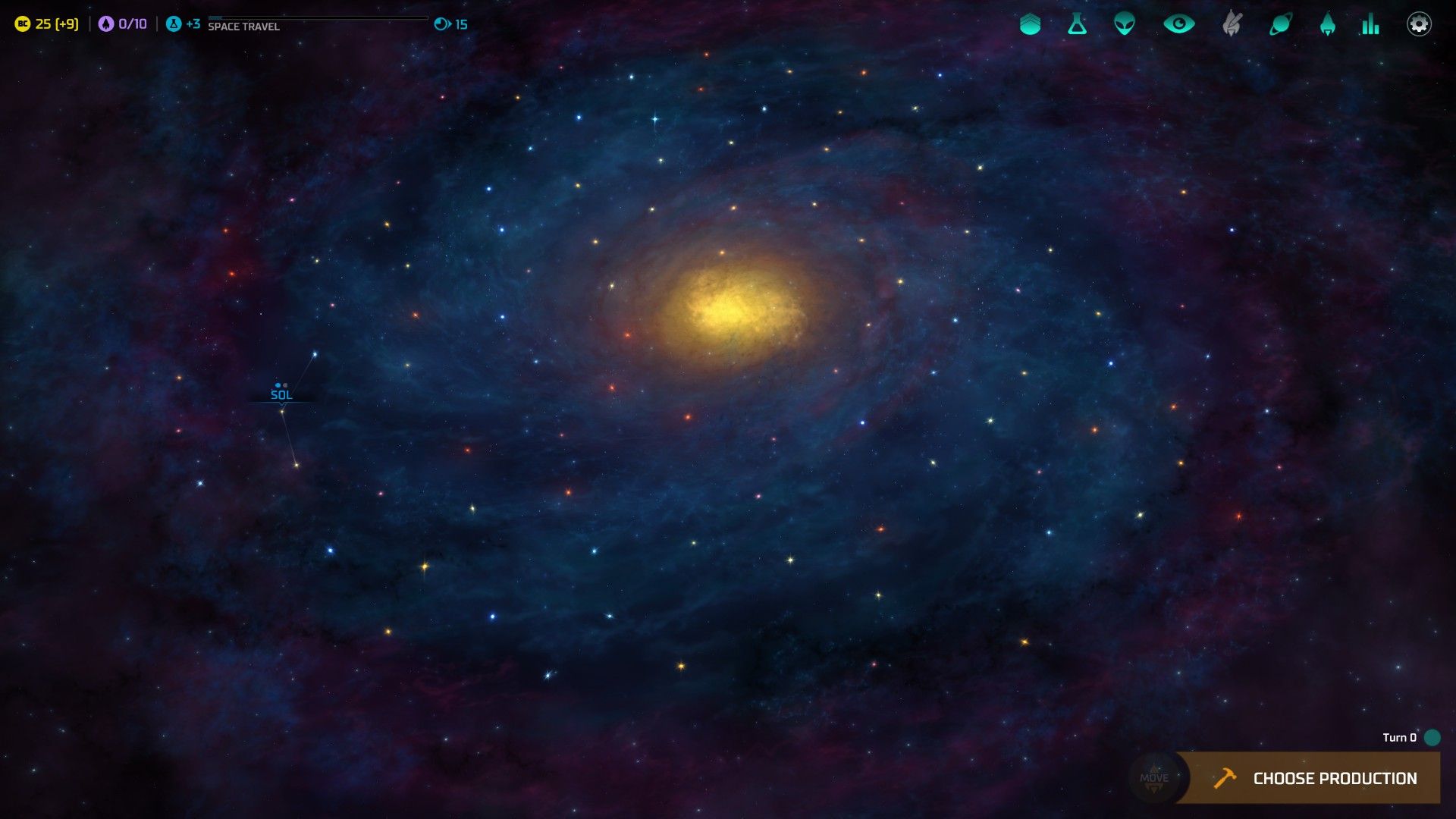 The galaxy as a whole remains unexplored and unknown. What awaits Humanity beyond its own small corner of the galaxy is a mystery. Proposals for the People of the Republic Early Industrial Priorities The legislature could potentially authorise appropriation of funds to start construction on an armed orbital station intended to serve as a central command hub for the Republic's military and exploratory services. Although construction is likely to be put on hold following breakthroughs in science in favor of other projects, the partial completion of the station will reduce time needed in the future to bring such a station to full operational readiness. Barring such appropriations, Earth's industry could greatly expand production of basic industrial machinery and durable consumer goods, with an estimated value of two trillion credits per annum, or increased resources could be invested into corporate and academic research needed to lay the foundations for an interplanetary and interstellar society for Humanity. Please vote for industrial resources being devoted to starting construction of a Star Base, to production of Trade Goods (+2 trillion credits/year), or to more research (+2 RP/year) until we discover Space Travel. Secondary Research Civilian research funding not currently dedicated to space science is currently largely split between further research into physics, expected to pay off in computing and particle physics useful to general industrial manufacturing and to weapons development, and research into biology and agronomics, expected to have notable agricultural applications. Please vote between Physics or Biology as our second field of research; the other shall be our third. Physics will help bolster industrial output and give us somewhat better weapons; Biology will decidedly help agriculture. Exploratory Service Proposals Preliminary discussion about the establishment of an interstellar exploratory service has begun in the legislature, although appropriations are only likely to begin following future technological breakthroughs. The Chiefs of Staff propose development of an armed spaceframe with the exploratory service folded into the military command structure, while others propose a civilian exploratory agency contracting interstellar exploration out by competitive bid. Military exploratory vessels are likely to be nearly twice as expensive as the civilian alternative, but can still be under way within a reasonable timeframe and are likely to both be far more protected against unexpected threats and will easily be repurposed as an effective defense against whatever may threaten Humanity. A civilian service will be significantly less expensive, and allow Earth to more swiftly develop other needed infrastructure without the added burden of a militarised exploratory service. Either way, only a single vessel is planned for the initial service. Please vote between a militarised or a civilian exploratory service. May the stars prove full of opportunity for Humanity. nweismuller fucked around with this message at 06:36 on Oct 3, 2016 |
|
|
|
I just added a shot of the galaxy as a whole that I forgot to originally add to the initial 2300 update.
|
|
|
|
A Brief Survey of the 21st Through 23rd Centuries By the end of the Twentieth Century, it may have seemed that the world would have continued to smoothly progress into a future of peace and globalisation more firmly connecting every corner of the Earth. Unfortunately, the twin strands of protectionist xenophobia and bureaucratic authoritarianism continued to gain ground in both the United States of America and the European Union, even as they were drawn into a series of brushfire conflicts over the first half of the Twenty-First Century. By about the 2070s, both the Americans and Europeans had been cemented as bureaucratic-authoritarian centralist states with a thin veneer of democratic accountability, having converged on the position of the third Great Power of the world, the People's Republic of China. The globalist project of commerce had sputtered to a halt, with the Great Powers sealing their borders and competing through military actions in what was rapidly growing into a second age of imperialism. Armed conflict between Americans, Europeans, and Chinese in some corner of the world being forced into one or another sphere of influence was not uncommon, and during a period from 2084 to 2178, at least one of the Great Powers was at war without interruption. The threat of nuclear annihilation limited the scope of wars between the Great Powers and encouraged the development of an active diplomatic corps in all three Powers, dedicated to ensuring that conflicts would not boil over into full nuclear exchange, but this nonetheless was poor comfort to those outside the central portions of the Great Powers who suffered in the various wars of empire. In 2178, the Great Blight was released, believed to have been designed by an Australian geneticist in a resistance movement against Chinese occupation. This Blight was, properly speaking, actually a series of independent crop diseases intended to target every major staple crop, and it is believed that the original intent was simply to cause crop failures in China. The Blight, however, spread rapidly in a series of catastrophic crop failures across the world, and persistent outbreaks of Blight continued until the last outbreak in 2245. The results were horrific- famine on a truly apocalyptic scale ravaged the Earth over the decades, leading to a mass die-off of Humanity. By 2190, all the major governments of Humanity had functionally collapsed, although the diplomatic corps of all three Great Powers continued open communications with each other to attempt and stave off nuclear exchange until the very end of their governments, leading to the frantic series of nuclear arsenal decommissionings of 2185-2190. Attempts by crop geneticists to combat the Blight in local communities slowly reduced the intensity of outbreaks, while the efforts of a slowly growing network of merchant-adventurers began to cushion the effects of local famines by the 2220s, with food purchased in areas still able to gather harvests and sold in areas suffering crop failures. The Human population had crashed from a high of approximately ten billion before the Blight to an estimated low of one billion by the 2220s, but Humanity could once again rebuild. Some of the local governments that re-emerged as the world slowly recovered from the complete civil collapse of the Blight years were little more than strongarm warlords, but many were genuine democratic states with renewed liberty for their people following the harsh controls of the great empires, and a growing awareness on a global scale of how the authoritarianism and xenophobia of the great empires eventually led to the catastrophe of the Blight. Many of these local states were eager to form loose agreements with any neighbors that likewise maintained democratic forms, and in 2242 the constitution of the Human Republic was drafted by a worldwide confederation of democratic states. A series of small-scale wars from the 2230s to the 2260s led to the fall, one by one, of the various small warlord states, and by 2264 Earth was truly united under a single government. The efforts of scientists, diplomats, and traders brought Humanity through its darkest days, and there is hope, now, for a bright future. nweismuller fucked around with this message at 20:17 on Oct 5, 2016 |
|
|
|
You seem fine, Crazycryodude; I'll let you know if you get irritating.
|
|
|
|
It appears there is a strong consensus in favor of starting on a starbase, researching biology, and starting a civilian exploration corps. First twenty years coming up.
|
|
|
|
JamieTheD posted:As someone who has it, and has reviewed it... It's MoO2 HD with some refinements. Atmosphere wise, however? Hot drat, it gets Space Opera. Just noticed that the title music has not been linked in this thread, so... Twinkly Bits, Harps, Horns, and Violins, the essential ingredients of a Space Opera intro. JamieTheD, send me that link via PM and I'll review it, if you want, to see if it's OK. E: Go ahead and link your review, but not the Early Access review, for now. nweismuller fucked around with this message at 02:06 on Sep 27, 2016 |
|
|
|
Theantero posted:My thinking as someone who does not know anything about this game or its mechanics was that the civilian scouts are (presumably?) cheaper and faster to get out, and I'd rather make actual warships later on than jeopardize our expansion to churn out half-assed scout-destroyers that suck at both scouting and fighting and are going to be obsolete soon anyway. Now again, I have never played this game and might be totally wrong about how poo poo works in it, but the logic certainly isn't 'screw the military' To be fair- early frigates in nuMoO actually are fully-capable scouts *and* are perfectly respectable warships for quite some time. As a matter of personal preference I have now begun to prefer to get a frigate out first instead of an unarmed scout, since it can still do scouting and then I can bring it home later to reinforce the defenses. Images are all uploaded and I'll start writing up the update now. The fluff is perfectly logical and a big part of the reason I even made this a choice. E: As far as 'faster and cheaper to get out', I can now see a civilian scout costs 20 production while a frigate costs 30. With very early industry, this can definitely make a difference. nweismuller fucked around with this message at 22:30 on Sep 27, 2016 |
|
|
|
Steps Into the Void, Echoes of the Past The first years of the 24th century passed relatively uneventfully on Earth, with research and engineering efforts to take Humanity to the stars occupying efforts in academic and corporate labs while construction efforts on a new military space station over Earth began. Life continued for fifteen years, with Humanity working, playing, loving, and growing, and with Natasha Vasina elected as the new President of the Republic in 2310 as President Alexander's second term came to its end. 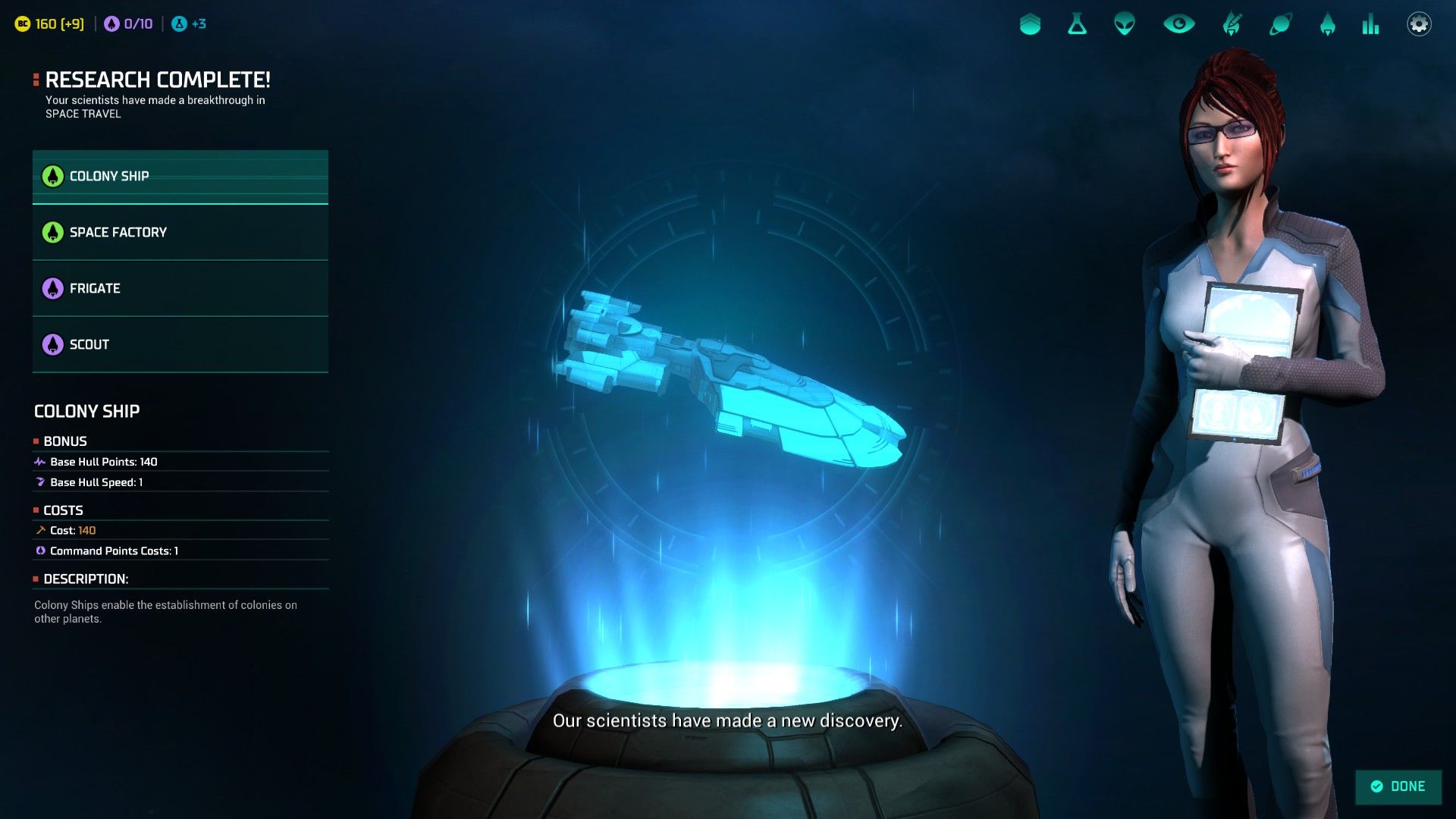 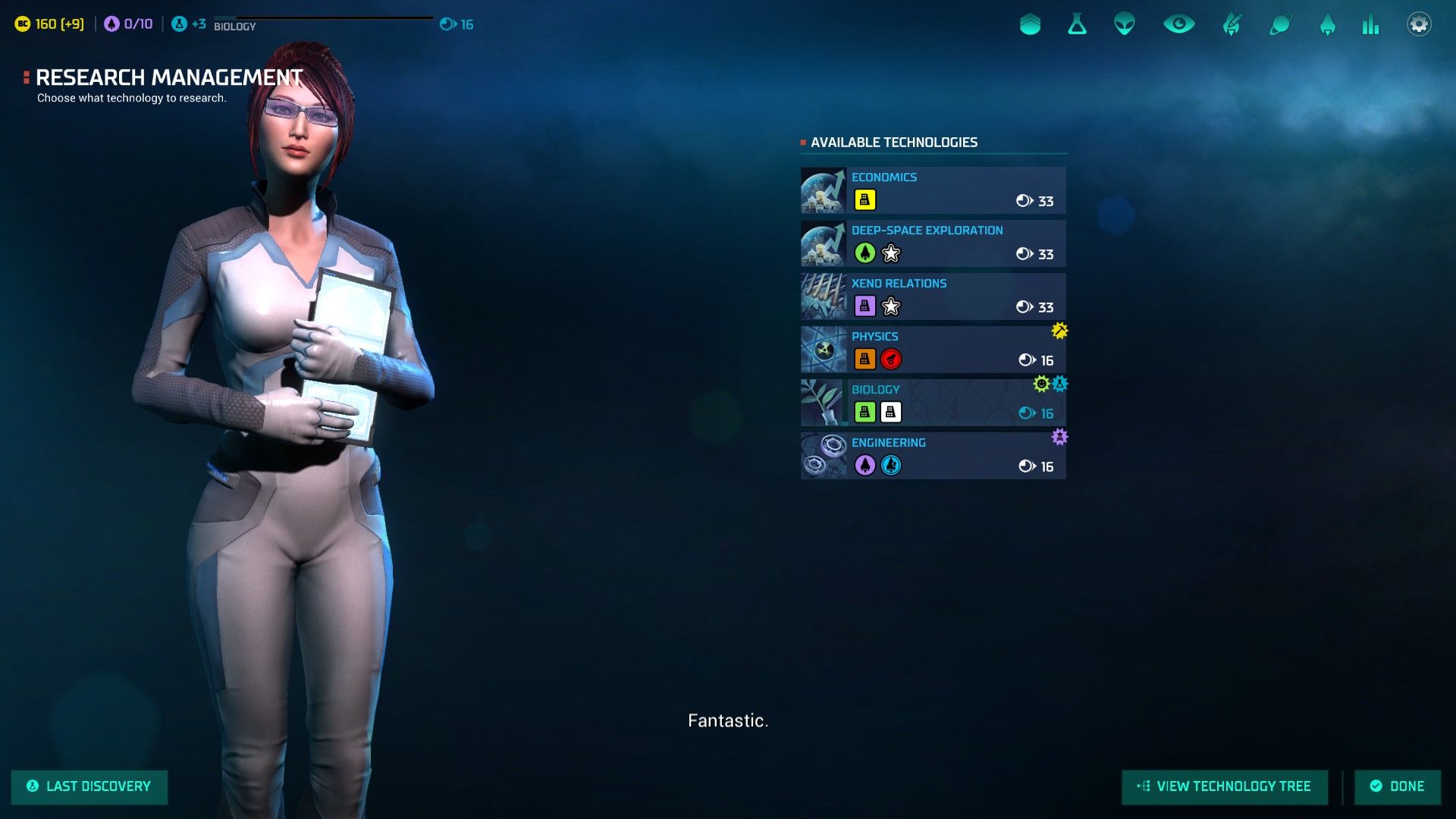 Finally, in 2315, a series of major breakthroughs paved the way for true FTL vessels and a major push out into space. Swift exploration ships and huge construction vessels fitted with atomic-powered drives could be constructed and navigate the conduits between stars, and it could even be possible to construct massive colony arks that could help pave the way for a human presence on new worlds. We also discover the Government tech concurrently due to the Human 'Diplomat' trait, which unlocks Research Labs (35 production cost, +2 RP on the planet, 2 trillion credits upkeep) and Government Support Facilities (bonuses to morale and security on non-capital planets due to local administration and maintenance of order there). 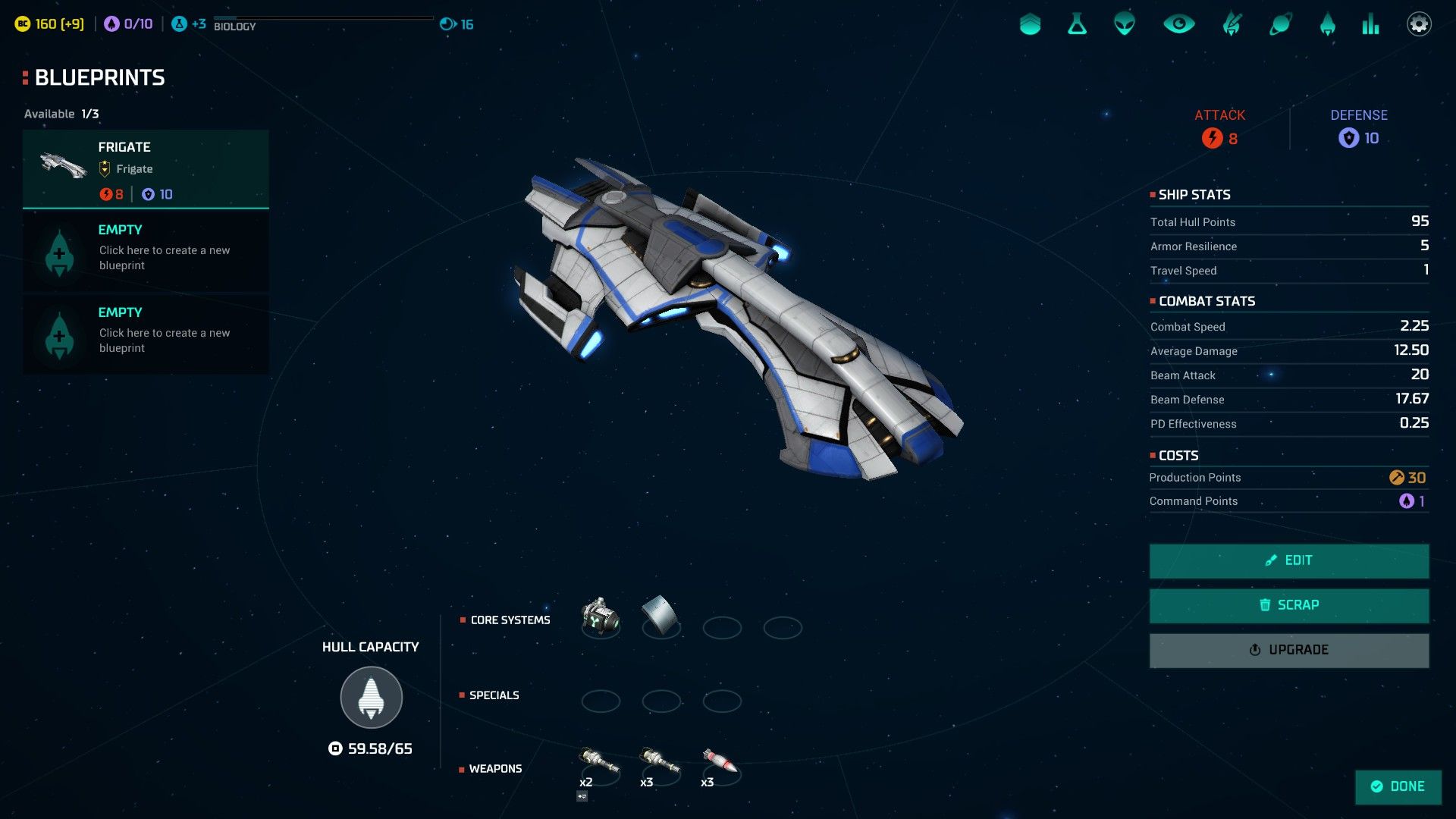 The Defense Department, meanwhile, draws up preliminary plans for a hypothetical space control vessel that could be fielded with current technology. This formidable vessel relies on three missile tubes along the centerline to launch long-range nuclear missiles as its primary armament, backed up by three laser turrets designed to engage enemies roughly in front of the vessel. Two more light laser turrets are designed to engage small, fast-moving targets at close range, providing defense against enemy missile fire. The entire ship is sheathed in several centimeters of titanium alloy as protection against enemy fire, radiation, and the rigors of faster-than-light travel. This is only a preliminary study, however, and alternate proposals may be accepted. The game will automatically generate fairly acceptable ship designs as you gain new technology, but these can be manually edited if desired. 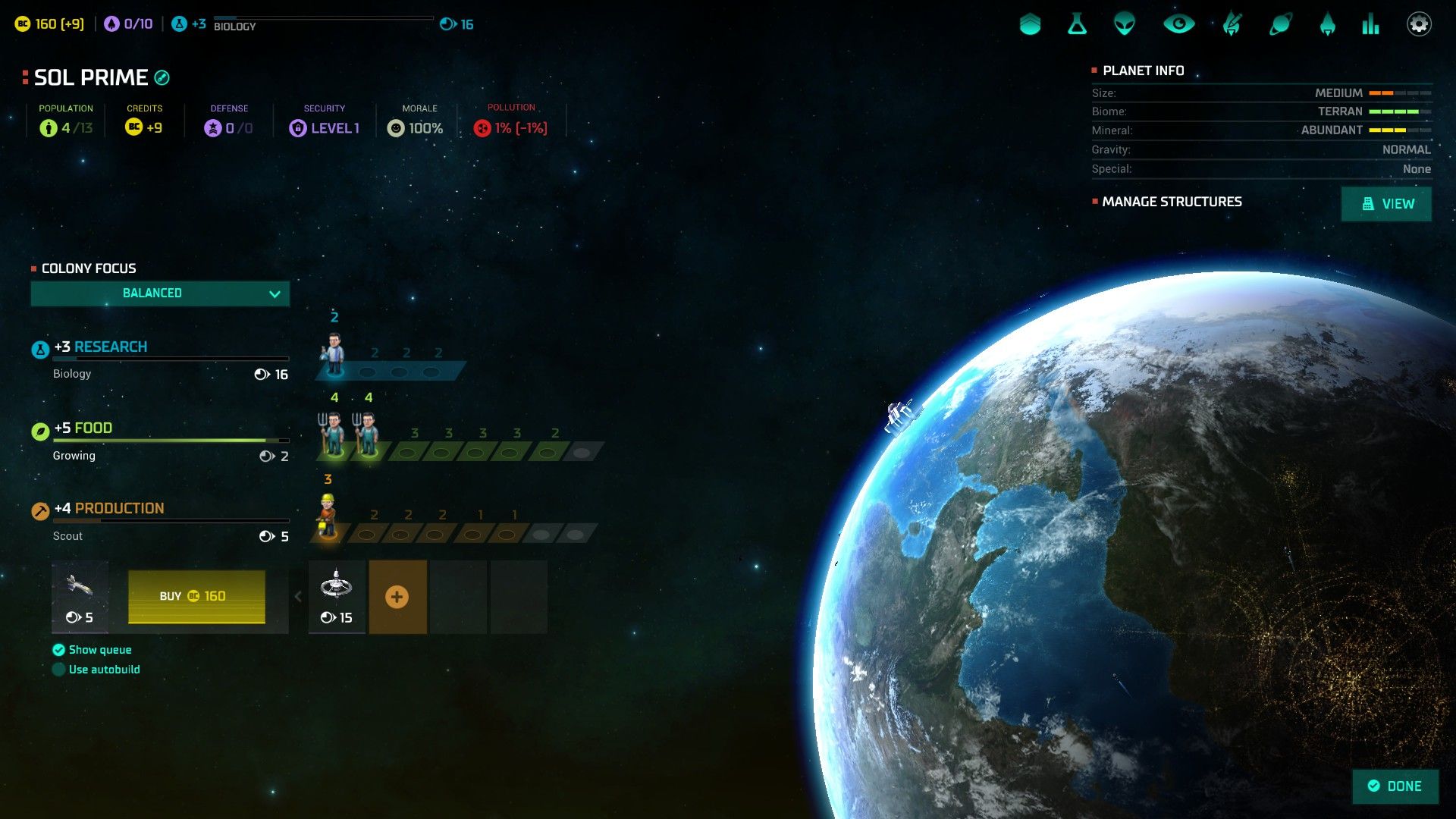 Even before the perfection of new FTL drives, significant investment had been underway in constructing the frame for Humanity's first FTL exploration vessel by Horizon Aerospace. Horizon was awarded a contract by the Republic's government to operate Humanity's first scout beyond the Solar System, and it completed construction by the end of the year. We had just enough money in reserve to buy the scout outright once we made this breakthrough, which saved us a few years of construction. 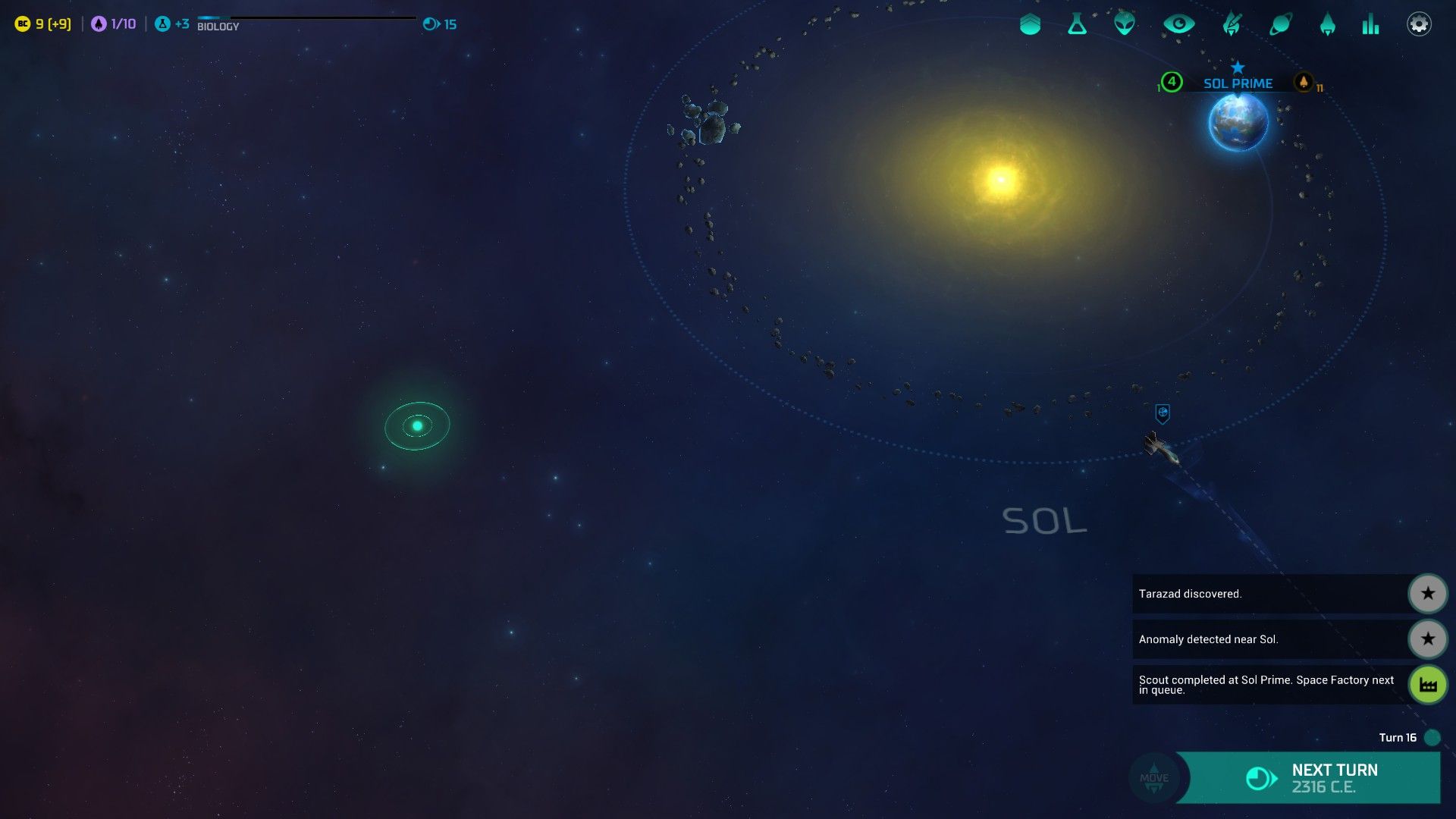 As the Werner von Braun set out on its maiden voyage to the edge of the system and the access point to one of the conduits between stars, it began to detect evidence of an unusual metallic object in the depths of Sol's Oort cloud by the end of 2316. Rather than immediately set out to explore a nearby star, it instead diverted for a slower-than-light voyage to investigate these unusual readings. You can occasionally discover anomalies at the edge of systems, which you can divert ships to investigate whatever little treasure the galaxy left behind for you. 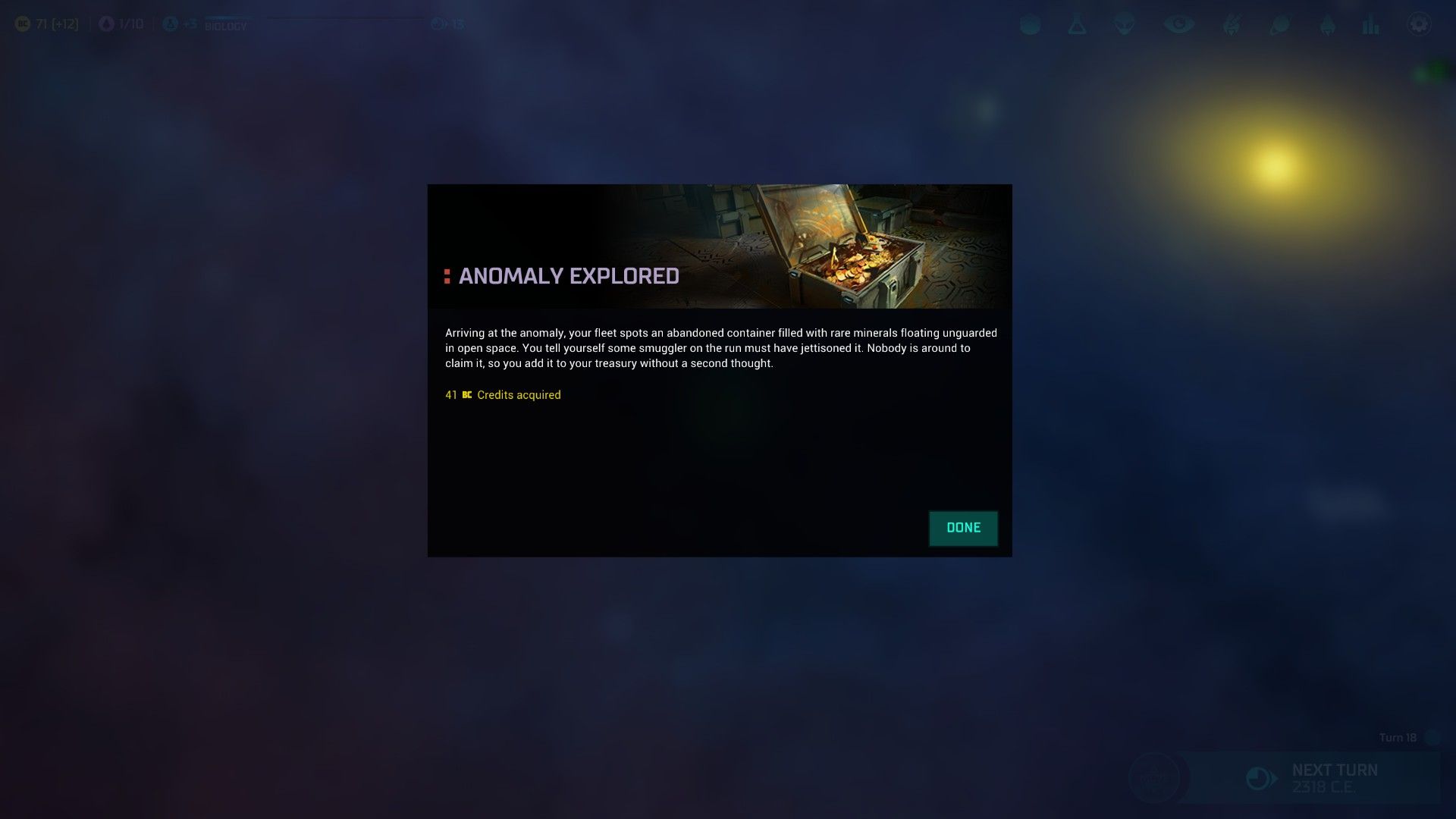 In 2318, the Werner von Braun finally reached its target, discovering an ancient cargo container pitted and scarred by tens of thousands of years of micrometeorite impact, marked with an indecipherable alien language. Inside the container was a vast load of ingots of refined metals and plates of high-tech ceramics, still preserved after all this vast period of time, worth many trillions of credits at current prices. The container was shoved on an intercept course with Earth, with the value of the cargo being split between the Werner von Braun's crew, Horizon, and the Republic, in accordance with the Republic's contract with Horizon. The Werner von Braun began its own slow course back to the point at which it could once again resume its mission of exploration. The Human Republic as of 2320 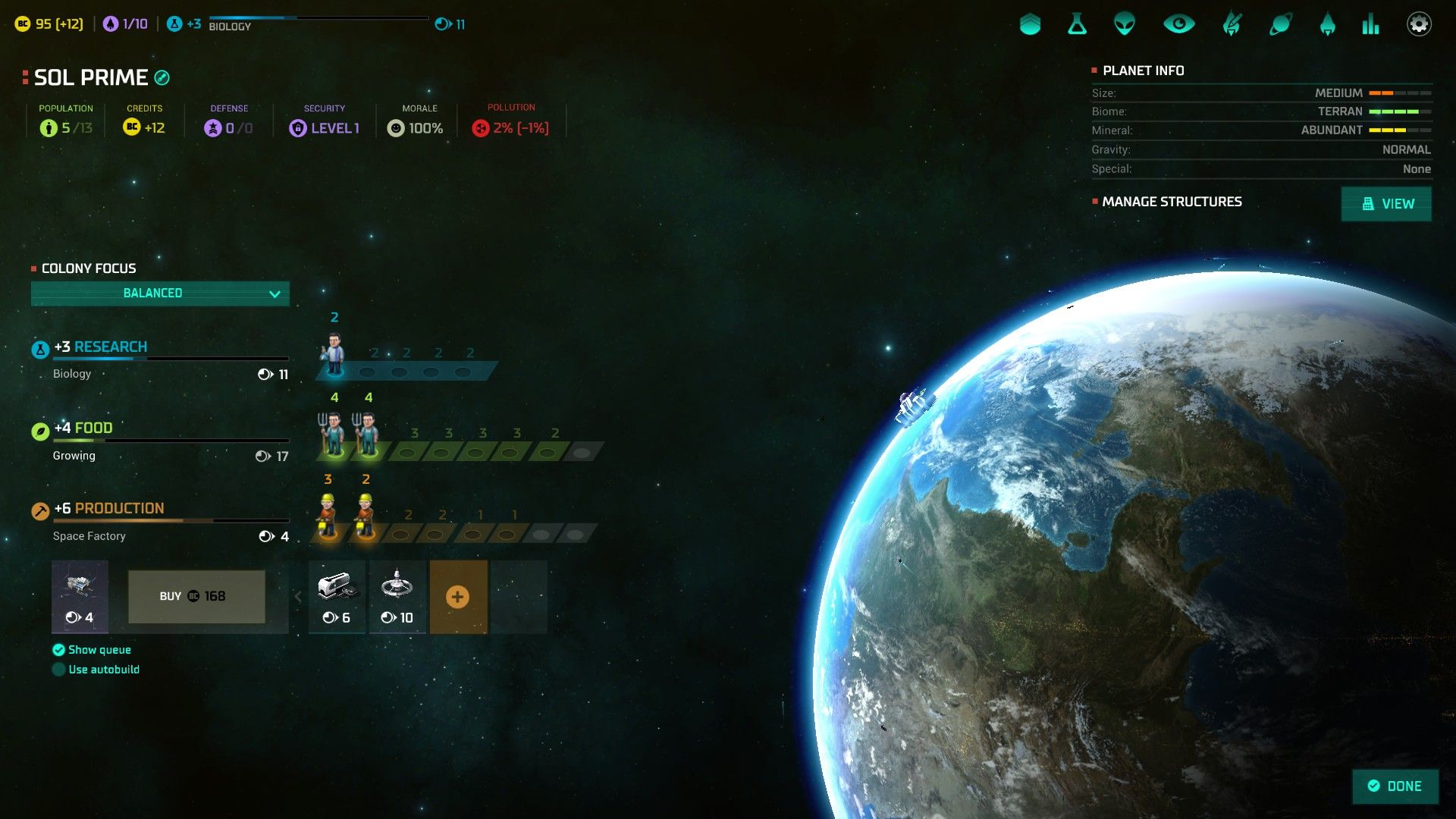 Earth passed a population of five billion in 2317, and has seen a growing heavy industry sector with its growing population. Approximately one hundred million are now employed in Earth's heavy industry, with mining expanded to some slightly less promising sites to feed the demands of factories for raw material. Companies have sunk investment into a massive deep-space construction craft, practically a major factory in its own right, while others have begun programs to modernise their research facilities with the benefits of the new technological renaissance on Earth. The military station about Earth has been temporarily mothballed while still only half-constructed, but work can easily be resumed where it left off when the legislature once again authorises new appropriations for it. 95 trillion credits are still available for investment, with an annual surplus of 12 trillion credits. You can push partly-completed items back in the production queue, where they will retain any progress on construction. Earth's current construction queue is 'space factory, research lab, half-completed starbase'. Only the first population unit on heavy industry on Earth produces a full 3 production- further factories need to rely on supply from mining sites that aren't the very best Earth has to offer. 2 industry per population unit is still acceptable, at least- with more than four units in heavy industry, productivity per worker drops off sharply and other fields start looking like a better deal. 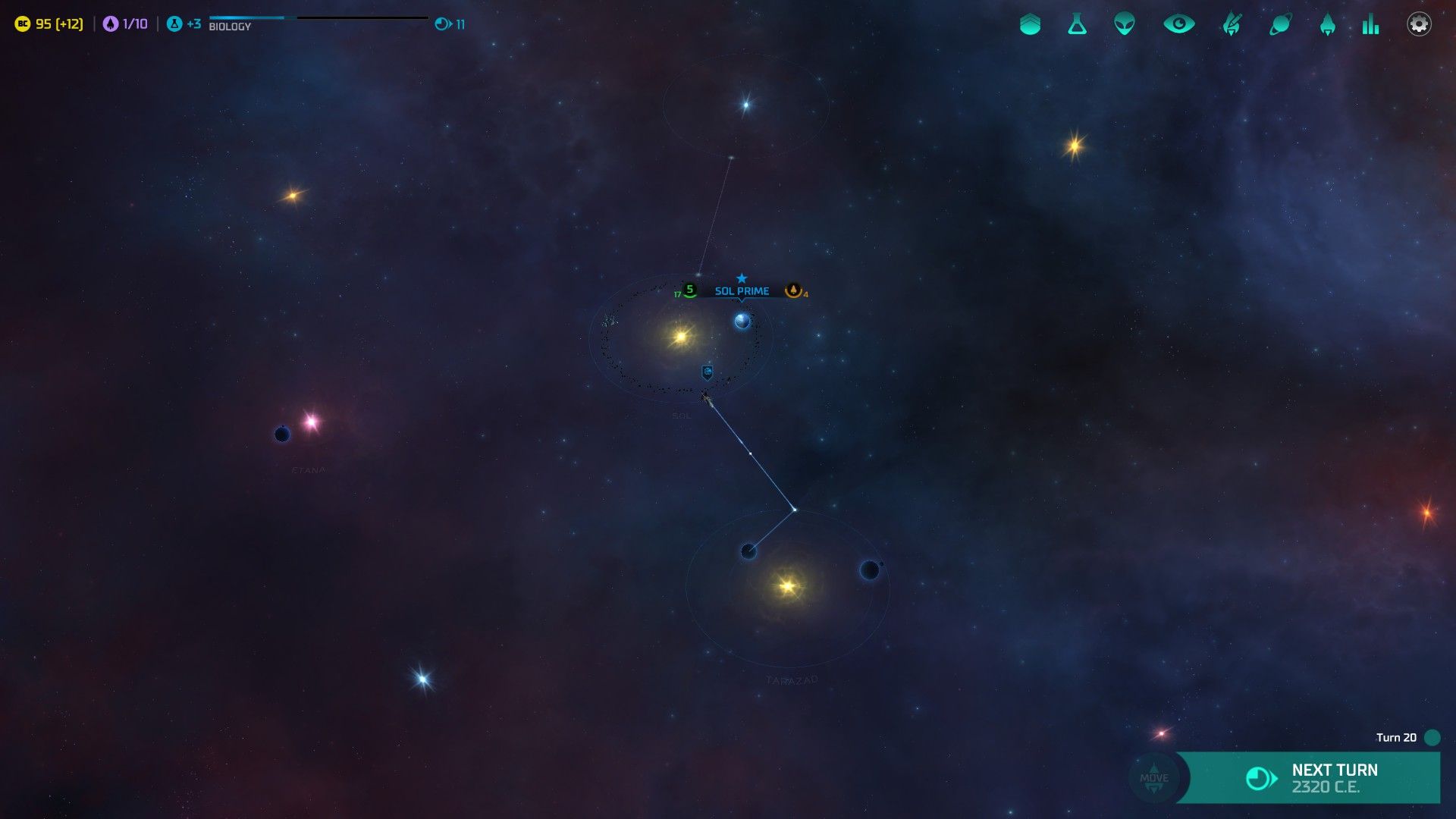 The Werner von Braun's time in the outer part of the Sol system has allowed it to make long-range observations of some of the bodies surrounding the nearby systems of Etana and Tarazad, although calculation of the conduits around a star and further details about its orbital bodies will take closer survey and investigation. You can observe how many things are orbiting a star from long range, but conduits are only revealed upon arrival at the system and specifics of the planets require individually investigating them. Proposals for the People of the Republic Asteroid Exploitation- Different firms have an interest in exploiting the asteroids, although the specifics of how they may be exploited vary. The most straightforward option, of course, would be the establishment of a series of mining operations throughout the asteroid belt, helping deliver the impressive wealth in metals and minerals locked in the asteroids to Earth. Alternatively, investors could buy up asteroids as a convenient place to establish research stations in a low-G environment far from any population centers, allowing for experiments that would be difficult to perform on Earth or too dangerous to perform there to go forward. Please vote between asteroid mining (+2 trillion credits/year) or asteroid labs (+2 RP, -2 trillion credits/year) for the asteroid belt. Agricultural and Biotech Investment- It is anticipated that when current biotech research bears fruit, it will allow small sealed habitats that can be used for study of the more hostile portions of the globe, such as the seafloors and Antarctic regions, as well as for better control of specialty agricultural environments. It should also allow larger-scale industrial hydroponics facilities that can grow significant crops with a relatively limited workforce. Investment is expected to focus more on sealed habitats than industrial-scale hydroponics, at least at first. Biology will unlock Biospheres (45 production cost, +1 food, +1 RP, 1 trillion credits upkeep) and Hydroponic Farms (60 production cost, +2 food, 2 trillion credits upkeep). Please vote on the order of implementation, although I suggest doing Biospheres first. Humanity now reaches for the stars, with strange new evidence that others have arrived there first, at least in the distant past. New technology promises to bring new prosperity, and the outlook on Earth is optimistic.
|
|
|
|
Defense Department Procurement- Initial Frigate Designs Internal studies in the Defense Department have produced a preliminary design for the Republic's warships, based around three nuclear missile tubes, three laser cannon, and a pair of light defensive laser cannon turrets. That said, proposals from naval architects within the Defense Department and aerospace corporations for alternate designs for final approval will be considered. Spaceframe, life support, armor, electronics, drive systems, and other essential systems take up all but 575 tons of the available displacement on any vessel that can be designed under current circumstances. A hull bare of everything but drive and armor will cost 10 production, so that's our baseline cost. 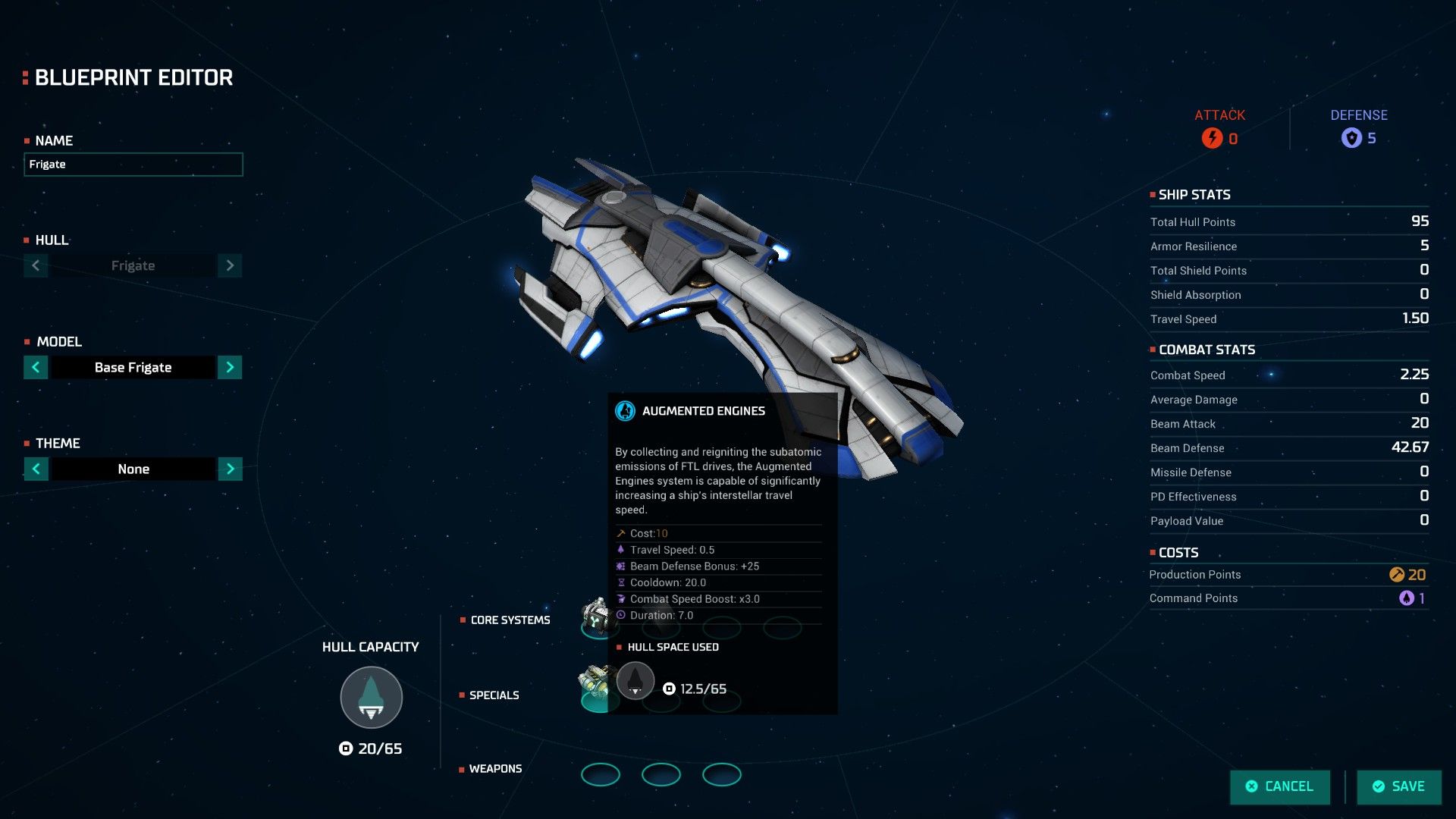 Rebuilding the drive systems for greater output could take up 125 tons of the available displacement, greatly cutting into the space for weapons, but could result in a ship with greater maneuverability in combat and potentially slightly faster travel between stars. This would also cost 10 more production. 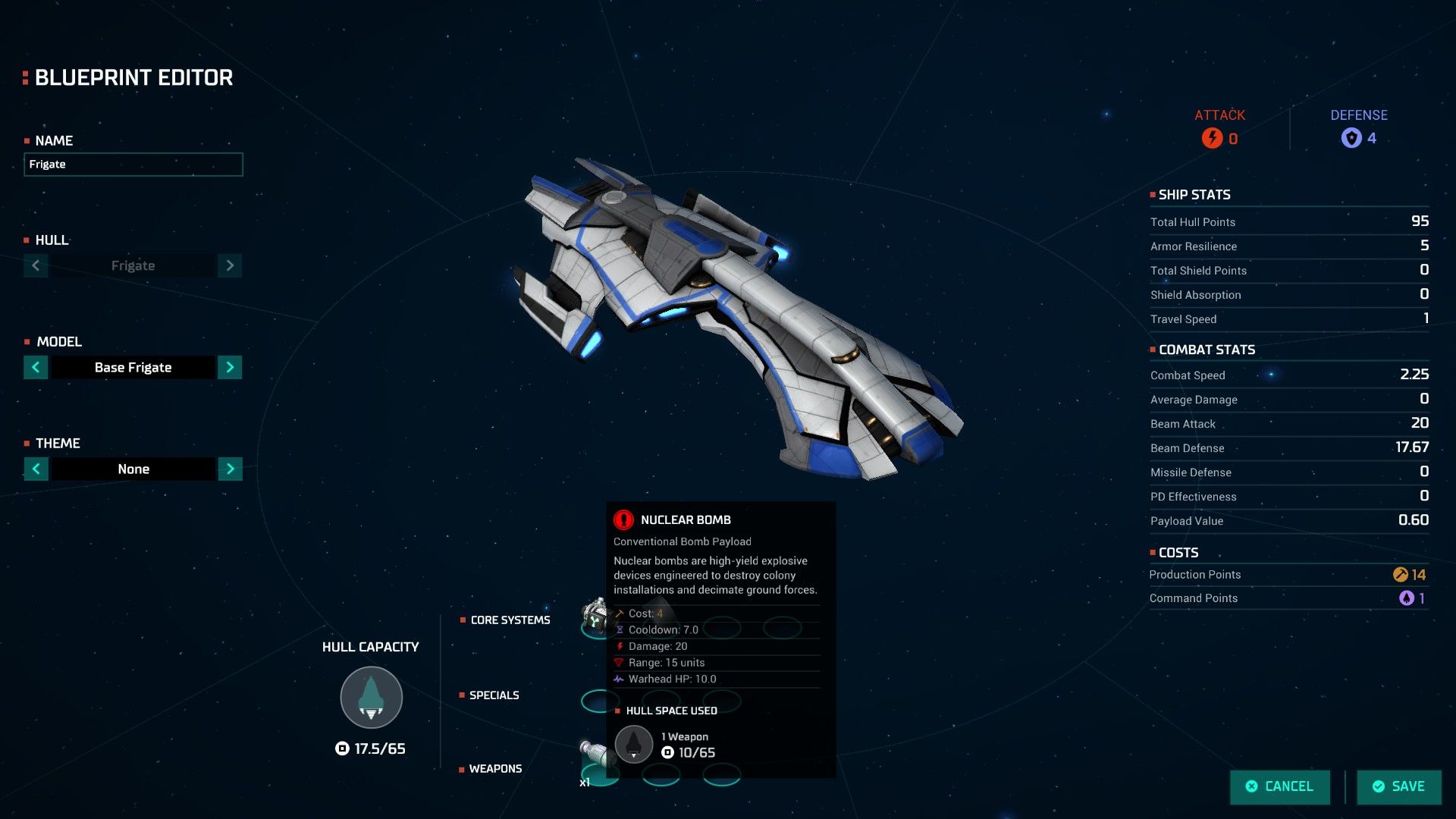 Available crew and targeting systems on the spaceframe limit practical designs to no more than three distinct sets of weapons- more than that would overwhelm effective command and control. It could be possible to design nuclear warheads for surface attack, taking 100 tons available displacement per ordnance bay, but the Defense Department is more interested in dedicated space control craft for the moment. One bomb bay costs 4 production to install. 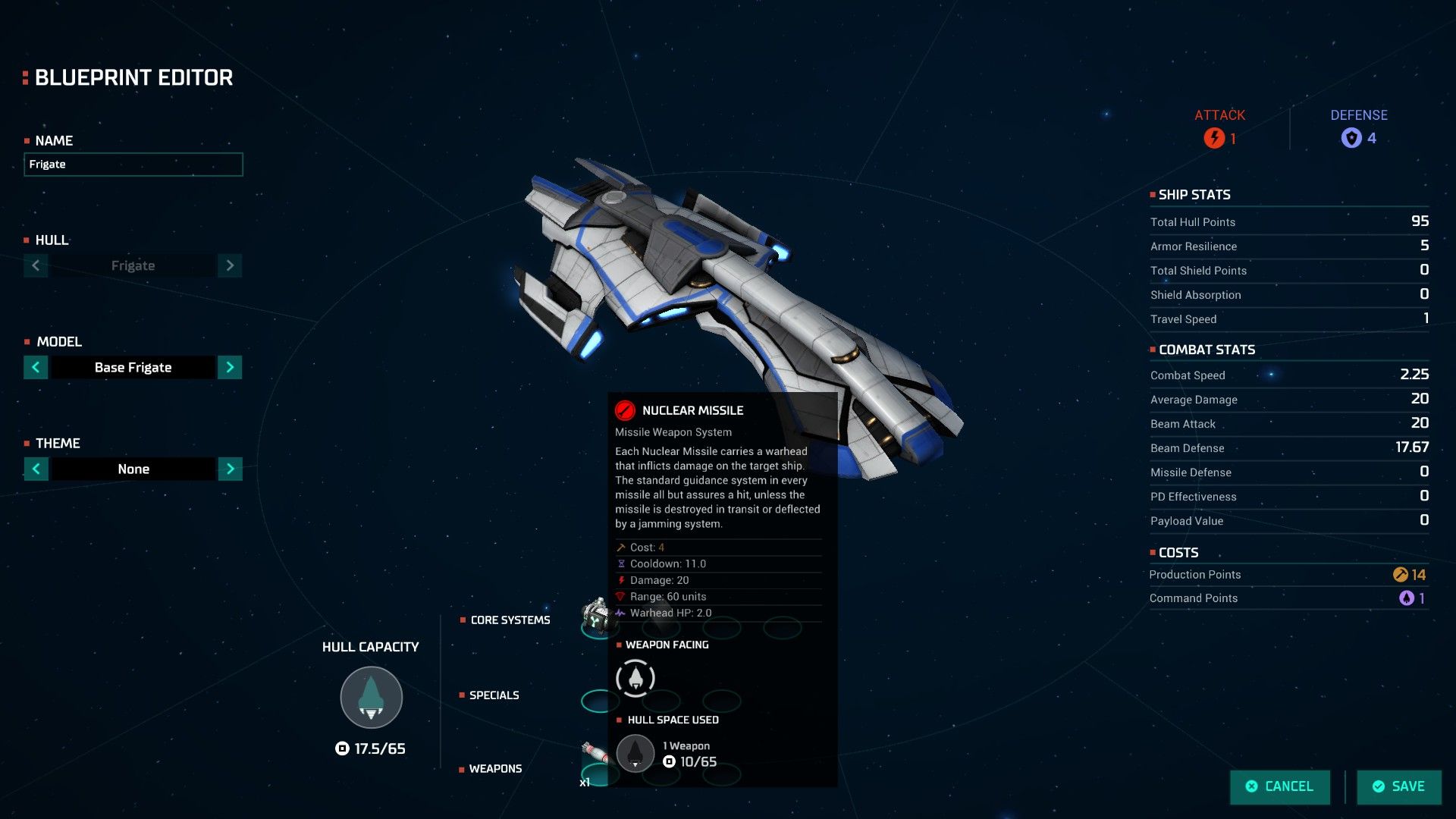 Nuclear missile tubes are anticipated to be the mainstay of the offensive firepower of the new vessels, striking with great accuracy to inflict heavy damage via proximity detonation near a target. Each tube and its ammunition will take 100 tons of displacement. The only drawbacks of these weapons are their relatively slow rate of fire, their slow travel time compared to lasers, and their potential vulnerability to having their missiles shot down by the point defense of their targets. Each nuclear missile tube costs 4 production to install. 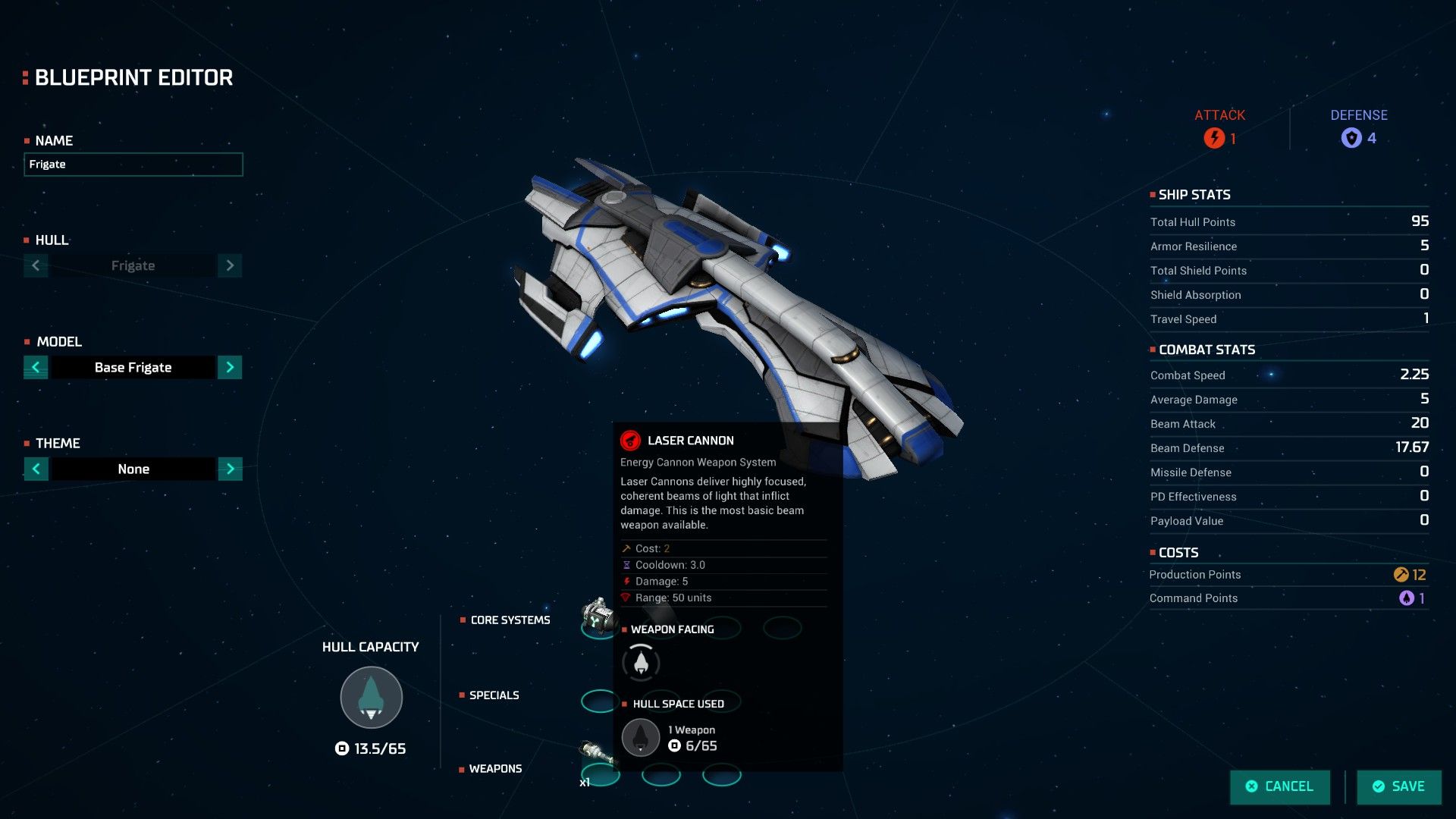 Laser cannon are versatile and reliable weapons with several possible configurations. Although they can potentially have less than perfect accuracy due to targeting errors against enemy targets, they are immune to enemy point defense and can be expected to remain serviceable even if missiles are rendered useless by enemy defenses. Although the estimated potential damage of a laser cannon is nearly a quarter of that of a nuclear missile and the range of engagement is nearly as high, loss of cohesion over range renders laser cannon far more effective at short range and renders the outer envelope of their range largely a theoretical matter. Front- or rear-mounted turrets with limited traversal could each be installed in a displacement of 60 tons, while paired weapons in broadside casemates would take 75 tons of displacement. Dorsal or ventral turrets with a 360 degree range of traversal would take 90 tons of displacement, while light turrets useless for offensive purposes but optimised for point defense against fast targets would take 20.4 tons of displacement each. Point defense mods drastically reduce range, reduce damage, increase accuracy and fire rate, and let the weapon fire automatically against incoming missiles. Front- or rear-mounted laser cannon cost 2 production per turret, laser cannon broadsides with one gun firing either to the left or right at any given time cost 3 production per gun, 360 degree cannon cost 4 production per turret, and point defense mounts cost 1 production per turret. Proposals for ship designs with current technology will be considered in the Defense Department for future implementation when a space naval force is authorised by legislative appropriations. Feel free to submit new designs using these guidelines for space usage, or to vote on designs submitted by others (or the default design). nweismuller fucked around with this message at 08:55 on Sep 28, 2016 |
|
|
|
ProfessorProf posted:With the currency symbol reading 'BC', shouldn't it be billions of credits, not trilliions? It is explicitly meant to be 'billion credits' since Master of Orion 1- but given that I rescaled assumed size of population units in Master of Orion 2 from '1 million' to '1 billion', I applied the same rescaling to currency values.
|
|
|
|
Xenocides posted:Texas Class The proposed Texas Class is over displacement by one missile tube or bomb bay. Either cut down missile tubes to 4 or lose the bomb bay, please.
|
|
|
|
From within the Chiefs of Staff: "So you mean to tell me that the proposal with the most legislative support for when we called for a new dedicated space control vessel is a ship that can only do missile engagements, will lose in missile duels with our original proposal, and will do this for a mere 23% increase in price? This is a boondoggle of the highest proportions! Our entire mission with the design is to win space engagements!" Internal support within the Chiefs of Staff favors the Texas, Arbalest, or Lancer proposals over the Archer. In general, the Chiefs of Staff are reluctant to rely on designs that entirely sacrifice missile capacity at this point, as, barring strong opposing point defense, missile launch is likely to be the most powerful component of our offense. nweismuller fucked around with this message at 21:44 on Sep 28, 2016 |
|
|
|
I am experimenting with running a MoO2 LP in parallel, for those who wanted to see my custom race and just what shenanigans it can get up to: http://forums.somethingawful.com/showthread.php?threadid=3792622 This might slow updates somewhat between either LP, but I believe I should be able to juggle both.
|
|
|
|
TheGreatEvilKing posted:How hard is it to change ship designs on enemy contact? You can whip up new designs at any time, although at this time we're limited to three active classes of warship. Because production switching isn't a thing in this game, new designs would have to start construction from scratch.
|
|
|
|
Final decisions on investment on Earth and in the asteroids indicates that we shall build a series of labs in the asteroids and build biospheres before hydroponic farms on Earth. The Joint Chiefs have settled on the Arbalest proposal for a space control cruiser. (Yes, I know the ship size is called 'frigate' in-game, but a long-range warship of the only size we know how to build I expect to be initially called a 'cruiser'.) Preparing to play through update.
nweismuller fucked around with this message at 16:48 on Sep 30, 2016 |
|
|
|
To Hoist the Black Flag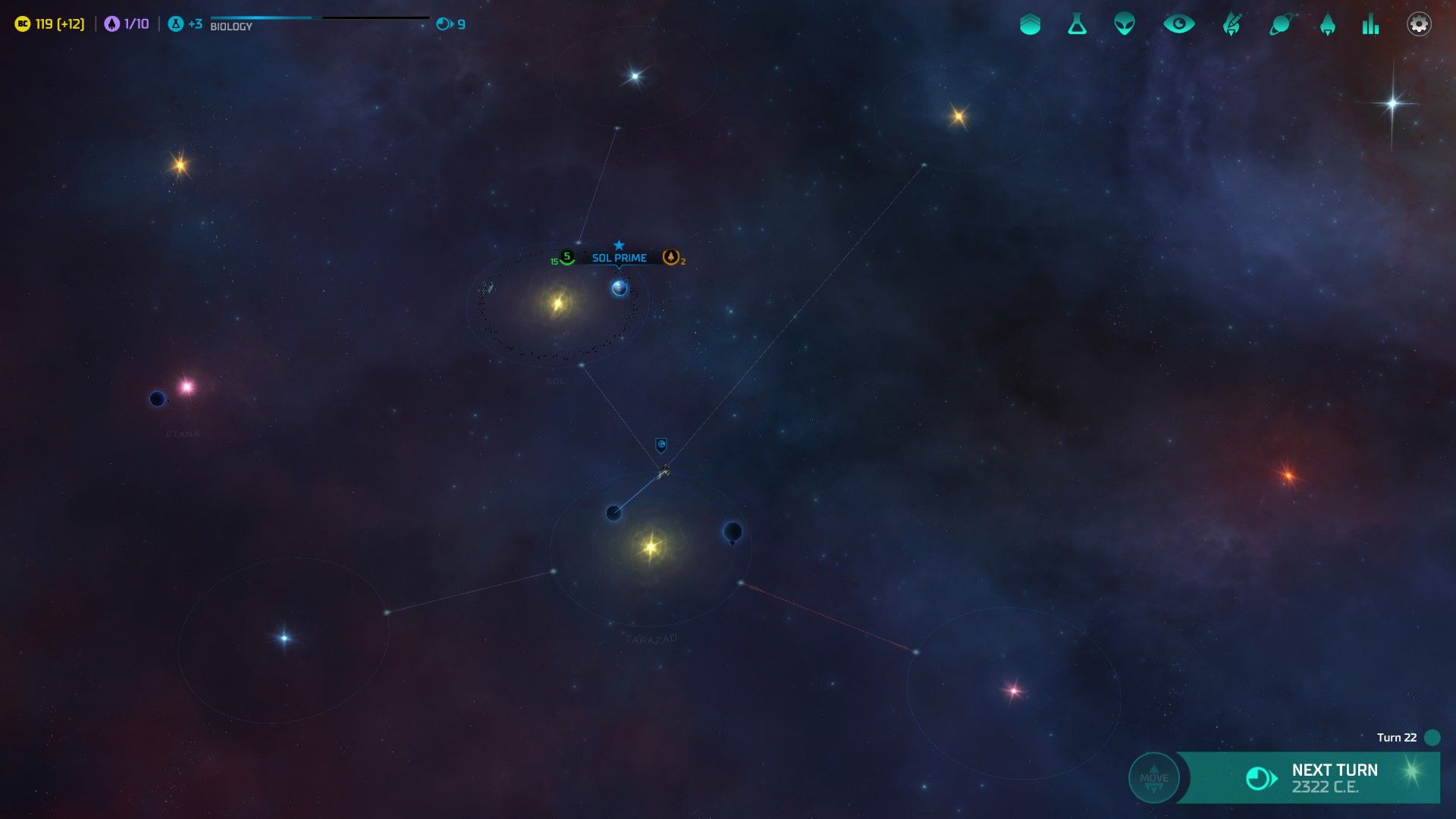 While work continued on Earth to prepare to further exploit the Sol system, the Werner von Braun continued on her voyage of exploration, arriving at the Tarazad system in 2322. Once there, the scout vessel's scientific crew was able to take measurements and calculate Tarazad's conduit linkages to other star systems, learning it connected to no fewer than four other systems, with two having conduits passing through the same point. One of these conduits, however was also calculated to be subject to immense gravitational shear stresses that would act on any object travelling along it faster than light, rendering its destruction en route a certainty. These findings were noted, and the Werner von Braun continued on to survey Tarazad's planets then press along the galactic rim to survey other stars. The red conduit reaching further spinward from Tarazad is an unstable conduit. It is impassable, and will remain so for the foreseeable future.  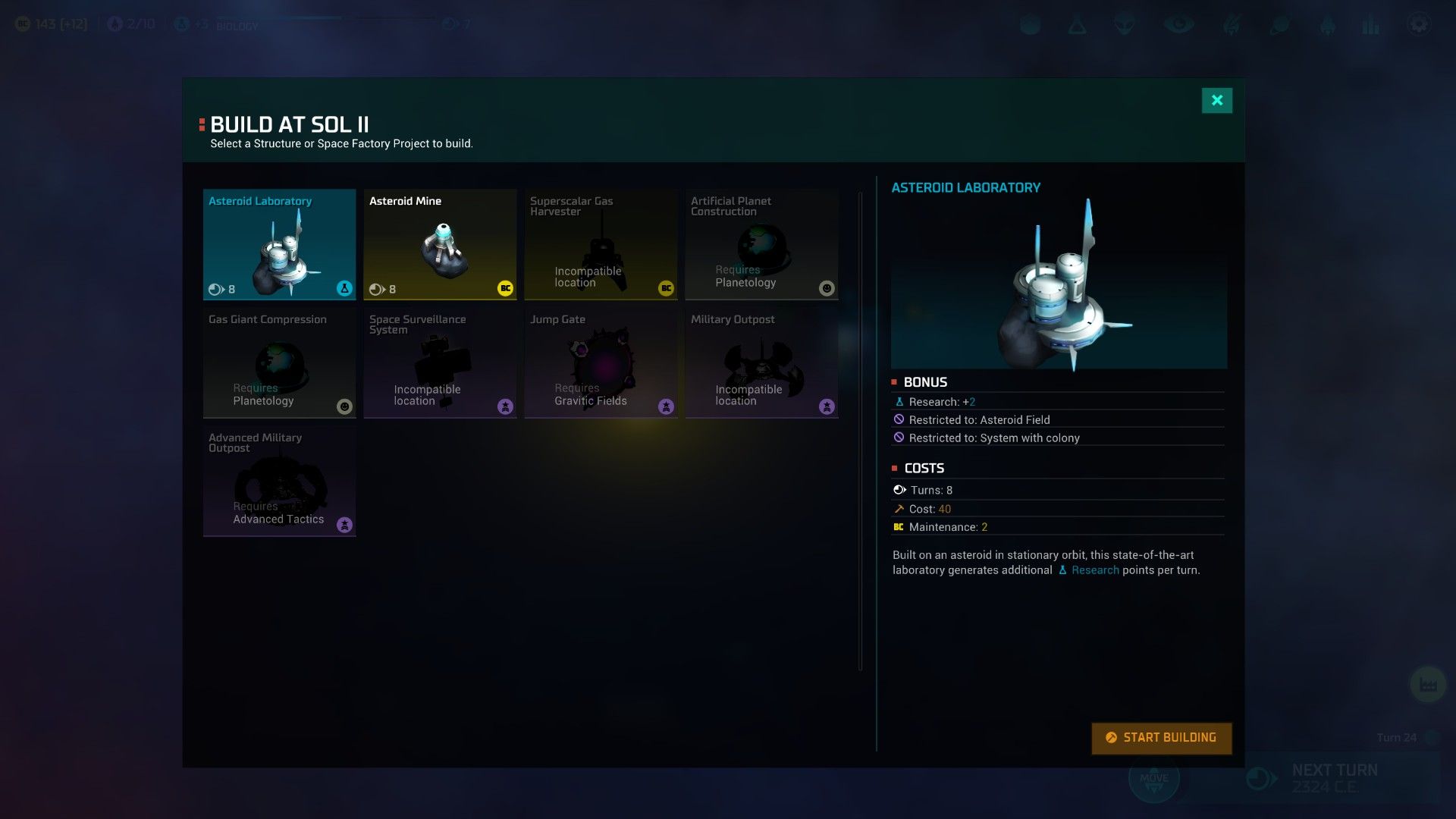 Two years later, a massive spaceborne engineering and construction vessel set out from Earth to begin work on constructing a series of laboratories sponsored in the asteroid belt. The low gravity in the asteroid belt could prove a boon to many forms of delicate research, the isolated location provides insulation against the effects of disastrous research accidents for riskier experiments, and the abundance of asteroids as raw material is a boon for weapons trials and experiments in mining and metallurgy. These labs prove a major investment for the corporations and military research groups sponsoring them, but may well be worth the effort. Even as these laboratories began construction, expanded research campuses on Earth with the best possible analytic equipment were being assembled, promising a new surge of innovation for Humanity. During the construction process in the asteroids, the disappearance of smaller supply vessels proved to be an ongoing problem- it seemed likely that criminal elements within Human society were making dedicated efforts to steal craft and thereafter disappear entirely from the awareness of most of Humanity. 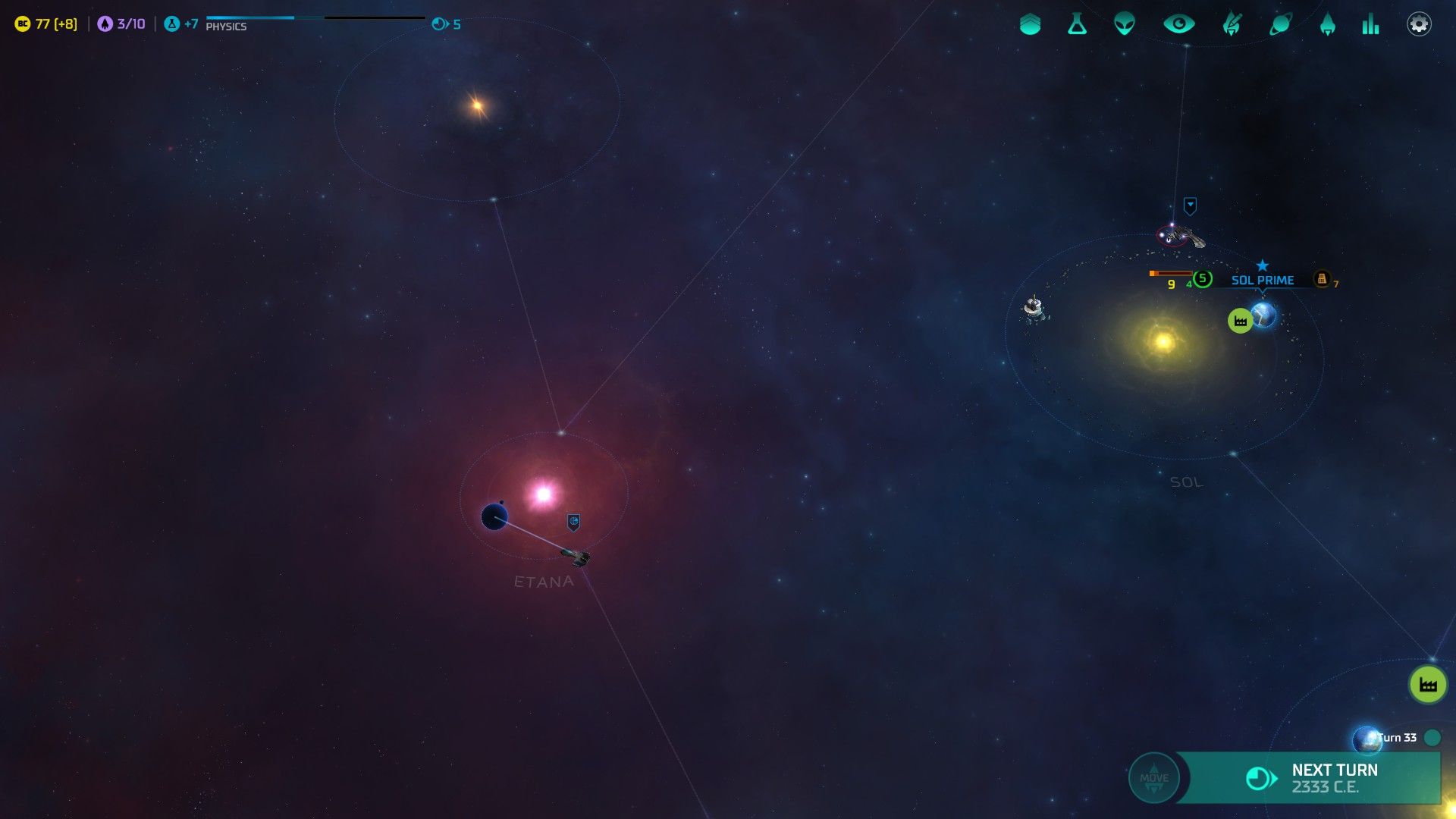  By 2333, both the laboratory complexes in the asteroid belt and the Arbalest, the namesake vessel for the new Arbalest-class space control cruiser class of the newly-formed Republic Space Fleet, had completed construction, and the Arbalest set forth to guard the new construction efforts on a fixed Space Fleet defensive installation at one of Sol's conduit points. The fixed installation should prove a formidable defensive structure, heavily-armed and heavily-armored, more than a match for the Arbalest when completed. The Arbalest herself was a swift and lethal cruiser with heavy, high-output drive systems, four long-range nuclear missile tubes, and a pair of light defensive laser turrets. Military Outposts prevent passage by other powers through their point, allowing territory to be locked down. Although strong defenses, especially if supported, they can be overwhelmed by larger fleets.  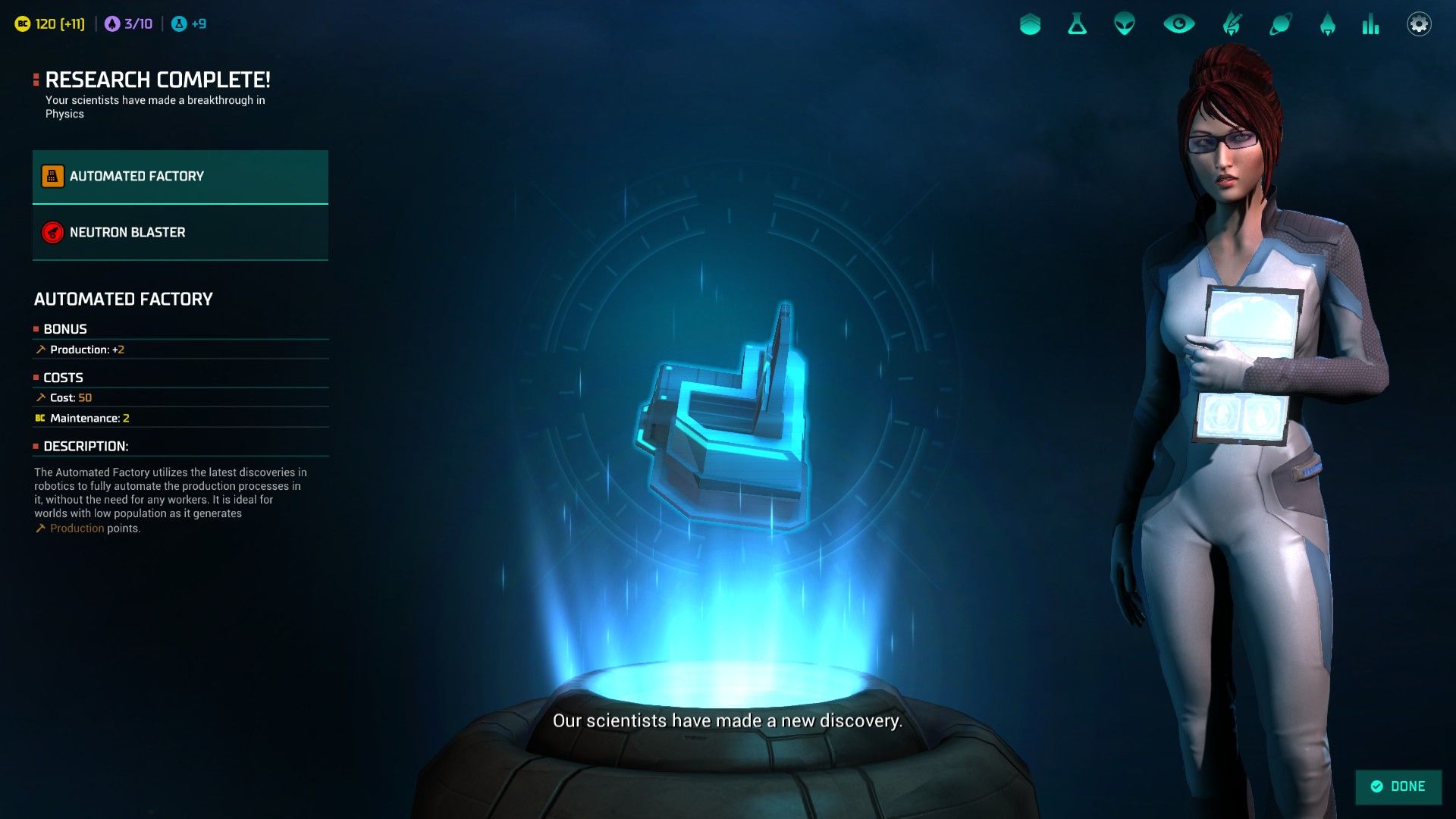 While work continued in space to exploit and defend Humanity's home system, research at home had opened new frontiers in biology, agronomy, industrial automation, and particle physics, with multiple applications available for exploitation by the beginning of 2338. Study of the more isolated and hostile regions of Earth now was a far more practical possibility, while notable improvements in both agriculture and industrial production could be made with new advances. What is more, the test prototype for a new neutron accelerator cannon has been completed in a Space Fleet weapons research facility in the asteroid belt, with proven improvements in power output to standard laser designs. Unfortunately, however, the new technology is too cumbersome to effectively scale down for defensive purposes. Also, like lasers, although their theoretical range is nearly equal to missiles, the practical range at which they deal effective damage is considerably less. Biology and Physics unlock Biospheres, Hydroponic Farm, Automated Factories, and Neutron Blasters for us. Biospheres are a cheap structure that modestly aids science and agriculture, while hydroponic farms and automated factories are dedicated basic agricultural and industrial structures, respectively. Neutron blasters, compared to lasers, deal 9 damage instead of 5 with the same rate of fire and range; neutron blasters are, however, somewhat bulkier and considerably more expensive. Lasers cost 1 and mass 2.04 for a point defense mount, cost 2 and mass 6 for a standard mount, 3 and 7.5 for a mount to either side, and 4 and 8 for a 360 degree coverage mount. Neutron blasters, by contrast, cannot be made point defense, cost 5 and mass 8 for a standard mount, 7 and 10 for a sides mount, and 10 and 12 for a 360 degree mount. 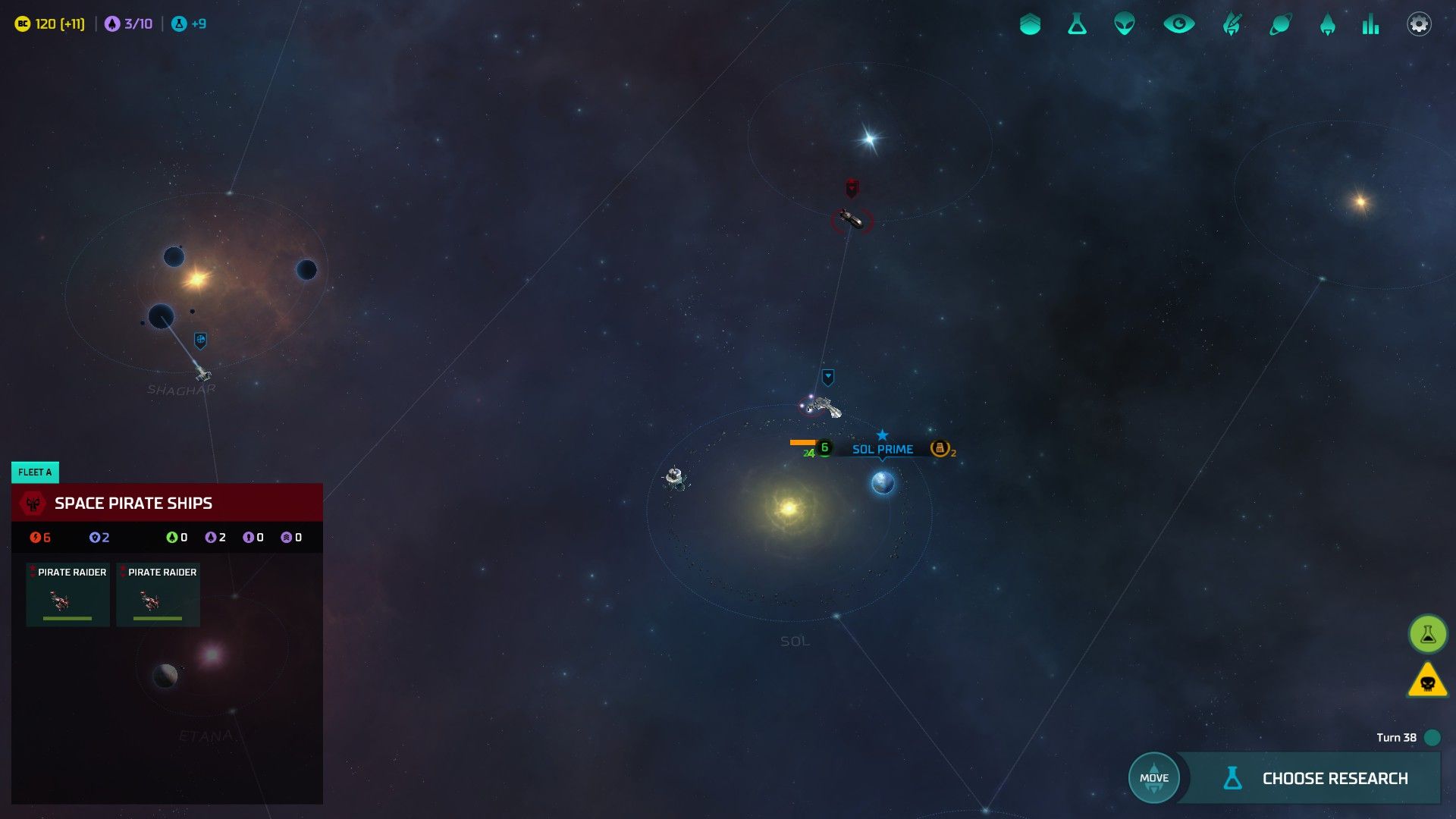 2338, however, was also a year that brought unnerving news to the people of Earth. A pair of vessels, each approximately the size of the Arbalest, was detected entering the conduit to Sol from the neighboring white star, and fragments of encoded radio traffic based on Human standards were picked up from their rough location. It seems unbelievable that the ragged self-exiled criminal elements who fled the Sol system could already have the industrial base to outmatch the Republic Space Fleet, however- it is almost certain that these vessels have made massive design compromises. Space Fleet General Command, on learning of this, provided orders to the Arbalest to defend Sol from hostile action at all cost until fixed fortifications can be established. The Human Republic and Known Space as of 2340  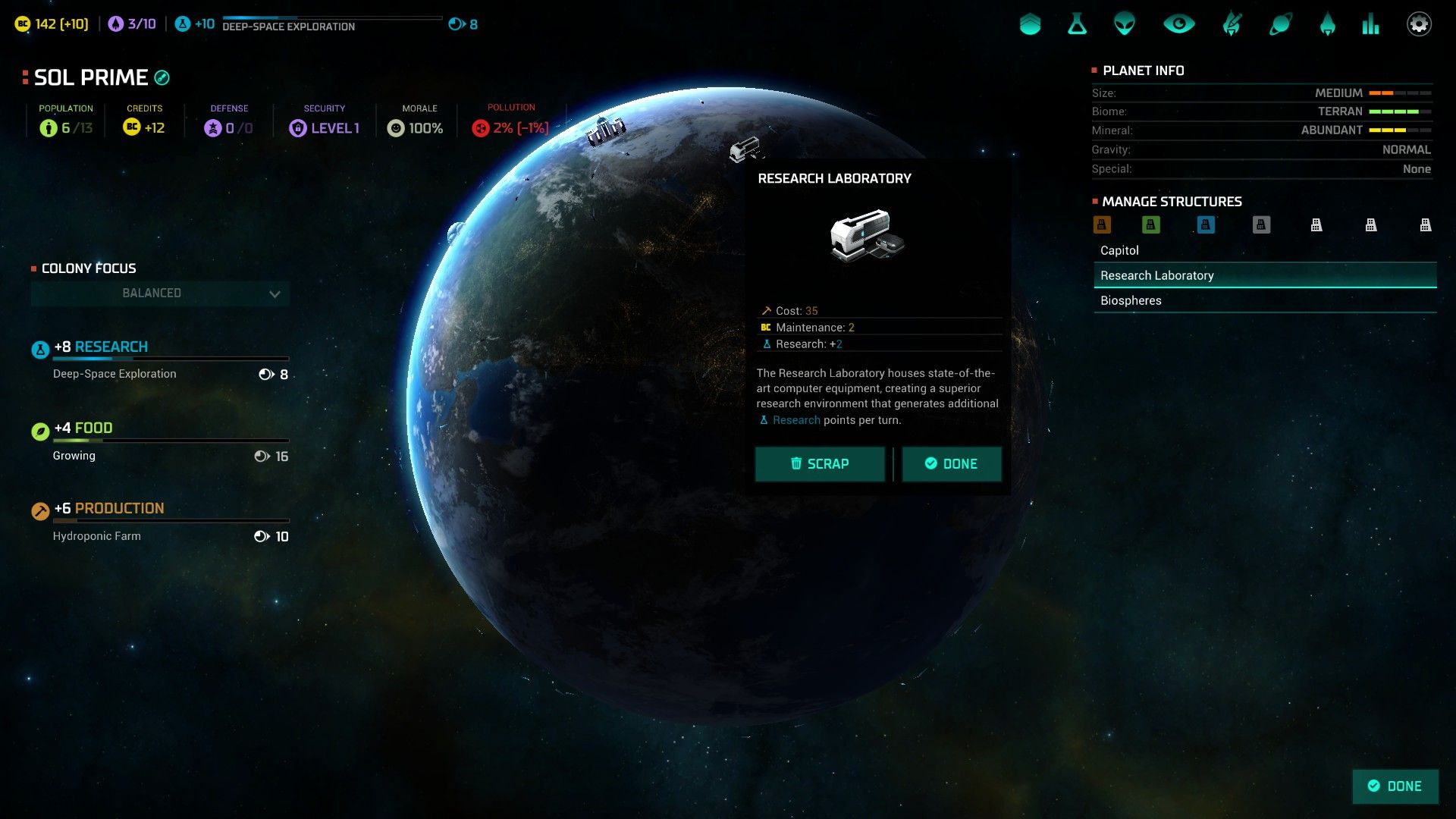 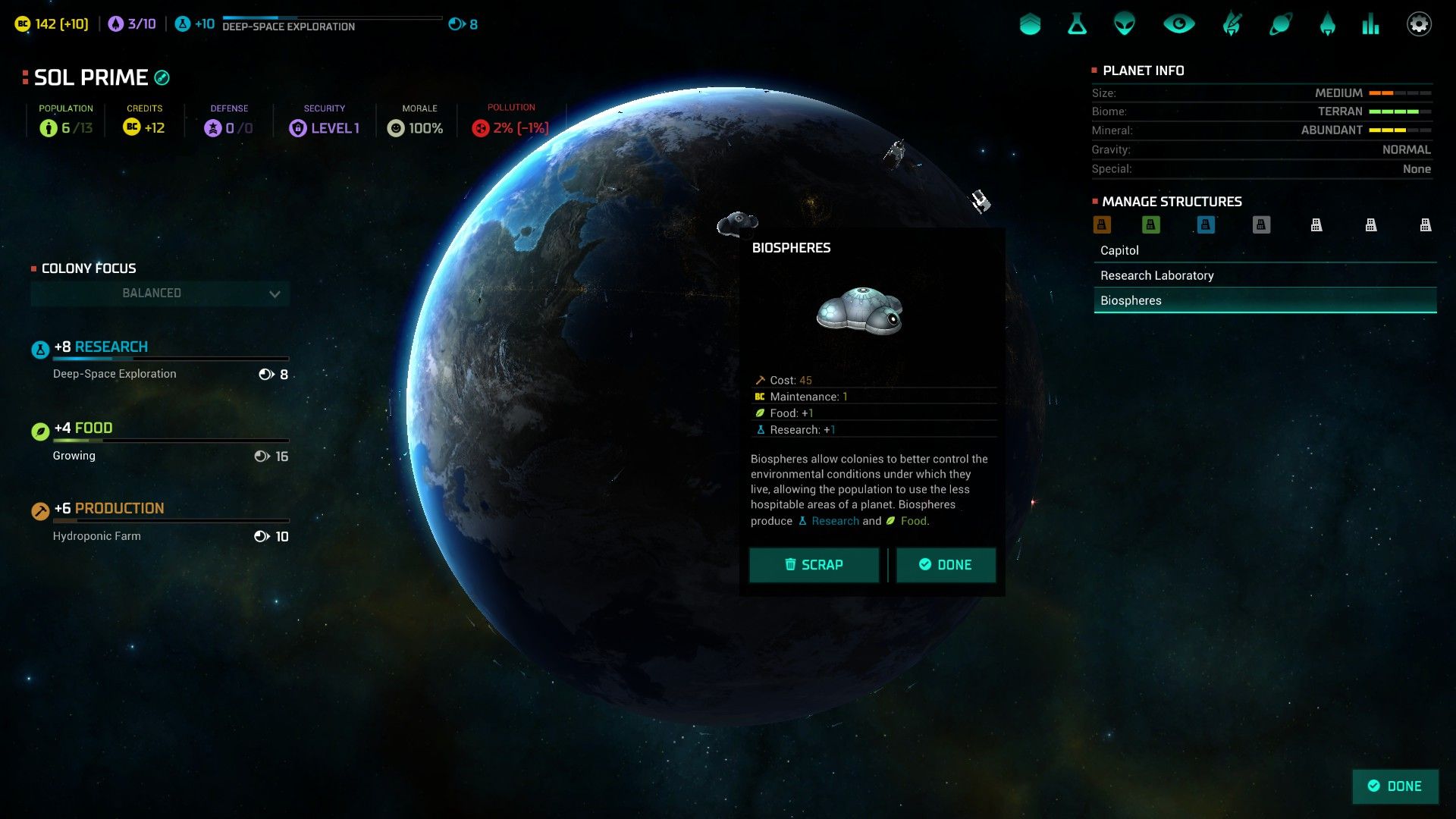 Over the past twenty years, Earth has seen major modernisation of its research and scientific facilities, as well as establishment of small permanent research bases using sustainable sealed environments in the Marianas Trench, the depths of Antarctica, and the deepest jungles and highest mountains on the planet. Use of sealed environment control has proved a boon, as well, for delicate specialty crops, insulating them from the vagaries of natural weather variations. The planet's population has passed the six billion mark within the past three years, with expanding scientific research and practical development communities in academia and business. The net effect of these changes and the new tests in the asteroids has been something of a golden age in innovation, with new ideas and new information coming far faster than a mere twenty years ago. The burden of maintaining more intensive infrastructure, although hardly overwhelming, has diverted a certain amount of investment to maintenance of existing capital stock, slowing accumulation of new capital for future investment. We've seen a dramatic increase in research rate, from 3 RP/year to 10 RP/year, but have seen cash income drop from 12 BC/year to 10 BC/year. An acceptable investment, I should think. 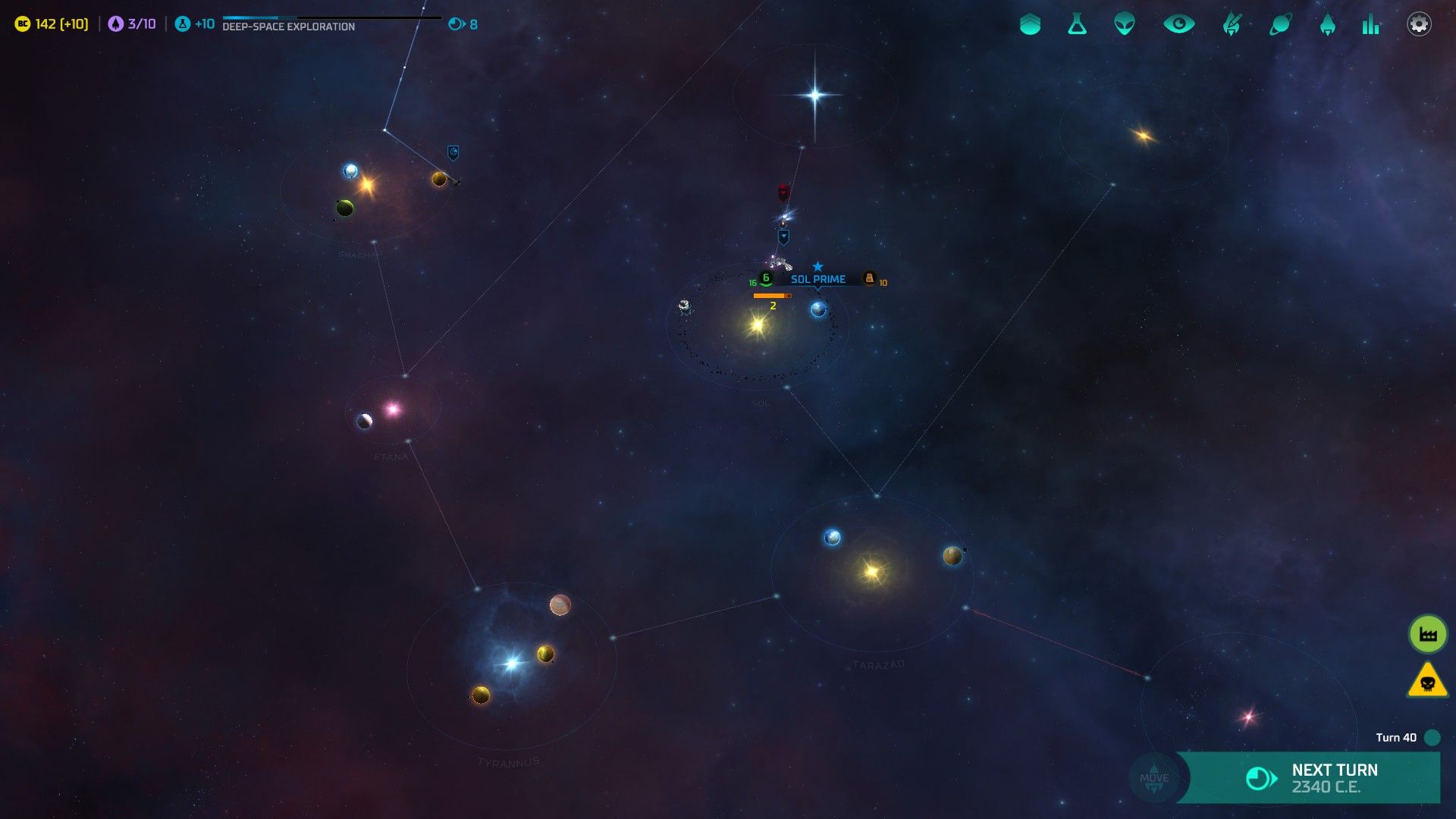 The exile flotilla approaching Sol is due to arrive in 2341, arriving a year before the fixed fortifications that could have defended against them shall be completed. The defense of Sol, ultimately, will be up to the Arbalest and the Arbalest alone. Nonetheless, morale in the Space Fleet is high, anticipating that they must surely enjoy the equipment advantage over the intruders. Traffic between Earth and the asteroids has made for the first large-scale civilian travel and trade in space- and the promise of future colonisation means this may only increase in the future. The Werner von Braun has surveyed four new systems, dispatching data back to Earth via fast communications probes, and already it has uncovered promising candidates for Human habitation.  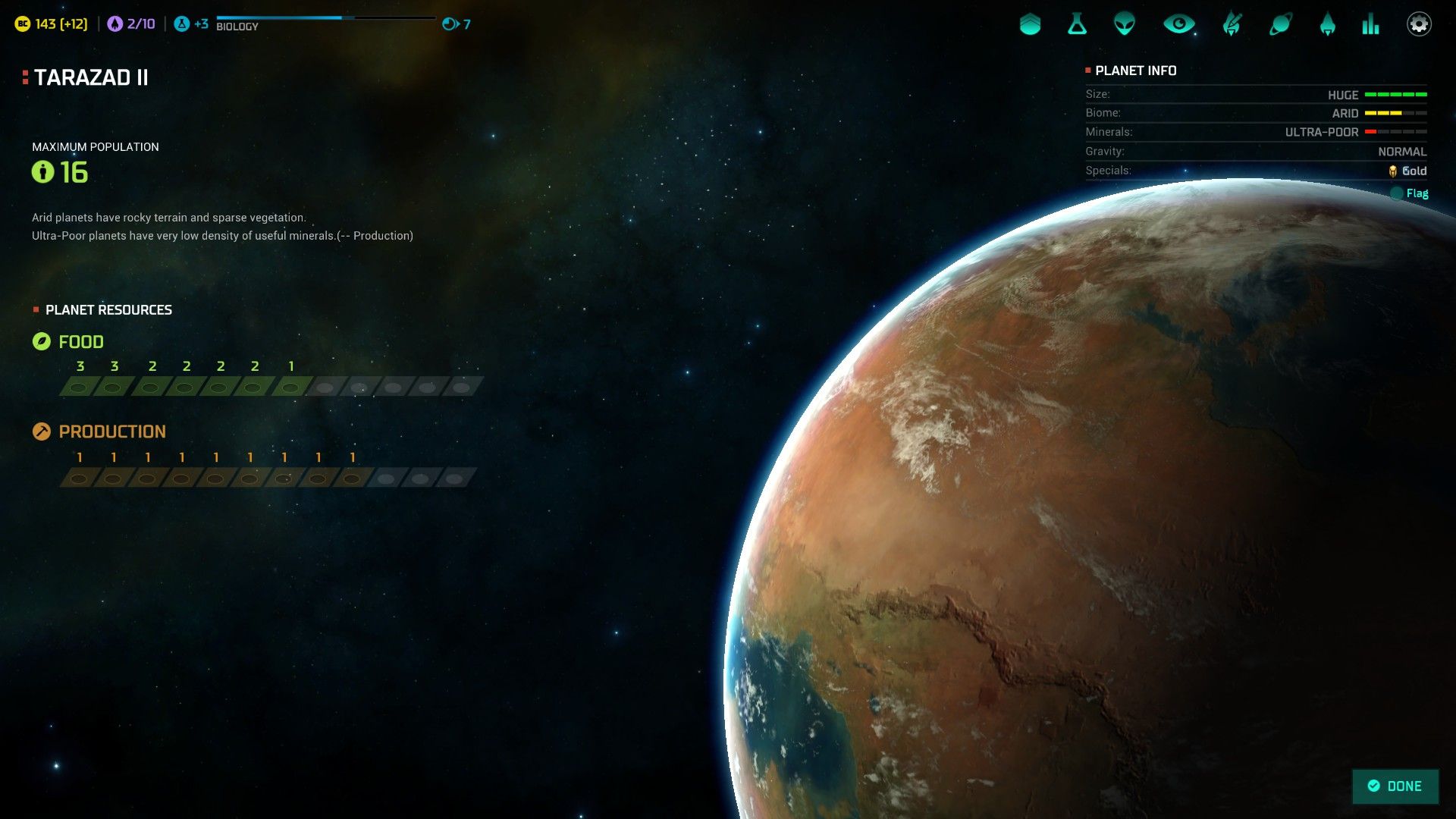 Tarazad hosts two promising worlds- with Tarazad Prime seeming particular valuable. Tarazad Prime is a very Earthlike world with its own complex and fertile biosphere, abundant water, and wide oceans, of a similar size and general mineral composition to Earth. Even more exciting, Tarazad Prime hosts an incredibly complex and abundant marine ecosystem that should allow for incredibly productive fisheries to be set up by even the earliest colonies there. Tarazad II is another life-bearing world, much larger than Earth, although extremely poor in heavy elements and industrial metals. Most life on Tarazad II is concentrated in the relatively rainy basins surrounding its small, highly salty seas, while vast dusty barrens and mountains dominate the terrain further away. Despite its general poverty in resources, there are significant gold deposits easily accessible on Tarazad II, which could be a valuable resource for mining and trade by new settlers. As can be seen, biome and mineral abundance influence the productivity of agricultural and industrial slots on the planet. The resource bonus of +2 food for seagrass or +2 BC for gold is immediately added to the annual output of any colony on the planet, and can make a valuable boost for infant colonies. 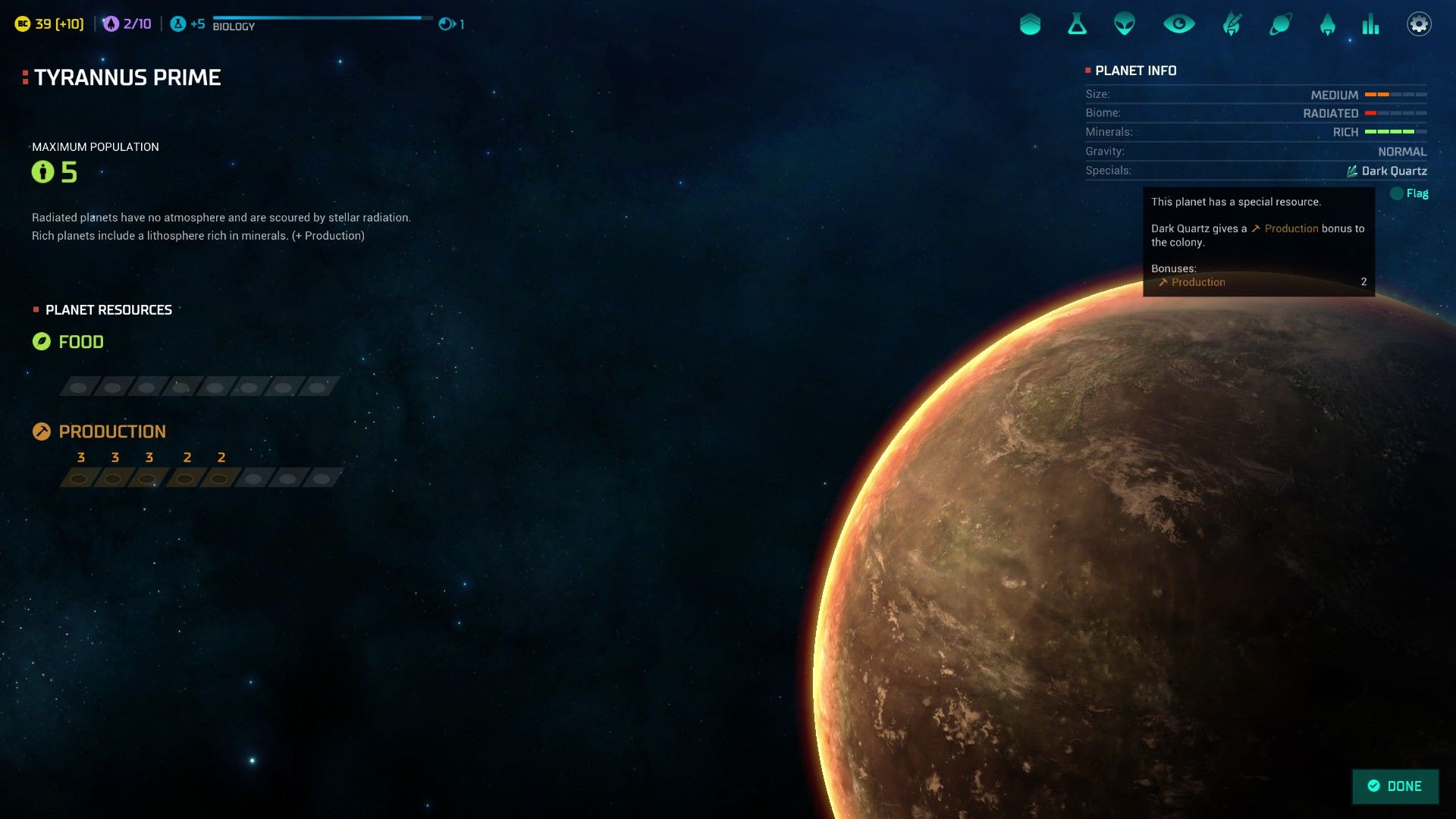  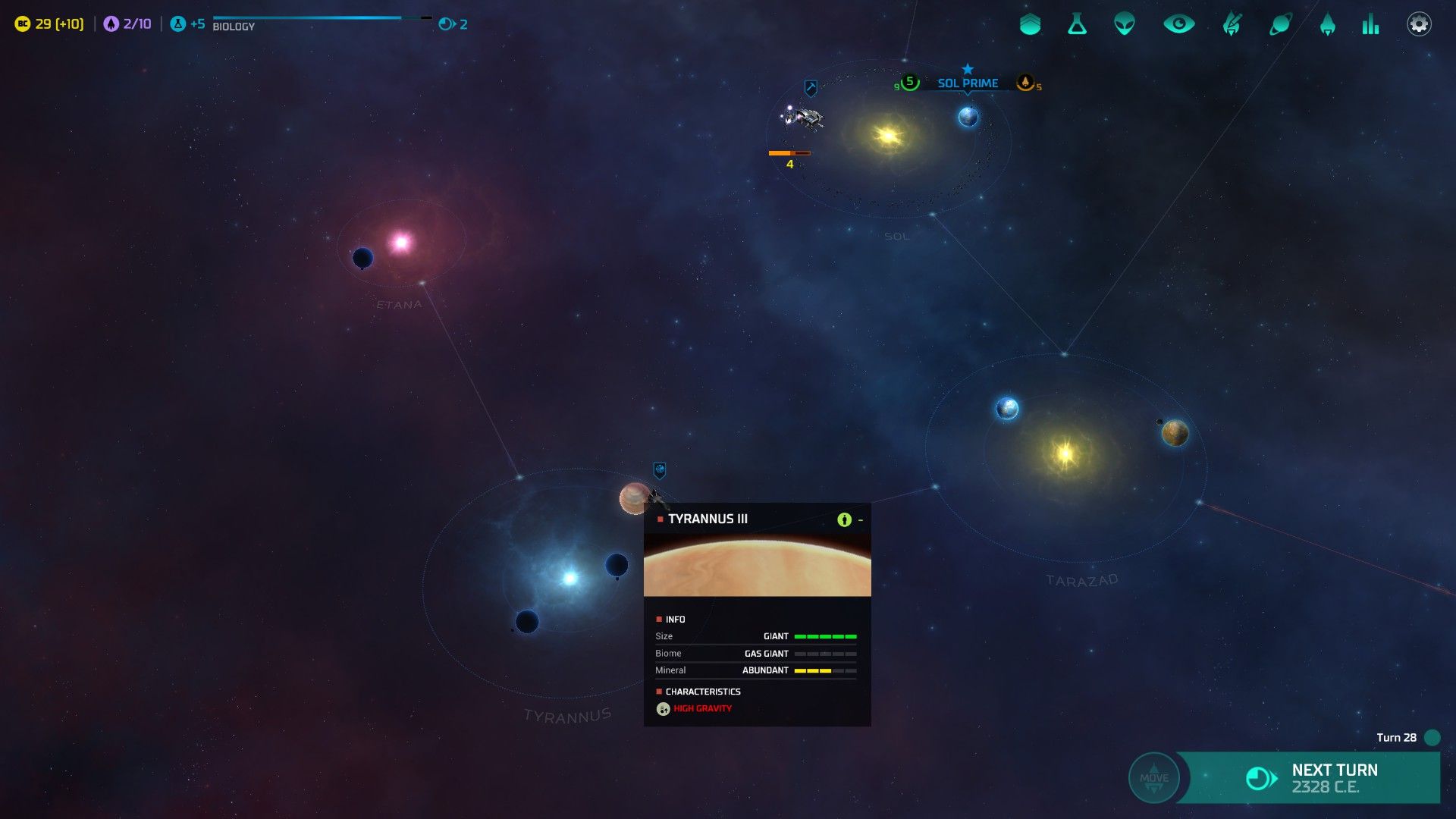 The white star Tyrannus, on the other hand, offers little friendly harbor for Humanity. Although both Tyrannus Prime and Tyrannus II have a great abundance of interesting and valuable minerals and ores, with Tyrannus Prime further having formations of easily-harvestable quartz with trace elements making it almost ideal as a raw material for the manufacture of a number of electronic components, both are airless, Hellish words blasted by the the output of their system primary. The gas giant Tyrannus III seems as if it might potentially be a valuable site for the harvest of various gasses in bulk quantities for fuel and chemical industries, but support of any such operation would require a permanent colony on one of the planets in-system, which is a daunting prospect. Radiated worlds, as extremely hostile environments, offer no potential for agriculture at all- all food for the population must be produced by fixed structures, and the theoretical population cap is very low. Gas giants can be mined, somewhat similarly to asteroid belts, through use of a factory ship. Dark quartz, like seagrass or gold, offers its +2 production automatically to any colony on the planet. 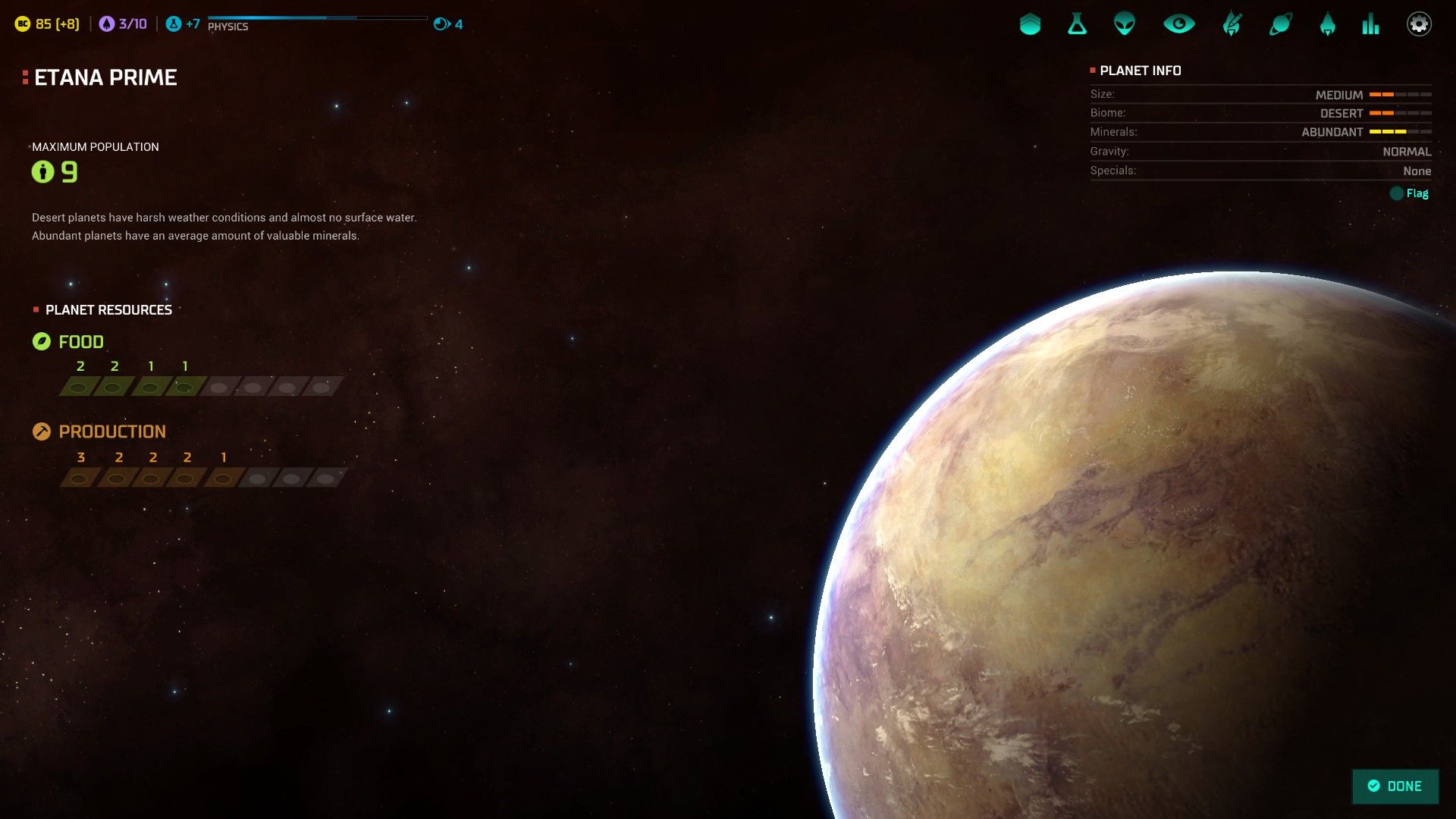 It is slightly surprising that the dim, cool ember of Etana, a brown dwarf, has any meaningful planets at all, let alone one as relatively hospitable as Etana Prime. Etana Prime is a harsh, cold desert, with what little water it possesses locked in ice and permafrost. Still, its atmosphere moderates the worst of its temperature flux and the primary challenges of the planet are a cold, barren environment. It even seems likely that relatively large-scale agriculture could even be achievable on the planet, with proper irrigation, fertilisation, and protective environments to provide a warmer, thicker atmosphere for plants grown there. 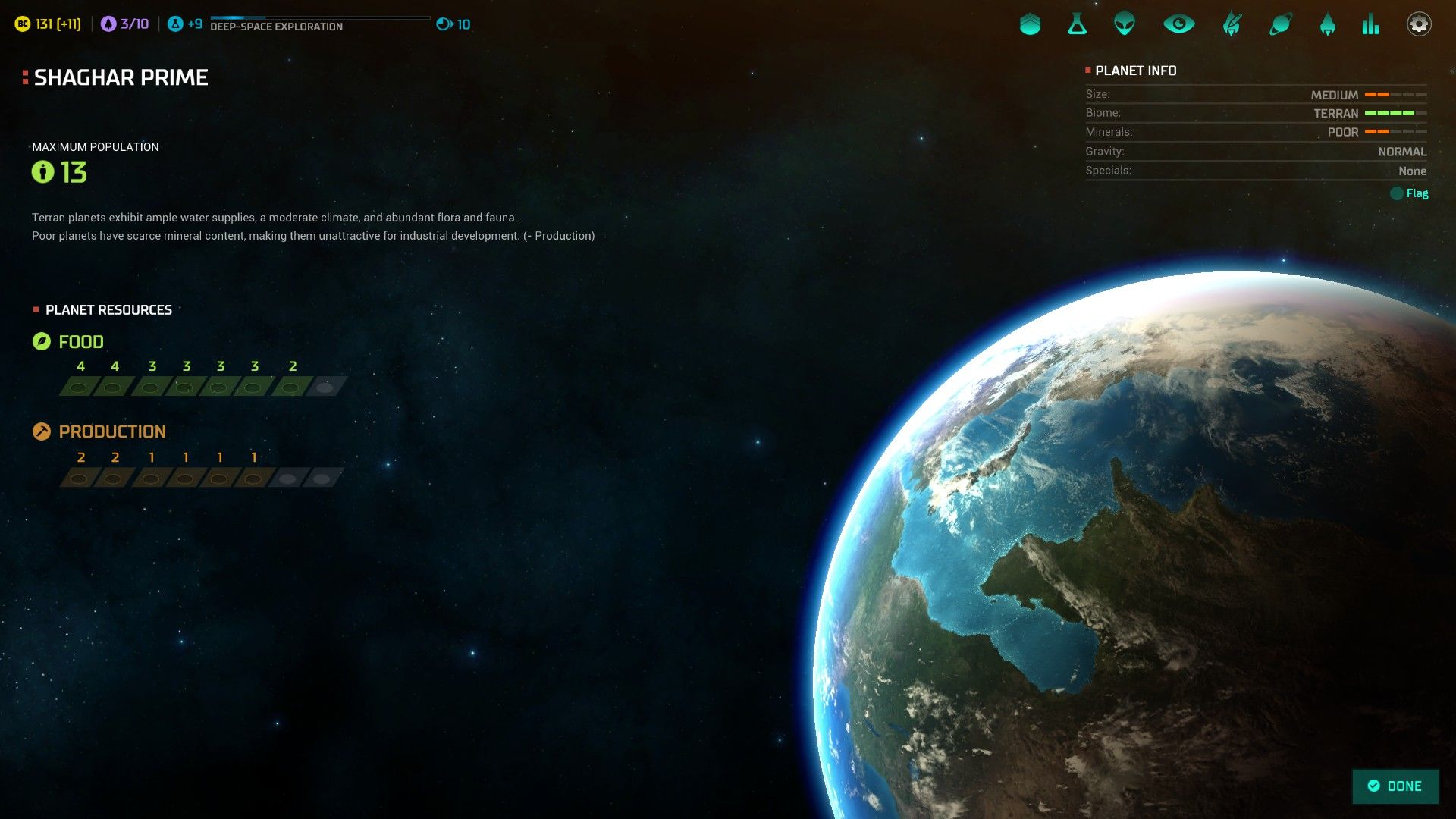 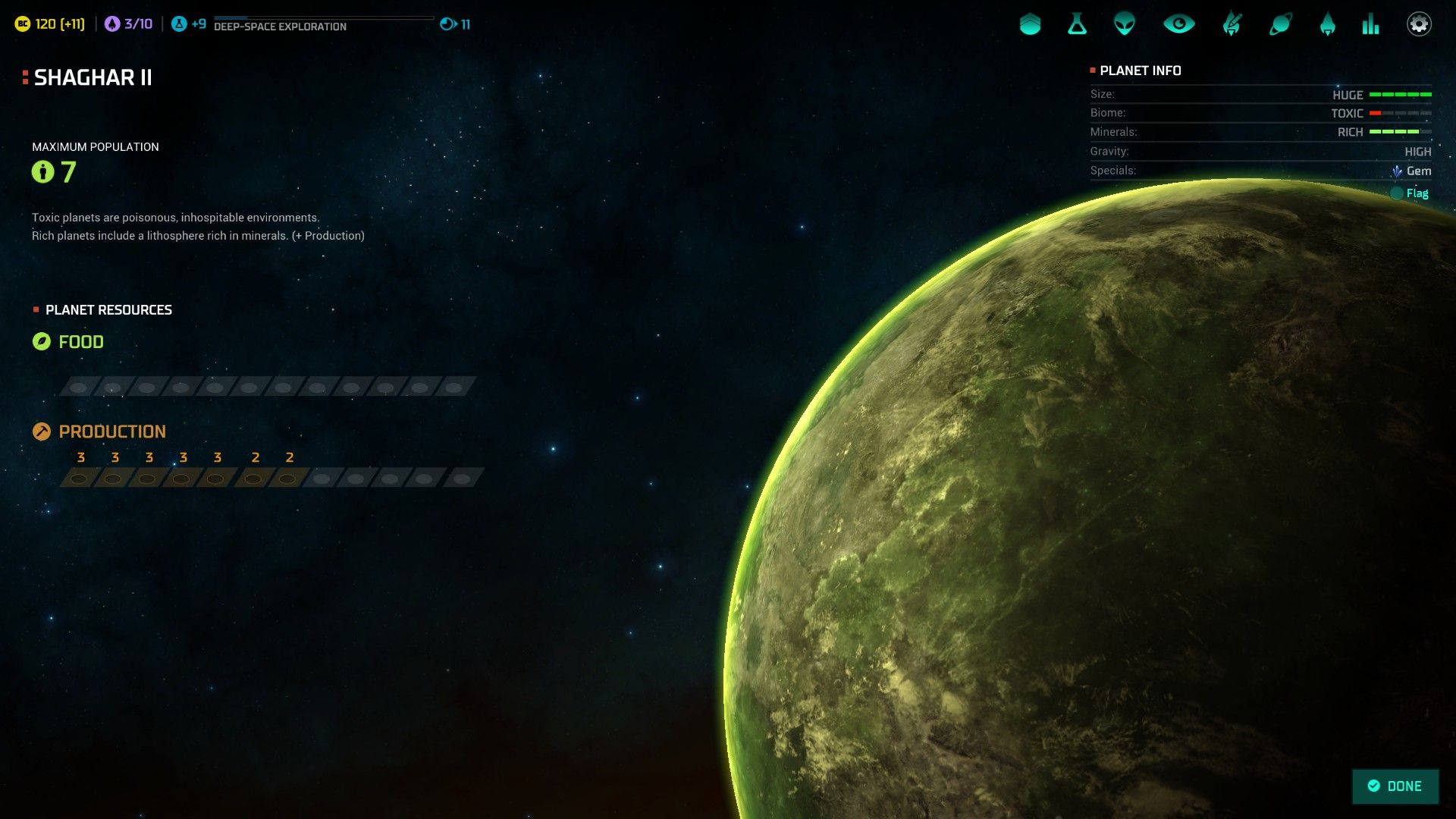 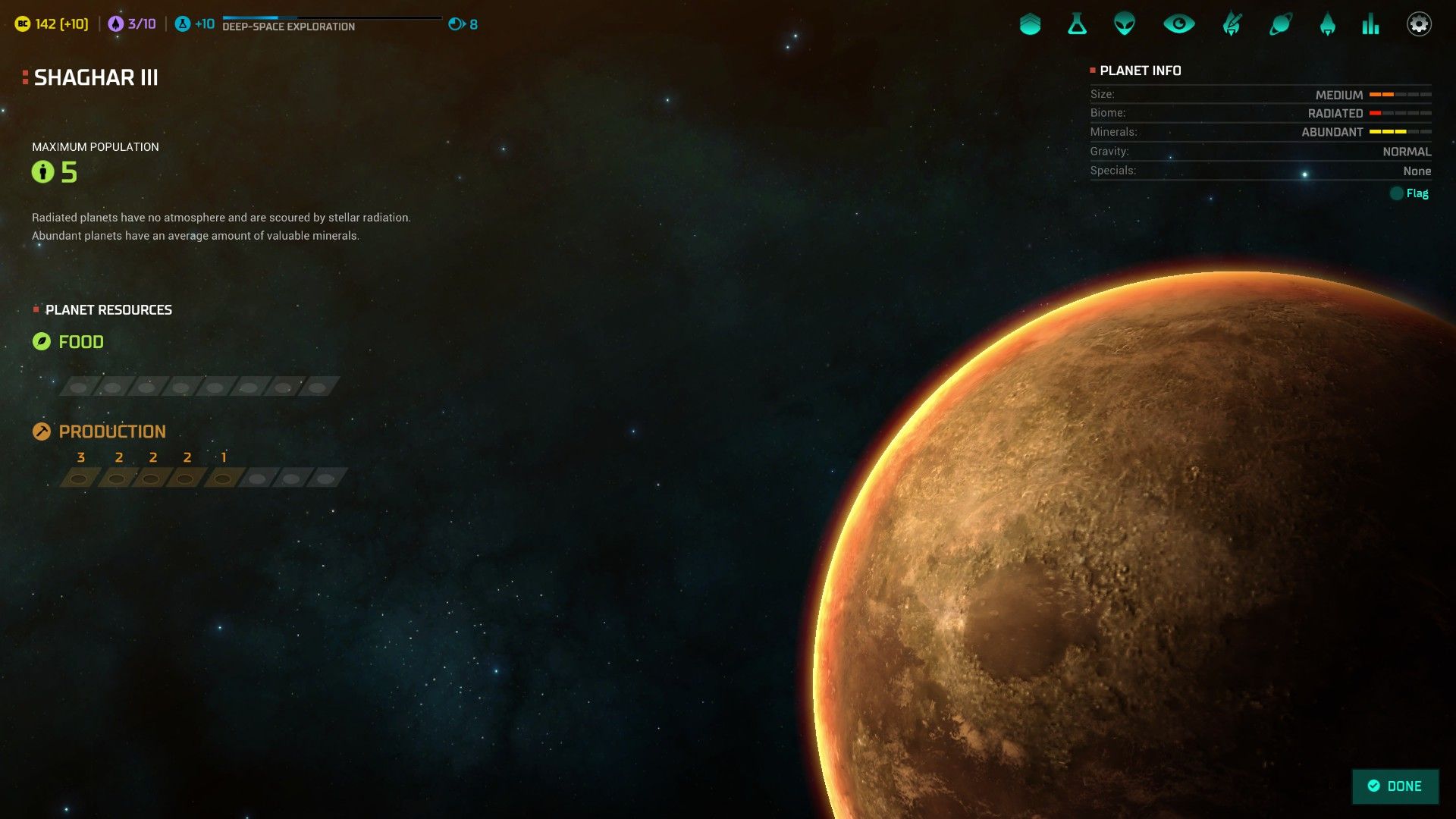 Shaghar is an orange star, somewhat cooler than Sol, with three potentially interesting planets orbiting it. The most promising is almost certainly Shaghar Prime, another planet of highly Earthlike size and environment. Although Shaghar Prime is fairly poor in heavy metals, it nonetheless has enough resources to support a reasonable local industrial base. Shaghar II is immense, mineral-rich, and rich in gem deposits that would promise to provide many startlingly beautiful stones. Unfortunately, the planet's atmosphere is made up almost entirely of highly reactive fluorine compounds, both extremely corrosive and highly energetically reactive in the presence of oxygen. Given that Humanity normally prefers to live in environments where glass and ceramic tiles do not spontaneously catch fire when exposed to breathable air, Shaghar II is regrettably a poor candidate for colonisation at the current time. Shaghar III, for its part, is an airless rock, bitterly, lethally cold on the night side, slowly increasing to temperatures that are only slightly higher than survivable by an unprotected human during the day as its surface absorbs heat from the system primary. Along with heat and light, it also recieves killing doses of radiation from Shaghar, which, combined with its lack of any resources that could concievably justify the effort, render Shaghar III an essentially valueless rock. 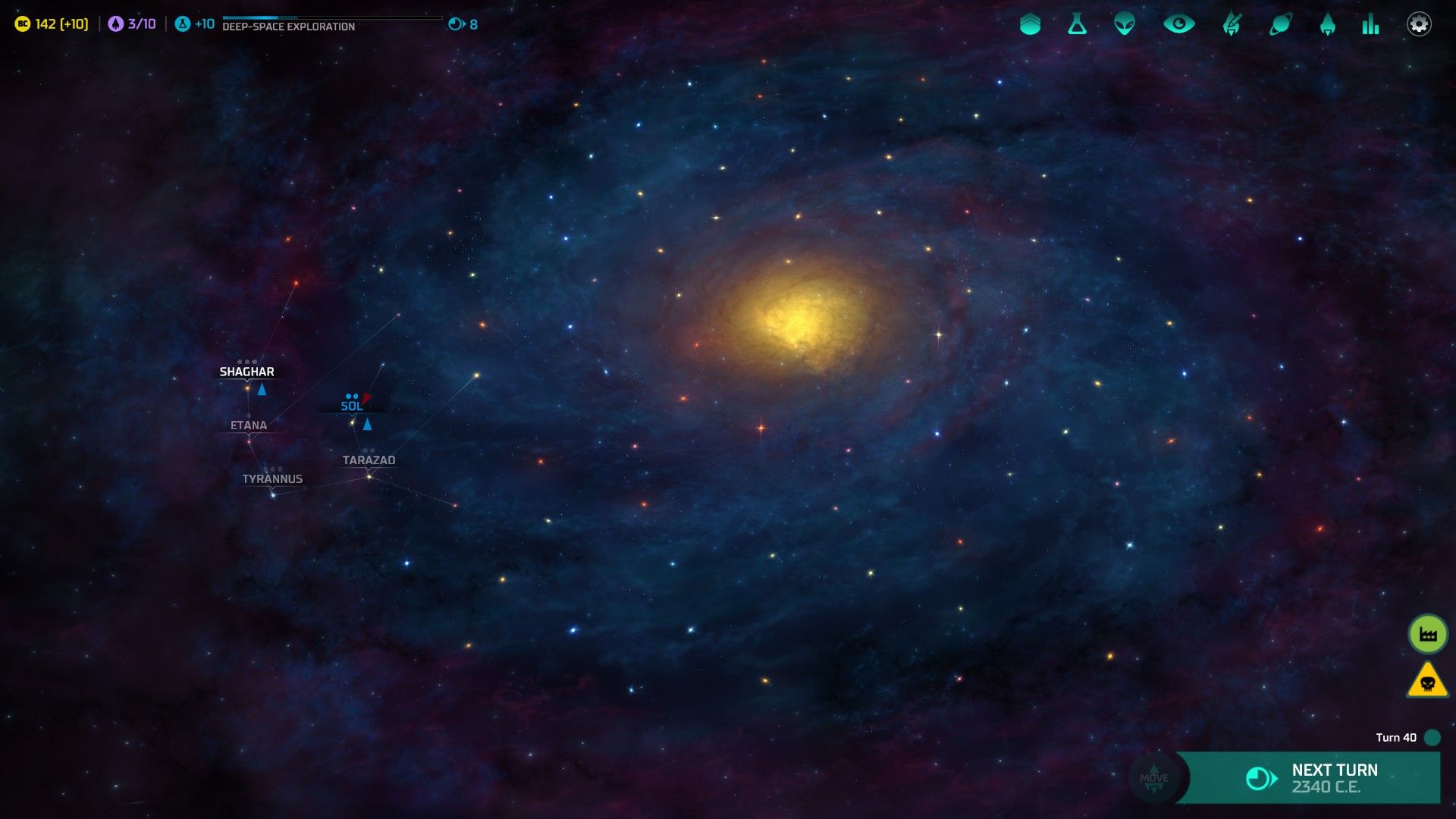 The explorations of the Werner von Braun have slowly traced along the galactic rim, helping to assemble a picture of the network of conduits usable for FTL travel in Sol's neighborhood. Humanity has a reasonable reserve of capital with which to meet future challenges, and is steadily developing itself. If the approach of the exile ships does not end in disaster, it seems likely that Humanity is poised to expand its civilisation beyond its single star. Proposals for the People of the Human Republic Domestic Investment Investment and construction into both advanced factories using new robotic technologies and industrial-scale hydroponic farms is underway on Earth. It seems likely, however, that one of these projects will receive the bulk of the funding and be completed first. Please vote between Automated Factories and Hydroponic Farms for Earth first. Both shall be built, and soon, but one has to go before the other. Research Investment 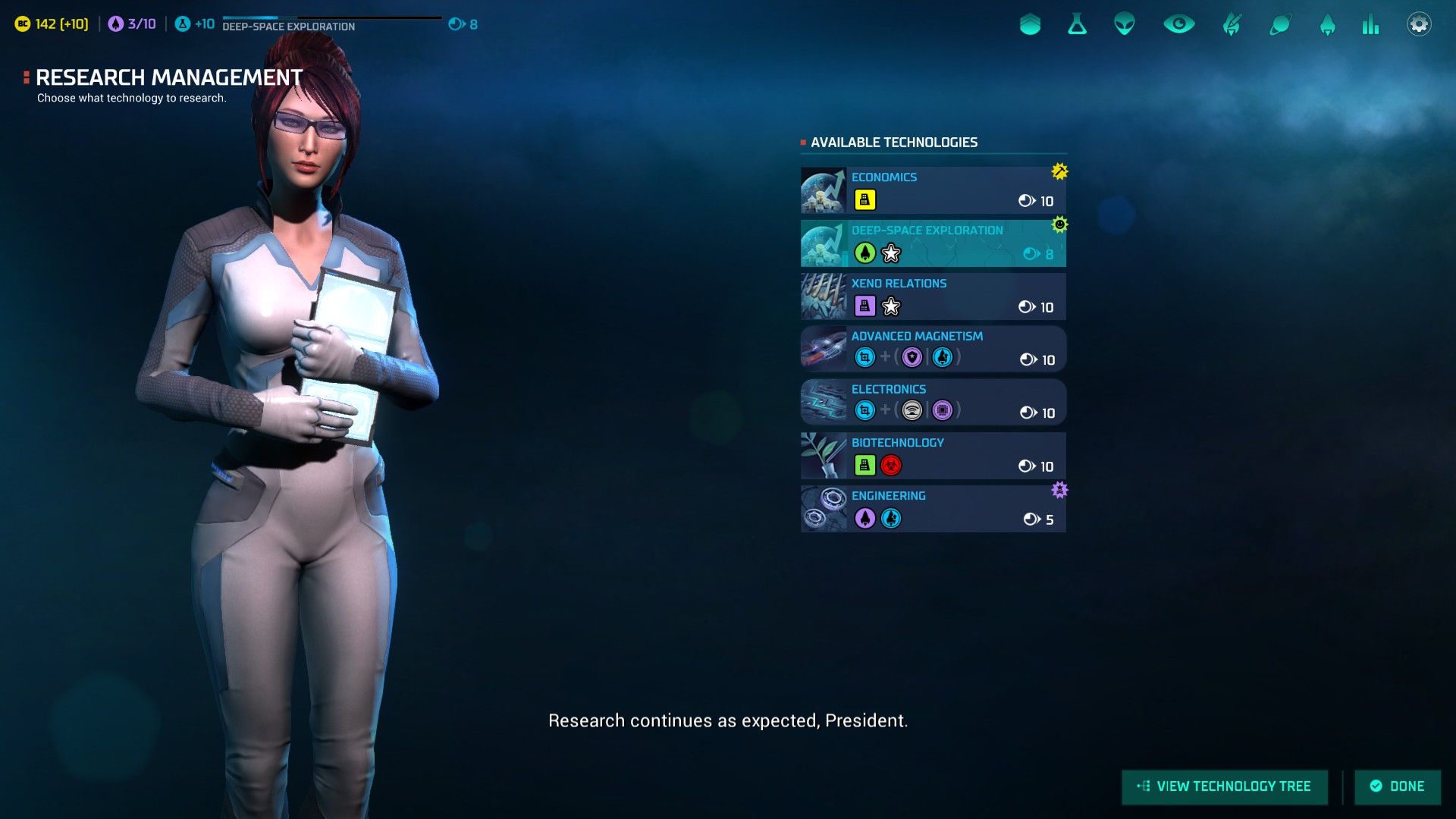 The promise of new worlds has spurred massive efforts into studies and the development of new technologies to support early colonial habitats, along with testing of technologies intended to support the logistics behind new colonies. Even so, other funding is available for other projects- advanced economic methods could greatly bolster the prosperity of Earth, while new spaceframes and construction methods, studies of certain quirks of magnetic fields, or better manufacturing and design of electronic components could all contribute to a new generation of shipbuilding. We will complete Deep Space Exploration research first, before anything else. Please vote on Electronics, Advanced Magnetism, Economics, or Engineering for research following that. Military Appropriations The potential threat presented by the exiles has raised some debate in the legislature as to whether appropriations for a new warship should be authorised, even though this is likely to delay colonisation if so. Whether any such ship should be of the Arbalest-class or a new class submitted according to requirements is itself a matter of debate amongst the Chiefs of Staff- as is even whether the requirements for any new class should be focused on dedicated space control duties or should be designed as a hybrid space control cruiser with capacity to attack renegade industrial capacity. Please vote on whether we should construct a new warship before we start on a colony ship, and discuss class requirements for any such new warship. Colonisation A number of planets could potentially be colonised by the Human Republic- how to prioritise these planets is, on the other hand, a matter of debate amongst financiers, colonists, and policymakers. Any planet to be colonised is also certain to acquire a real name of its own, rather than a mere catalogue entry based on its position around its star. Please vote on planets to colonise, and discuss names for new planets. I reserve the right to reject names for any or no reason, so please try to choose appropriate and serious names. Other proposals may be considered, depending on their merits. Feel free to propose something not mentioned, but I reserve the right to reject any such proposal out of hand in order to keep our behavior relatively sane and logical. The people of Earth hold out hope that the apparent threat approaching may either be dealt with peacefully, or swiftly defeated by the Republic Space Fleet- and if this hope proves well-founded, Humanity's future amongst the stars seems bright. nweismuller fucked around with this message at 04:22 on Oct 1, 2016 |
|
|
|
If you want more information on any of the technologies currently available, go ahead and ask- I will answer in reasonably specific terms for their immediate effects and vague terms for what they might mean for the future.
|
|
|
|
The three worst world types in nuMoO are Volcanic (permanently tectonically active hellworlds where 'the ground is now lava' actually applies over at least 30% of the ground in view at any given point on their surface), Toxic, and Radiated. Some of them might be possible to improve later, but for now they all seem pretty horrible. Silicoids actually can make good use of Volcanic worlds in a way nobody else can- and in fact their homeworld is Volcanic. nweismuller fucked around with this message at 04:35 on Oct 1, 2016 |
|
|
|
Who is Chief Savage Man? I'm not familiar.
|
|
|
|
Siegkrow posted:Nweis, have you thought about having the early updates tke up more turns? It's just that, well, late game 20 turns can fit in a lot of stuff but right now the updates feel a bit sparse. The issue is that running early updates longer risks locking audience participation out. I'm trying to update frequently enough so that people can meaningfully participate in decisions, and longer updates suffer from increasing information rot between the beginning and end of the update.
|
|
|
|
The next vote cast between Electronics or Economics will be our tiebreaker; the other will be researched immediately following. While work on research in advanced electronics is under way, there is a notable pull between differing priorities for allocation of resources. The Joint Chiefs of Staff are eager to see the design of rugged military-specification computer systems that improve on current combat control schemes, helping plot more accurate firing solutions. On the other hand, using improved computer power and signal processing to allow relatively rapid remote survey of planets without needing to individually visit each planet and take the extended time to gather survey results could be very valuable to exploration vessels. Please vote between electronic combat computers and deep scanners. Xenocides and Crazycryodude are already noted as having placed a vote each for deep scanners. nweismuller fucked around with this message at 11:29 on Oct 2, 2016 |
|
|
|
All right, I believe my path is now clear. Playing through update.
|
|
|
|
A Galaxy Stranger Than Was Dreamed As the 2340s began, little could Humanity have dreamed of the staggering series of firsts the next two decades would bring. The challenges of Earth's continuing development, the exploration of nearby stars, and the threat presented by the criminal exiles who had returned was enough for Humanity to be occupied, then.  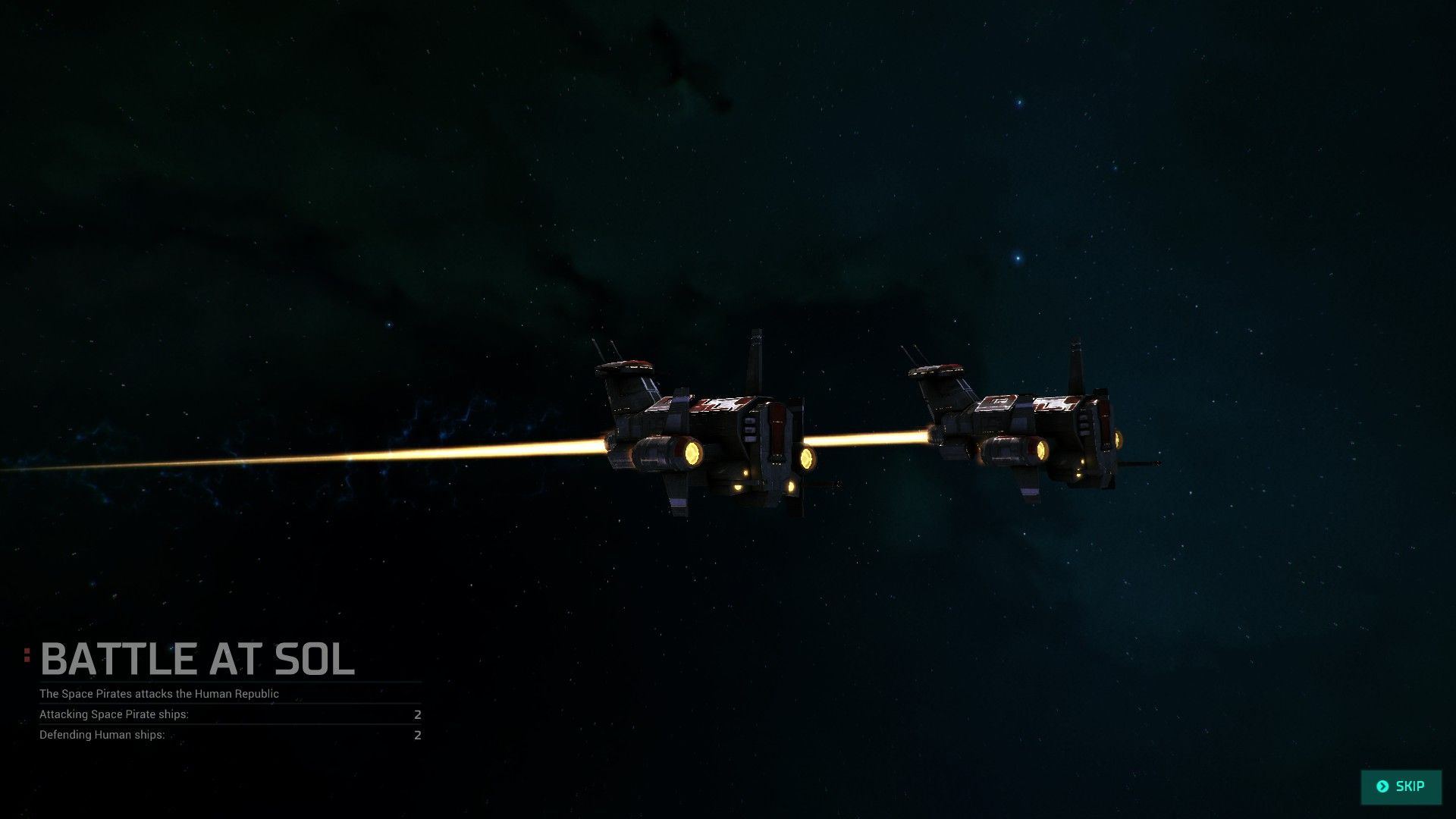 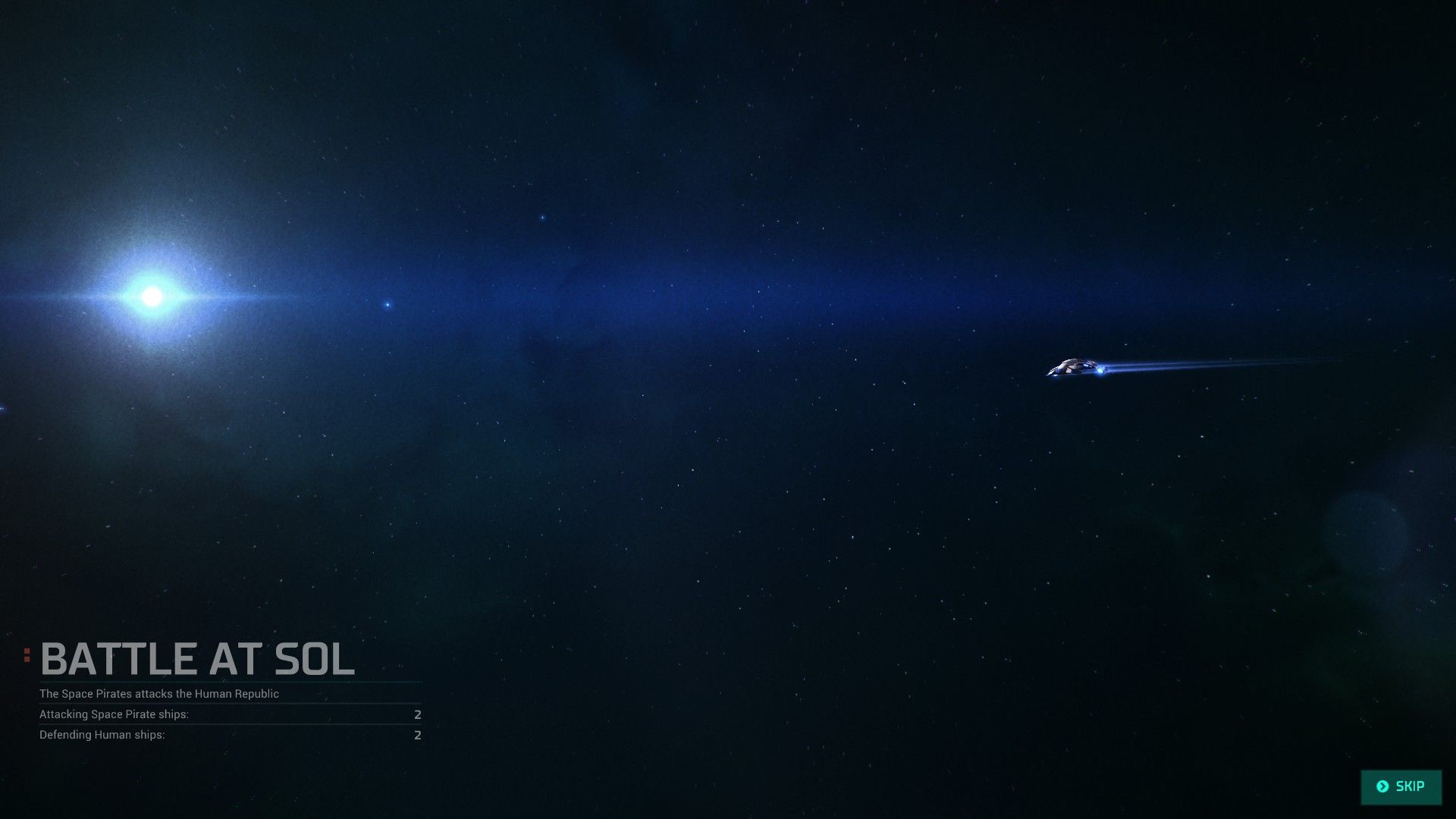 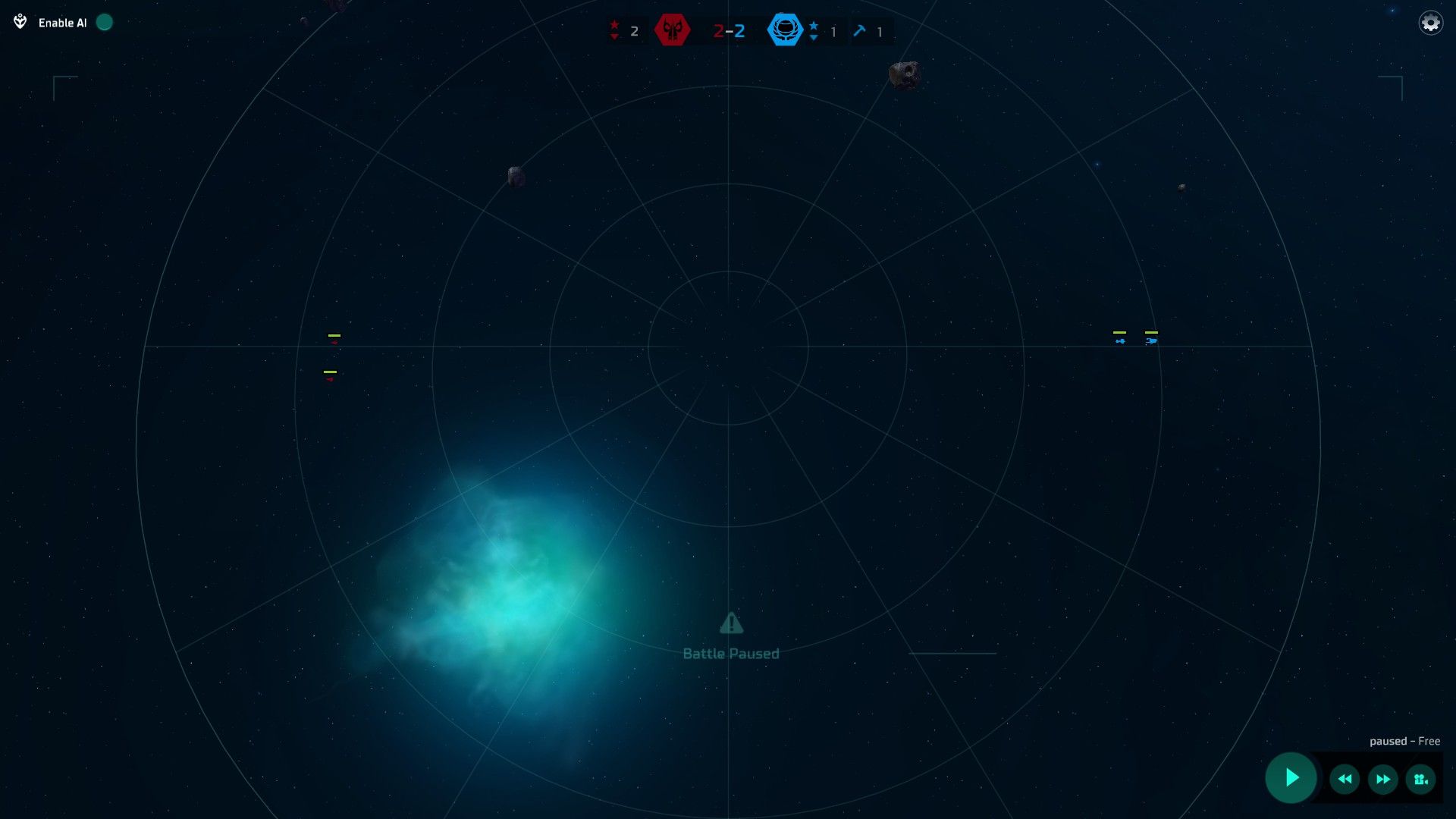 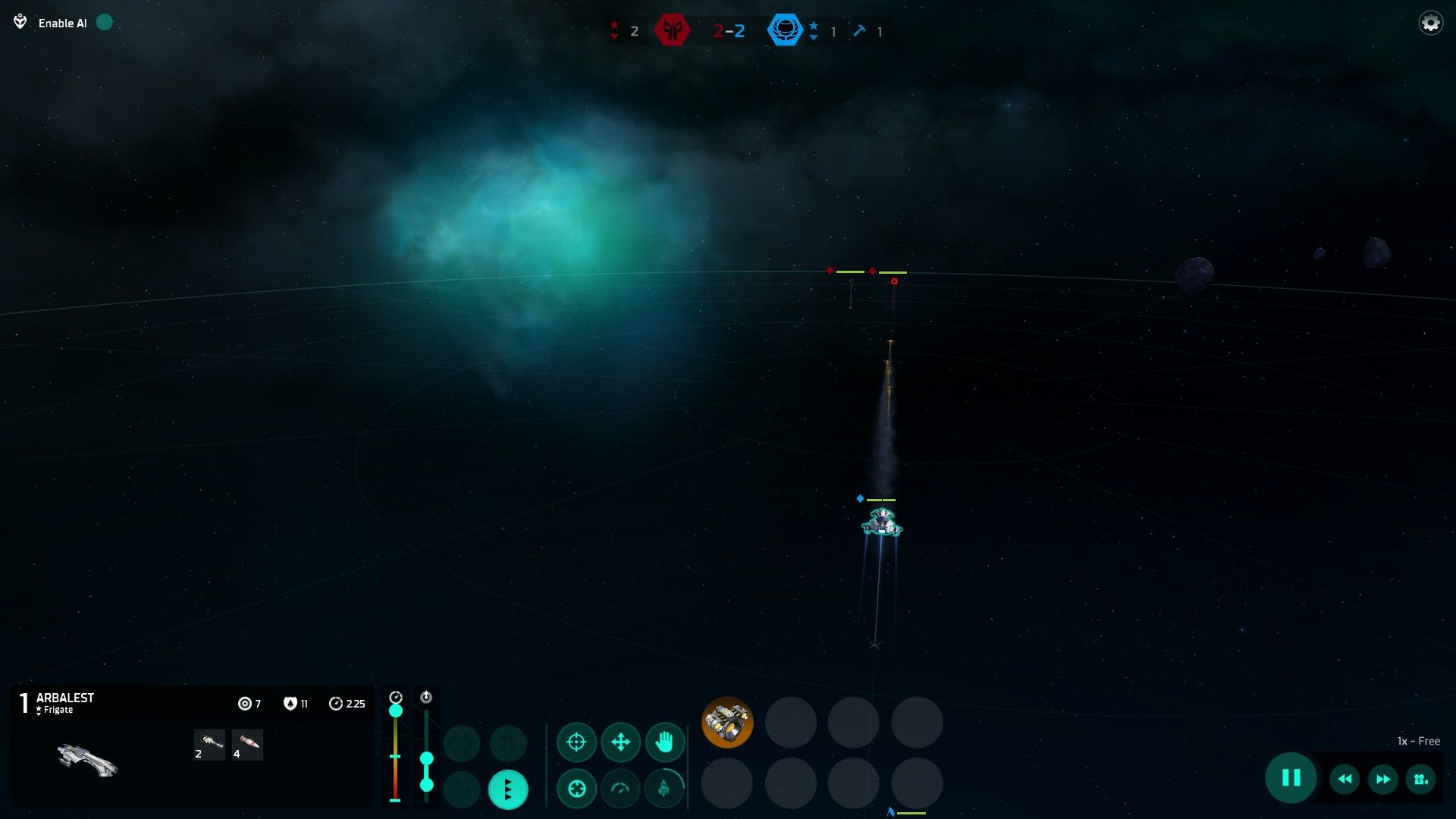  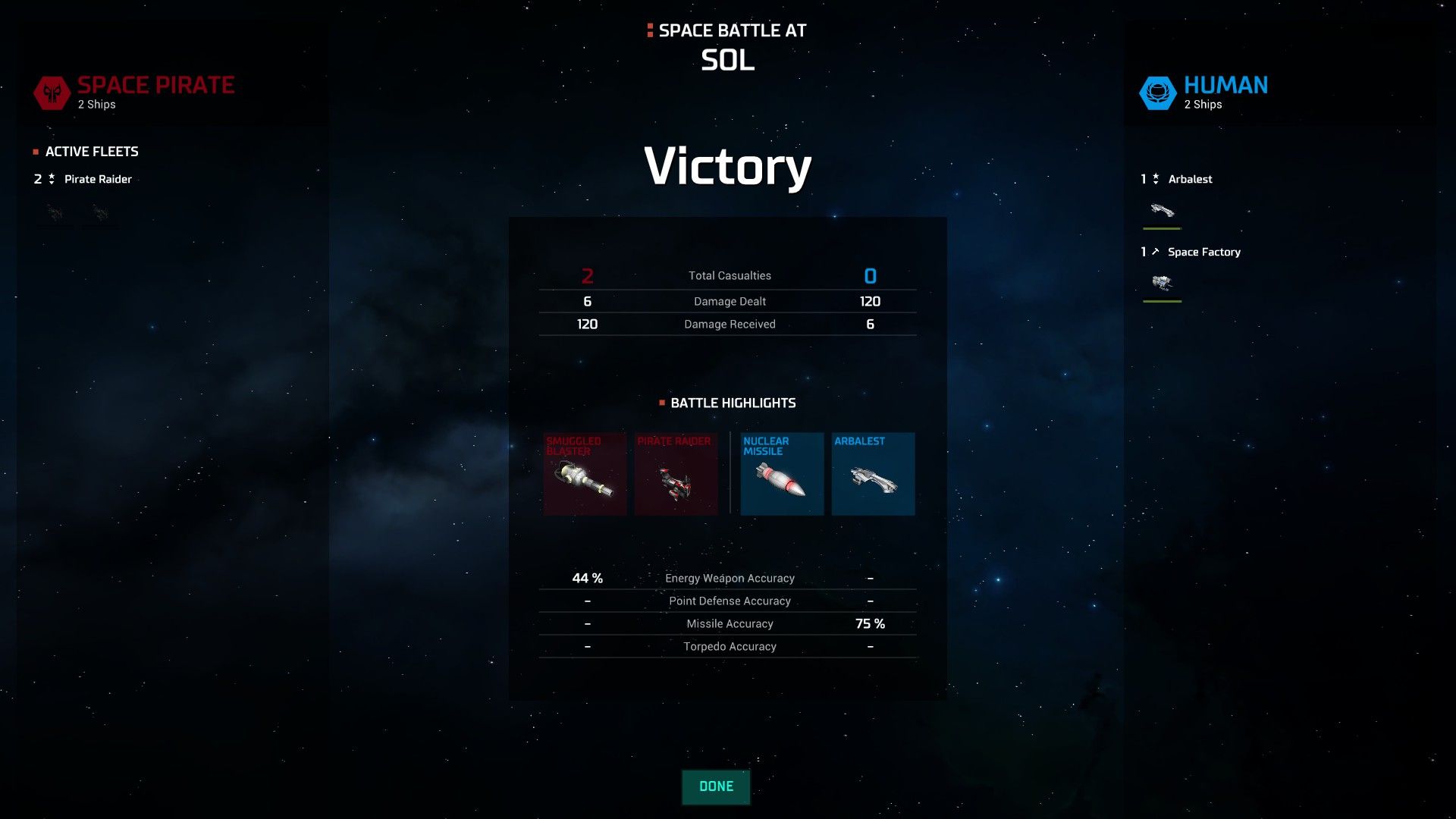 When the pair of exile vessels reached Sol, they immediately struck, attempting to cut in to disable and ransack the factory vessel still working on assembling a fortified station here. The Arbalest moved forward to engage, restricted from a more hit and run engagement style by its need to protect the civilian factory vessel. Even so, the battle was brutally lopsided, with both pirate vessels nearly vaporised by repeated proximity detonations of the Arbalest's nuclear missiles. The Arbalest, engaged at long and then medium range by chemical lasers mounted to the pirate vessels, took several hits, although only three caused any meaningful damage at all- some mild blistering of the Arbalest's armor. Post-battle analysis of the pirate wreckage indicated that their technology was woefully inadequete- the pirate chemical lasers had a lower effective power output than the standard proposals for Space Fleet lasers, they lacked any missile armament whatsoever, and the pirate armor was old-fashioned steel- which, although similar in strength per thickness to Space Fleet titanium alloy armor, was denser and heavier. In order to ensure acceptable speeds of travel and maneuver, the pirate vessels had a significantly thinner armor layer than the Arbalest, rendering them all the more vulnerable to destruction. A repurposed plasma arc welder, customised to blast its output over a much longer range, was, perhaps, the only technologically interesting piece of wreckage recovered from the pirates. Although only able to engage at approximately point defense range, the sustained beam of the welder could potentially deal heavy damage to a target over time, if the pirates had had any chance at all to get in that close. Pirate vessels are utter crap. They're thinner-skinned and more poorly-armed than the first possible warships you can build, making them nasty against unarmed civilian ships but basically target practise for any warship at all. Their 'swabber' welding beam can do up to 14 damage (in 7 pulses of 2 damage each) while training on an opponent, if they manage to survive to get into point-blank range, but otherwise their 'smuggled blaster' crap lasers do 4 damage, compared to standard lasers' 5, and they have a bit less than two-thirds the hull of a standard ship. With the pirates destroyed, the military station guarding the driftward conduit from Sol was completed by 2342, with the Arbalest redeploying to provide security for the construction of a station guarding the spinward conduit to Tarazad. 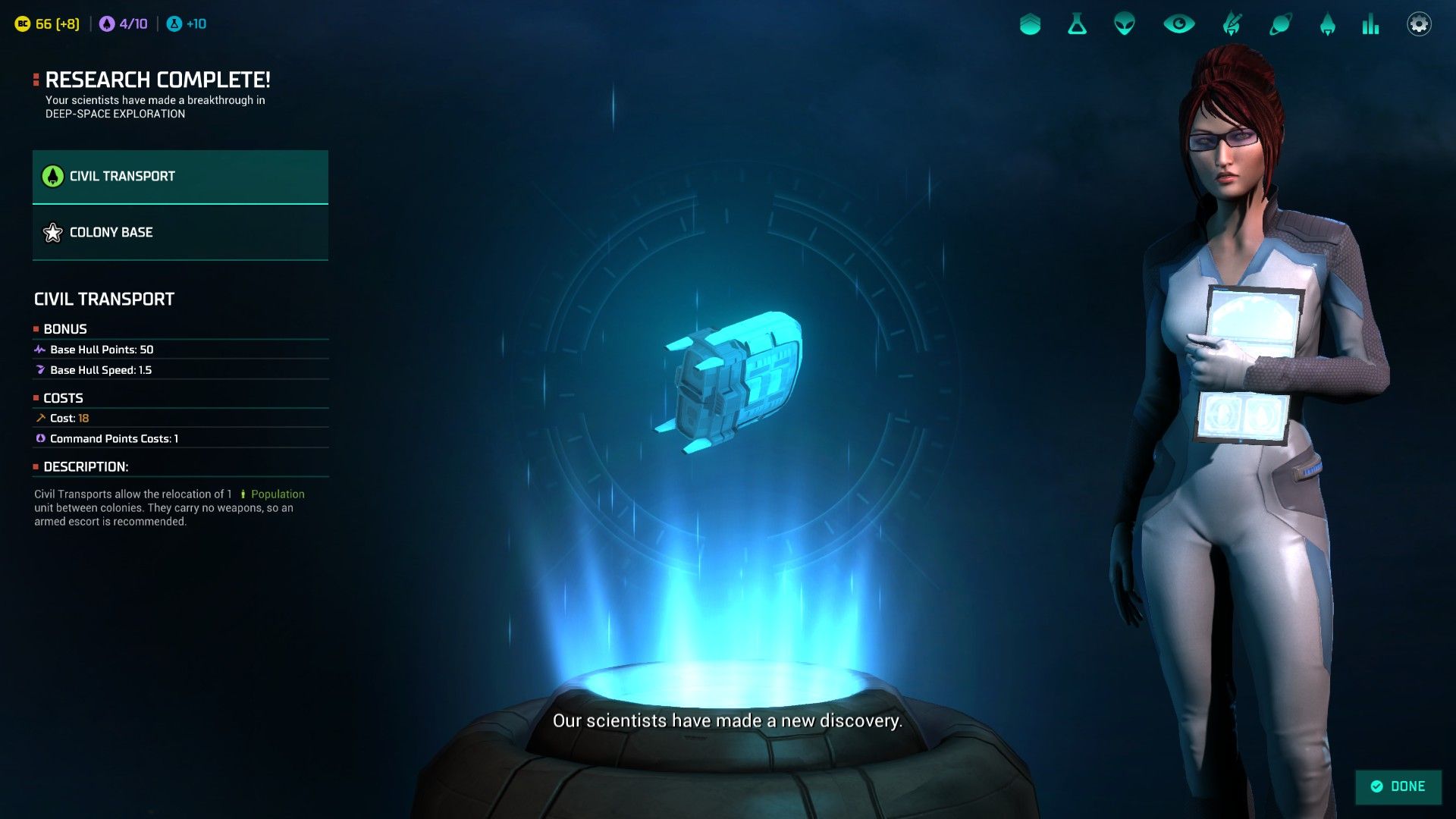 While these events occurred in space, research on the theory and practise behind establishment of new colonies far beyond Sol continued on Earth, even as recent breakthroughs in industrial and agricultural technology were implemented on a wider scale on the planet. Techniques for rapid establishment of habitat, breakthroughs in life support technology, and extension of existing hydroponics techniques should allow for colonies beyond Earth to be established quickly and efficiently, granted the proper seed equipment. Sealed and protected habitats could potentially make even the harshest environments habitable, with difficulty. Large-scale civilian transport between existing colonies should also be possible, and for far less expense than the establishment of new colonies. The Colony Base has each new colony come with a structure costing 2 trillion credits to maintain, providing 1 extra food. This helps support the population on new colonies immediately, and is essentially mandatory for colonies on Toxic, Radiated, or Volcanic worlds to be viable at all. Even on friendlier worlds, it helps with faster initial growth or diversion of the initial population to industry in order to rapidly get basic infrastructure up. The Civil Transport simply lets us shift one billion population between two colonies, again useful for giving new colonies faster starts. 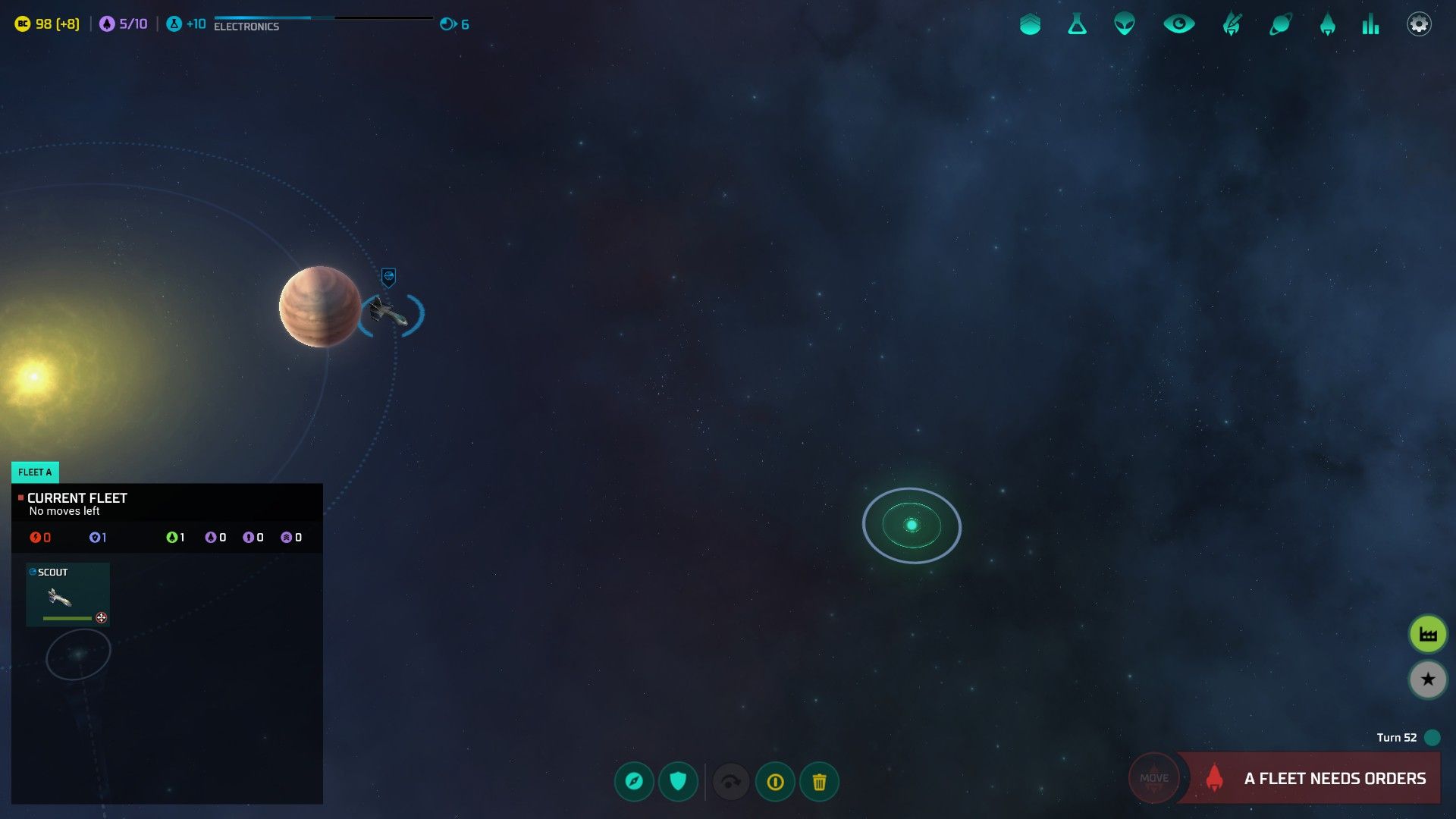 In 2352, while the Werner von Braun was surveying the yellow star Kif, another strange reading was detected in the far outer system of Kif, which the Werner von Braun proceeded to investigate at sublight speeds. This proved to lead to more than one dramatic discovery. 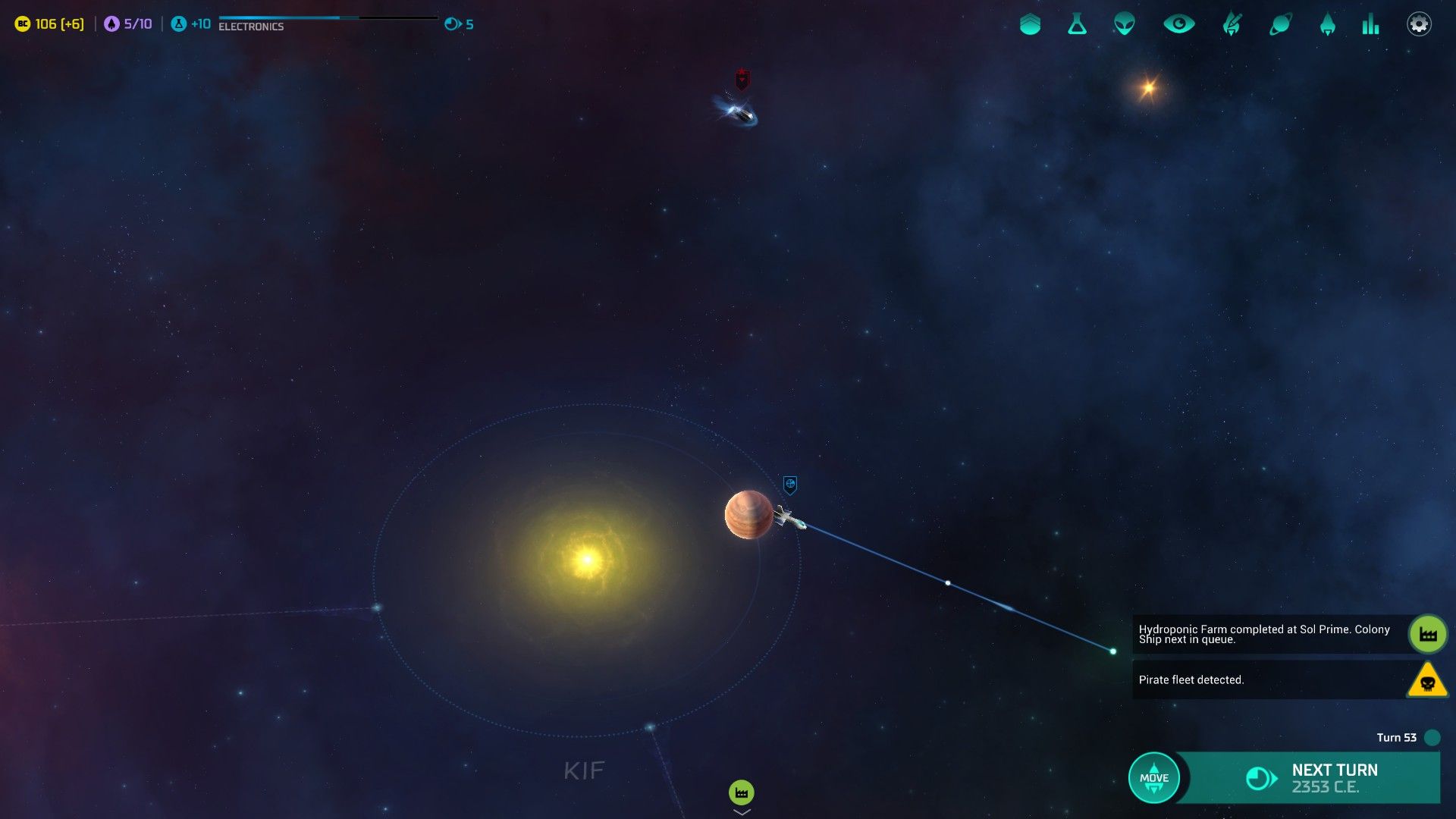 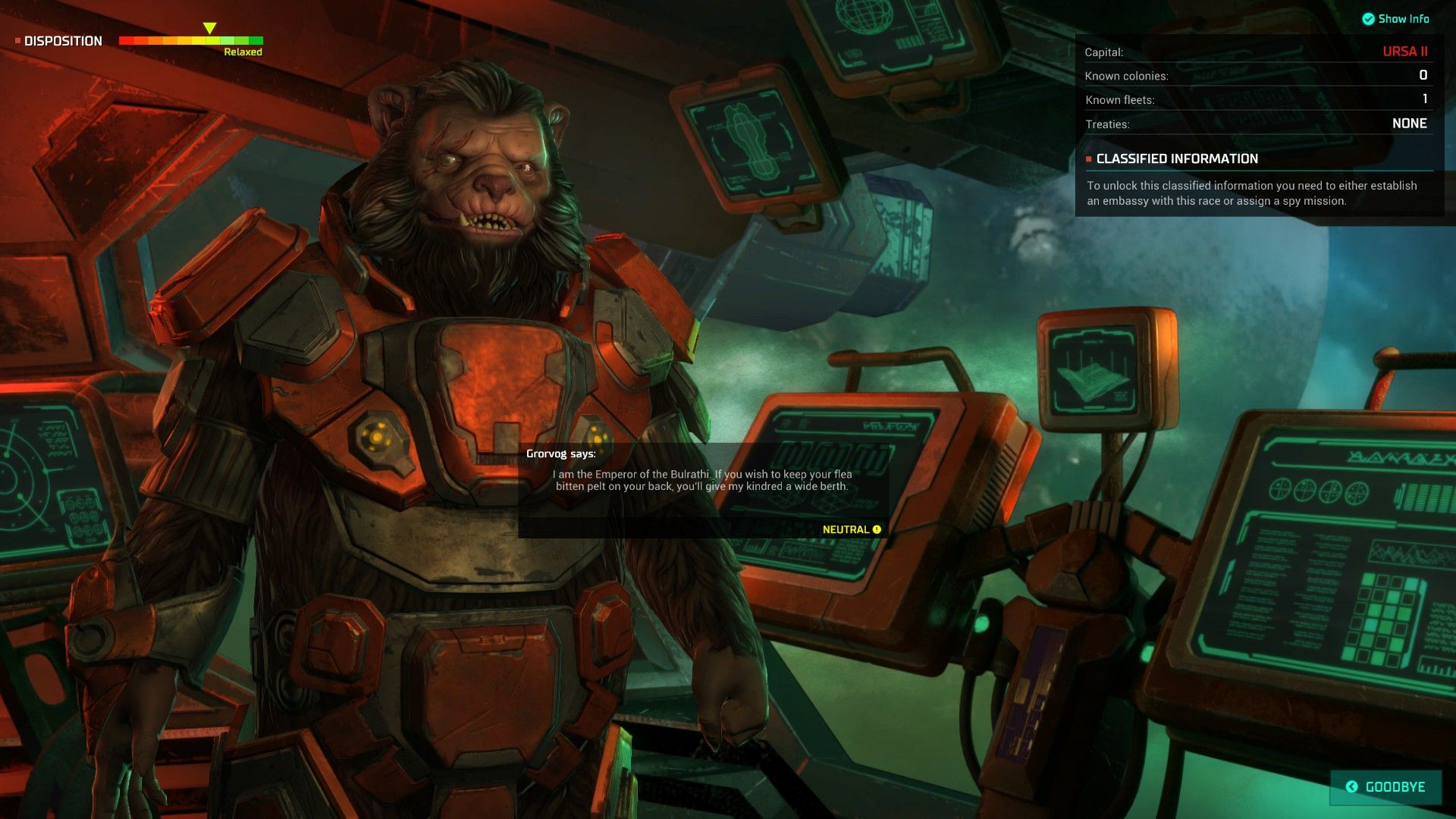 On the war out and during the search for the precise location of the strange readings, garbled radio contacts that proved to be encoded in non-Human languages filtered in from the system of Ellq. A slow-motion series of exchanges followed, eventually leading to the basics of this alien language being deciphered and very basic communication being established. The Bulrathi Empire was, itself, exploring its region of space, and demanded Human respect for all its territorial claims. Details of Bulrathi culture, society, and government are slow in coming, as so far only the most basic communications have been able to be established. Without the Xeno Relations technology, we have very few diplomatic options with the Bulrathi, and so we continue to labor in a certain fog of ignorance. 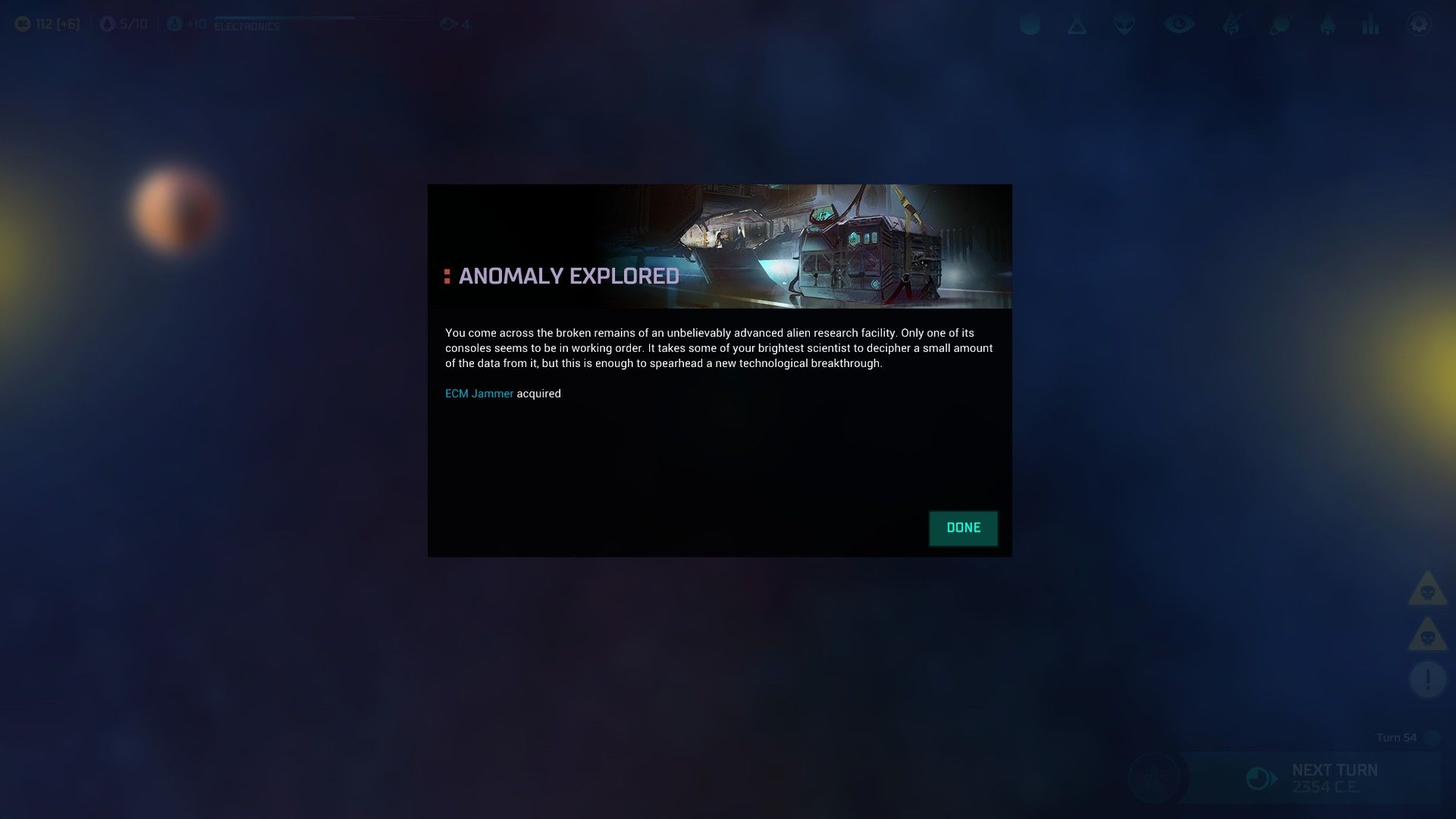 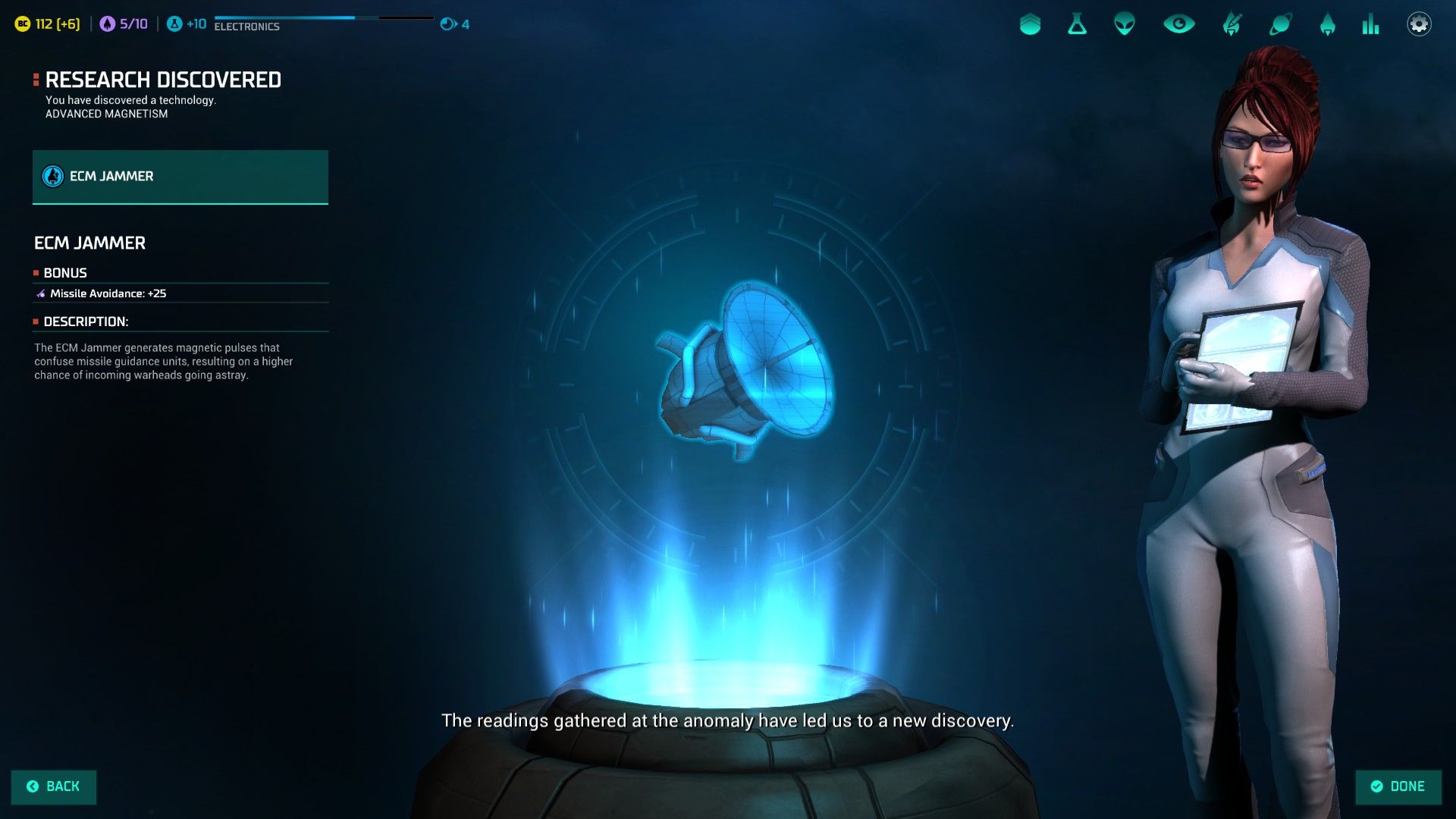 When the anomalous readings were finally traced to their source, the broken remnants of an ancient research station were unconvered. Markings on the station seemed consistent with markings on the ancient cargo container the Werner von Braun had earlier recovered, while the equipment inside had largely suffered catastrophic failures. Although the vast bulk of equipment that was intact enough to study was far beyond Human understanding, even what faltering attempts Human scientists made to analyse the findings led to startling new advances in signal theory and magnetics that could allow for new ECM techniques. What little can be pieced together of the language suggests the facility was associated with 'Lobok Advanced Technologies' working under contract for the 'Orion Confederation'. 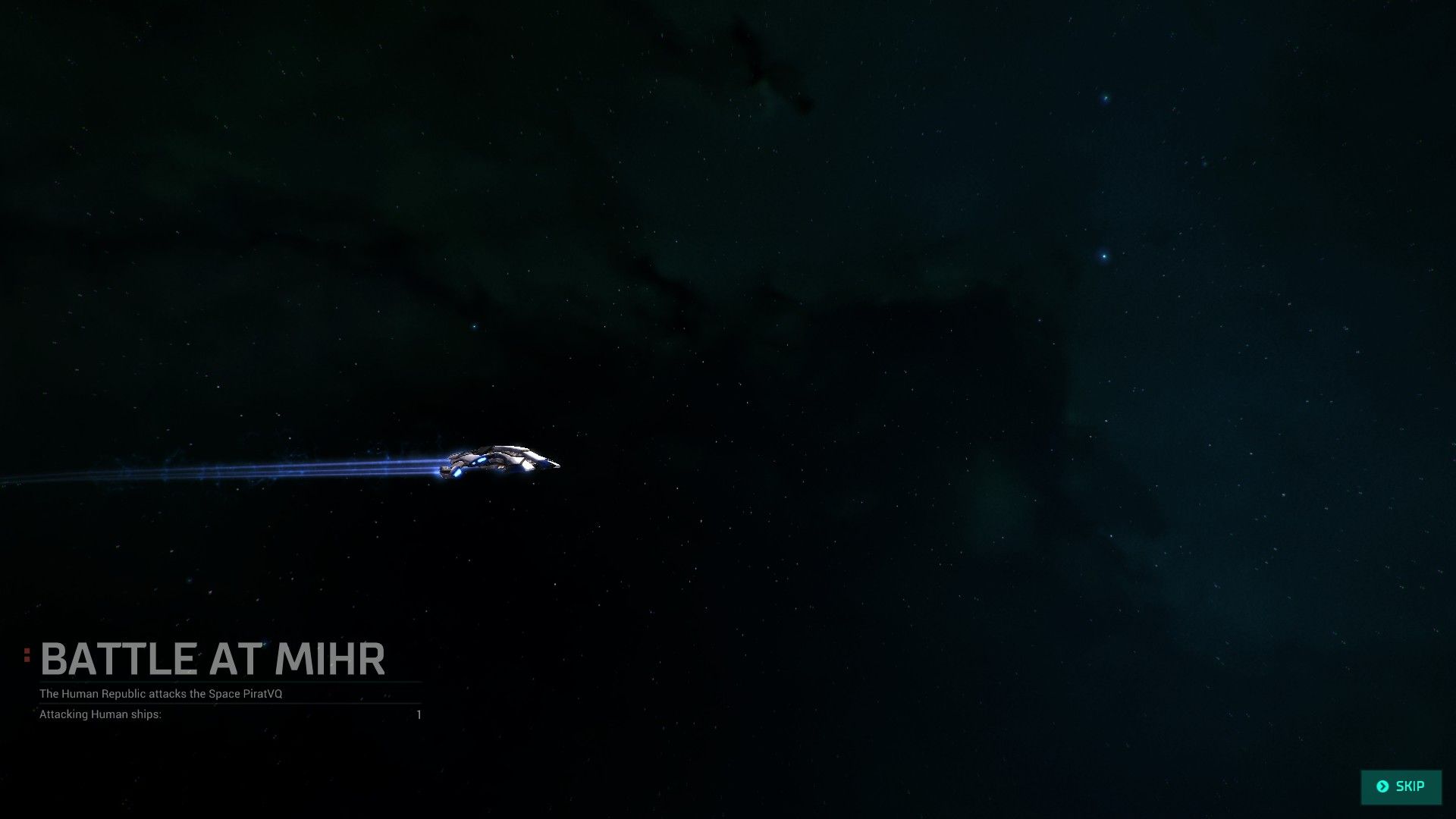 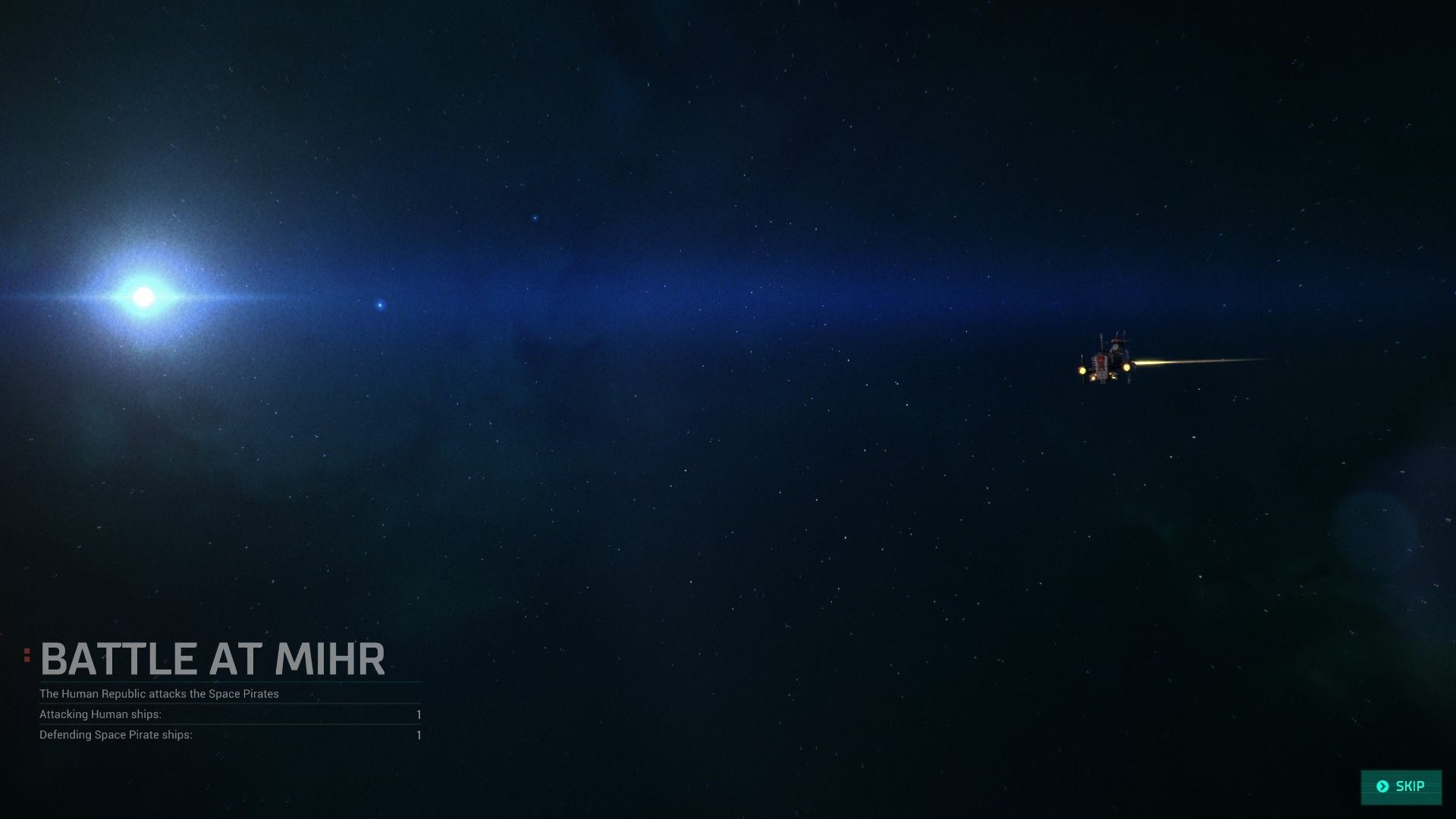 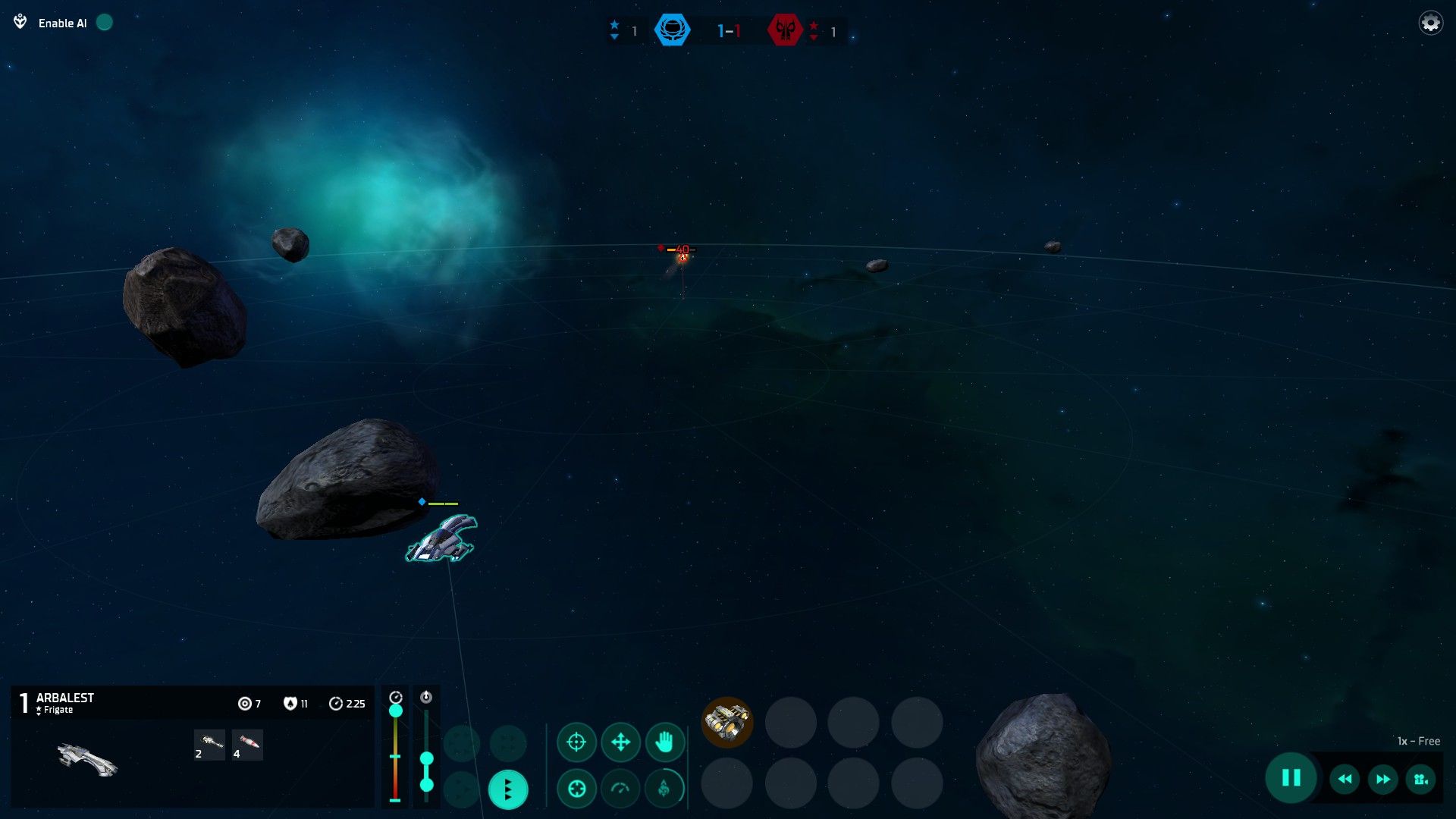 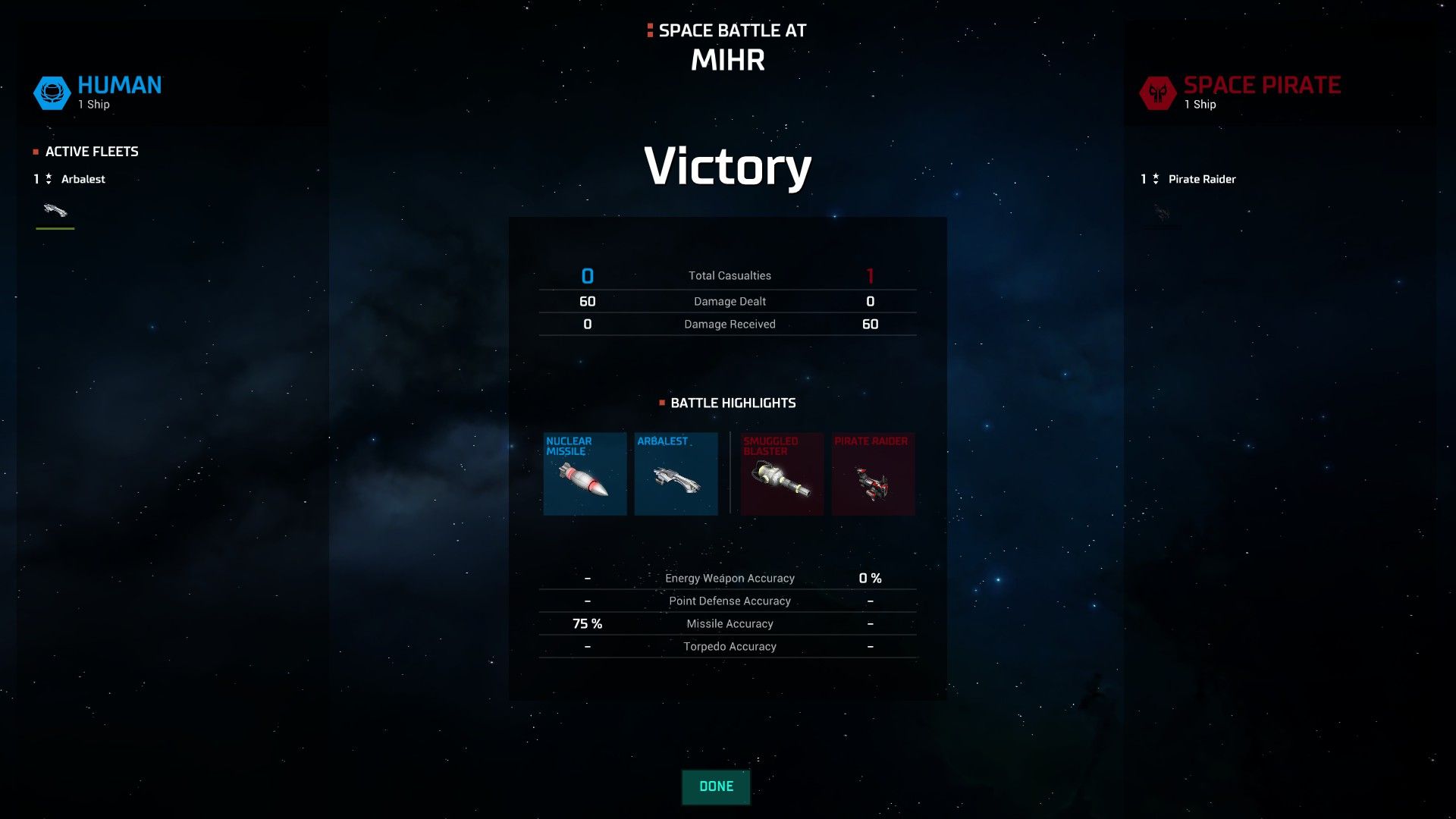 Even while the Werner von Braun was exploring the outer reaches of the Kif system, the Arbalest was arriving at the white star driftward of Sol, Mihr, having been assigned there on a reconnaissance mission by Space Fleet in hopes of pinpointing the pirate presence. Another pirate vessel was about to enter the conduit to Sol, which the Arbalest immediately engaged. The battle ended swiftly and decisively, with the pirates being annihilated without scoring any hits whatsoever on the Arbalest. 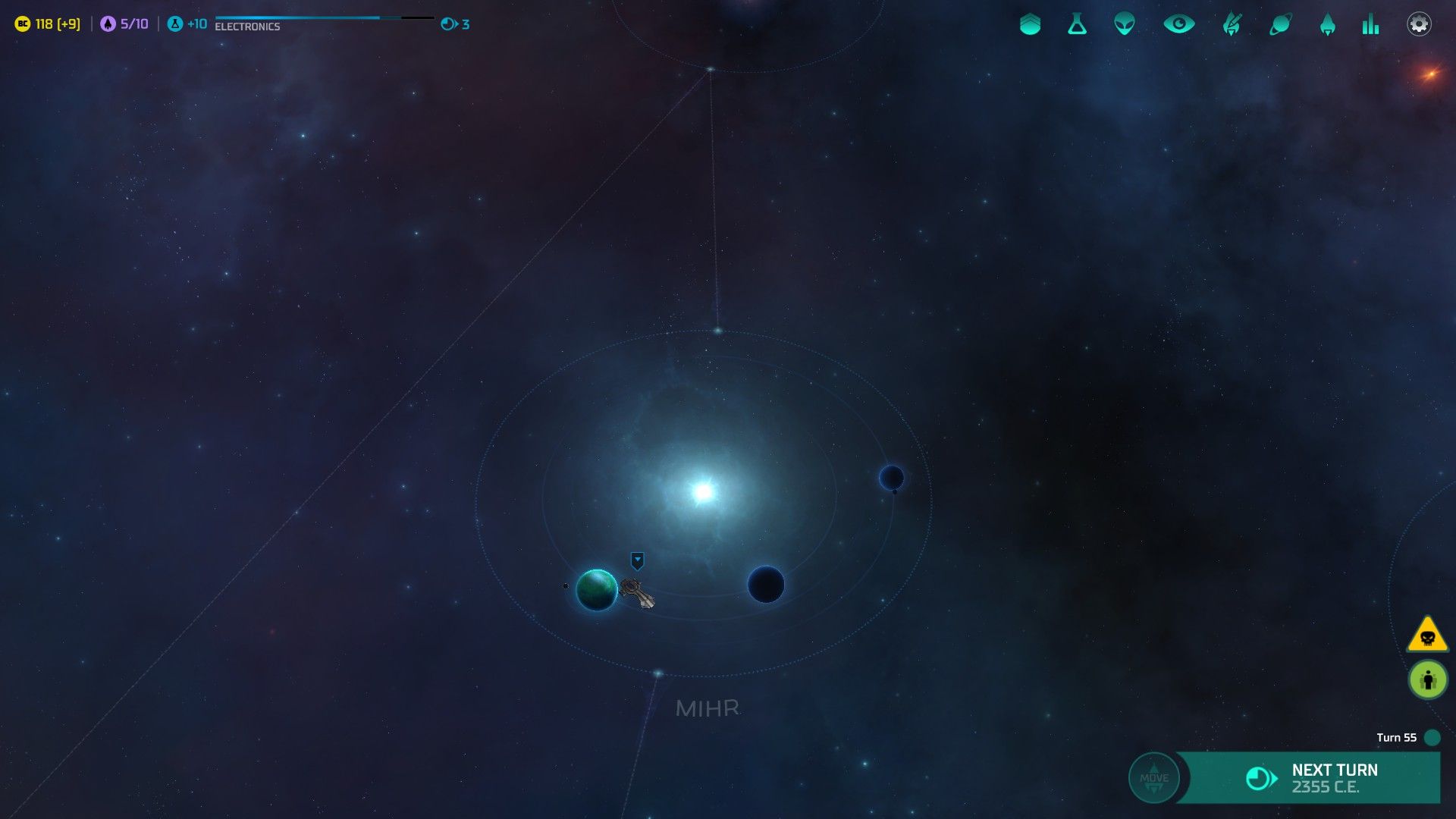 The following year, the Arbalest completed the survey of Mihr II. Adam Chan, the current captain of the Arbalest, is said to have stated, on review of the survey reports, "Surely this world is Paradise itself." As reports filtered back to Earth, the name stuck- Mihr II, or 'Paradise', is a world of astonishing beauty and fertility. Captain Chan took it on his own initiative to take up station guarding the unsecured access to Mihr, assuming that control of the system would be of critical strategic importance to Humanity. The General Staff, upon recieving his report of this action, confirmed his decision and kept him on station. Our first Gaia planet discovered. 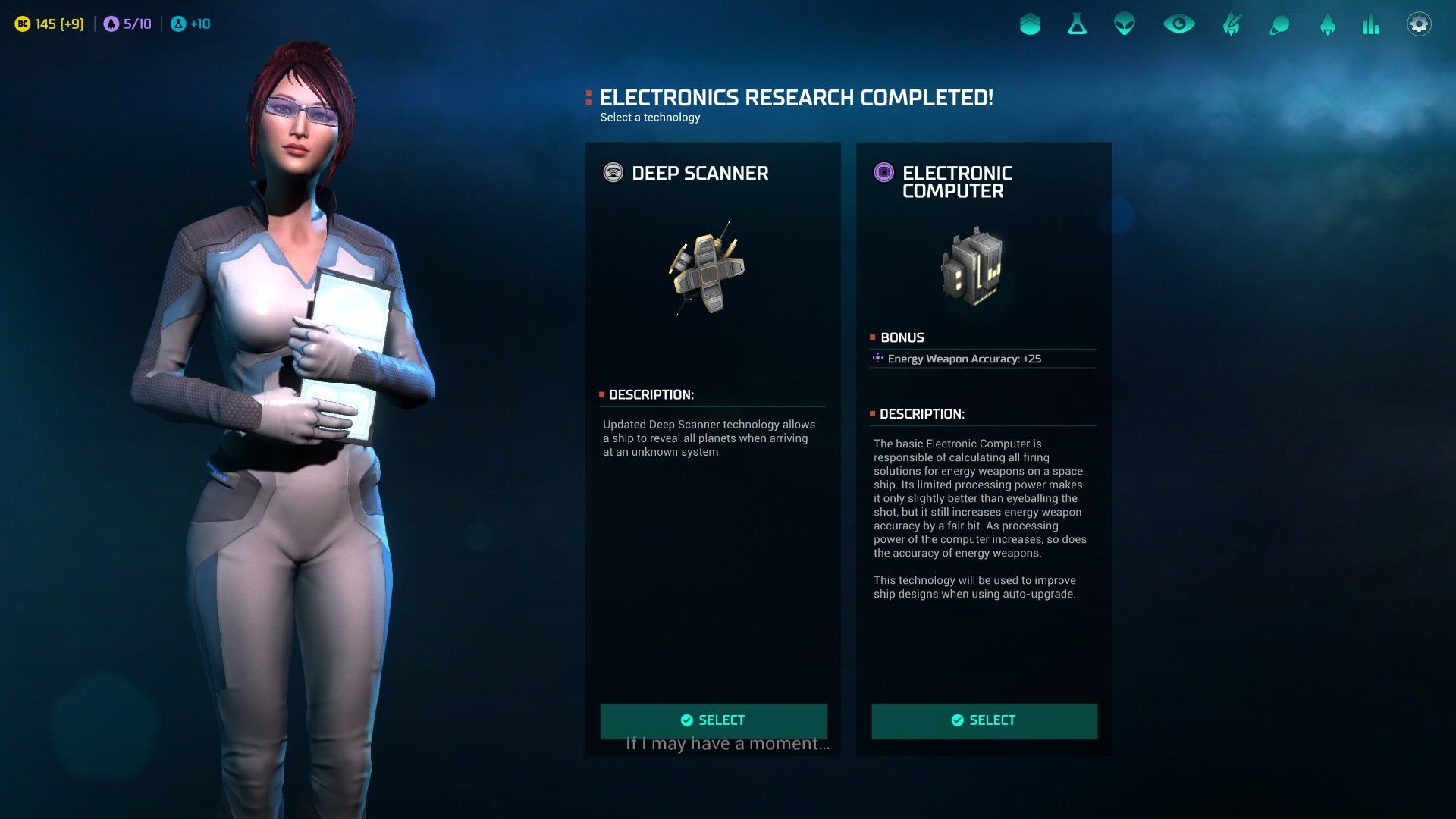 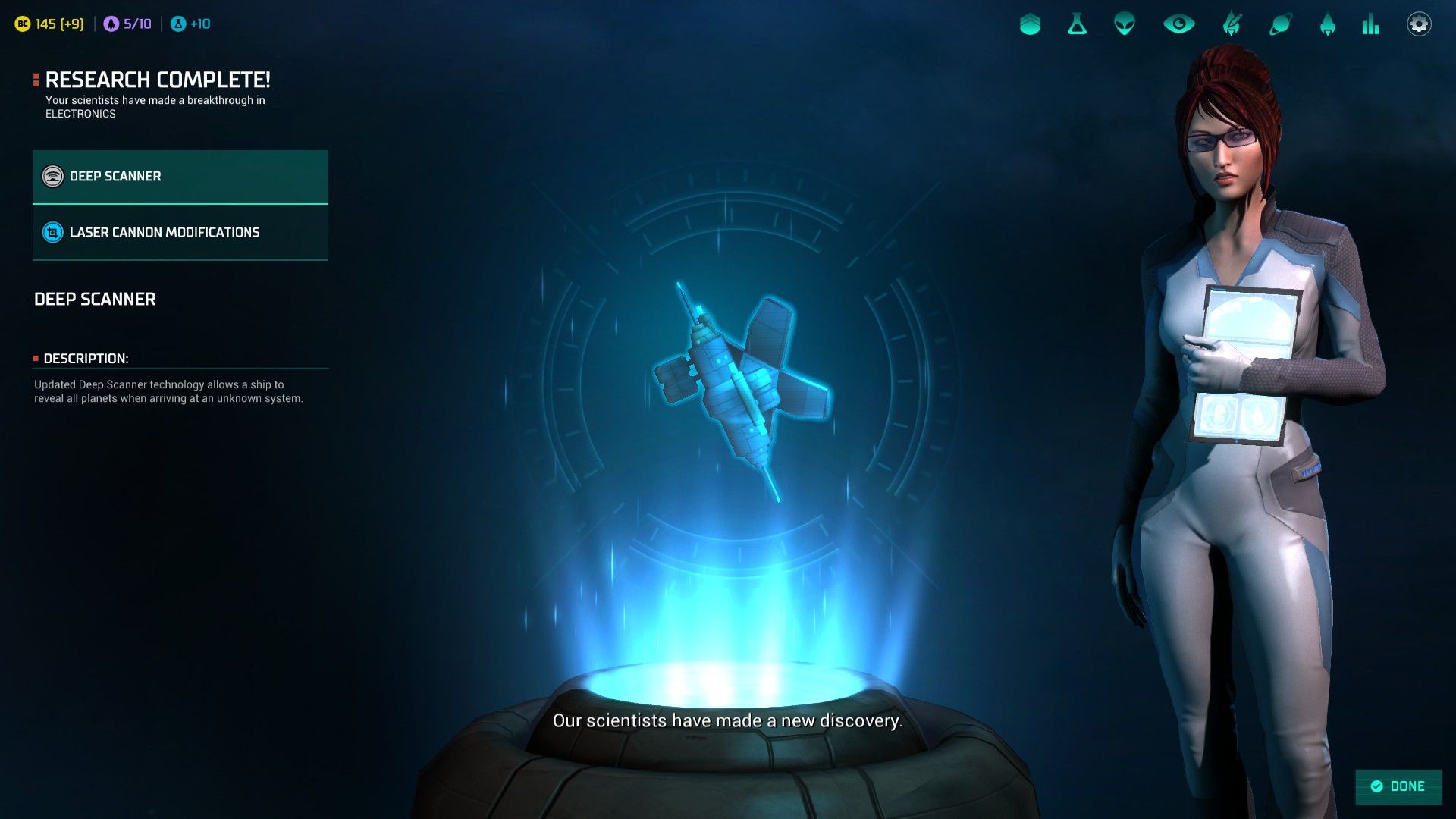 By 2358, improvements in manufacture of electronic components and lessons from the survey experience of the Werner von Braun had led to several exciting new applications, along with steadily-improving computer technology. Redesign of laser turrets for specialised roles was possible with better solid-state components, while improvements to sensor arrays and the computer systems interpreting their results allowed for significantly faster survey of planets from a longer range. We now can scan planets immediately upon arrival in the system, exposing our scouts to fewer risks and allowing faster survey of the region. Some technologies require to make a choice when you research them for what application you want- in this case, we got Deep Scanners rather than improved Electronic Computers for fire control. 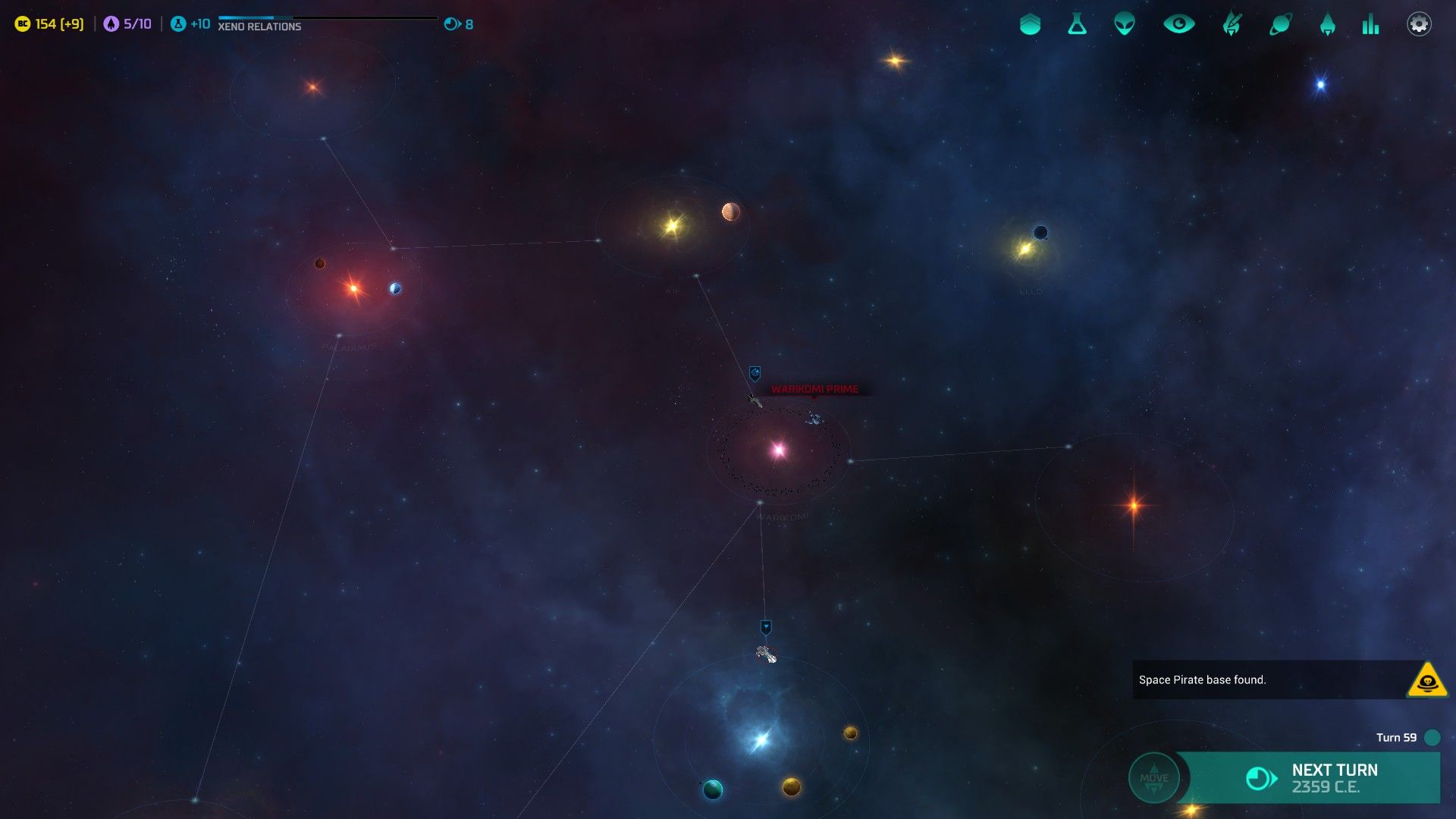 A year after these discoveries, the Werner von Braun arrived around the dim brown dwarf Warikomi, discovering that a ramshackle colony had been assembled amongst the asteroids there by the pirates that had plagued the Human Republic thus far. Scattered mining and crude factories supported their society, while hidden shipyards slowly assembled the next generation of ships to plague their cousins in Humanity. The Werner von Braun could do nothing here, and pressed on to explore further. 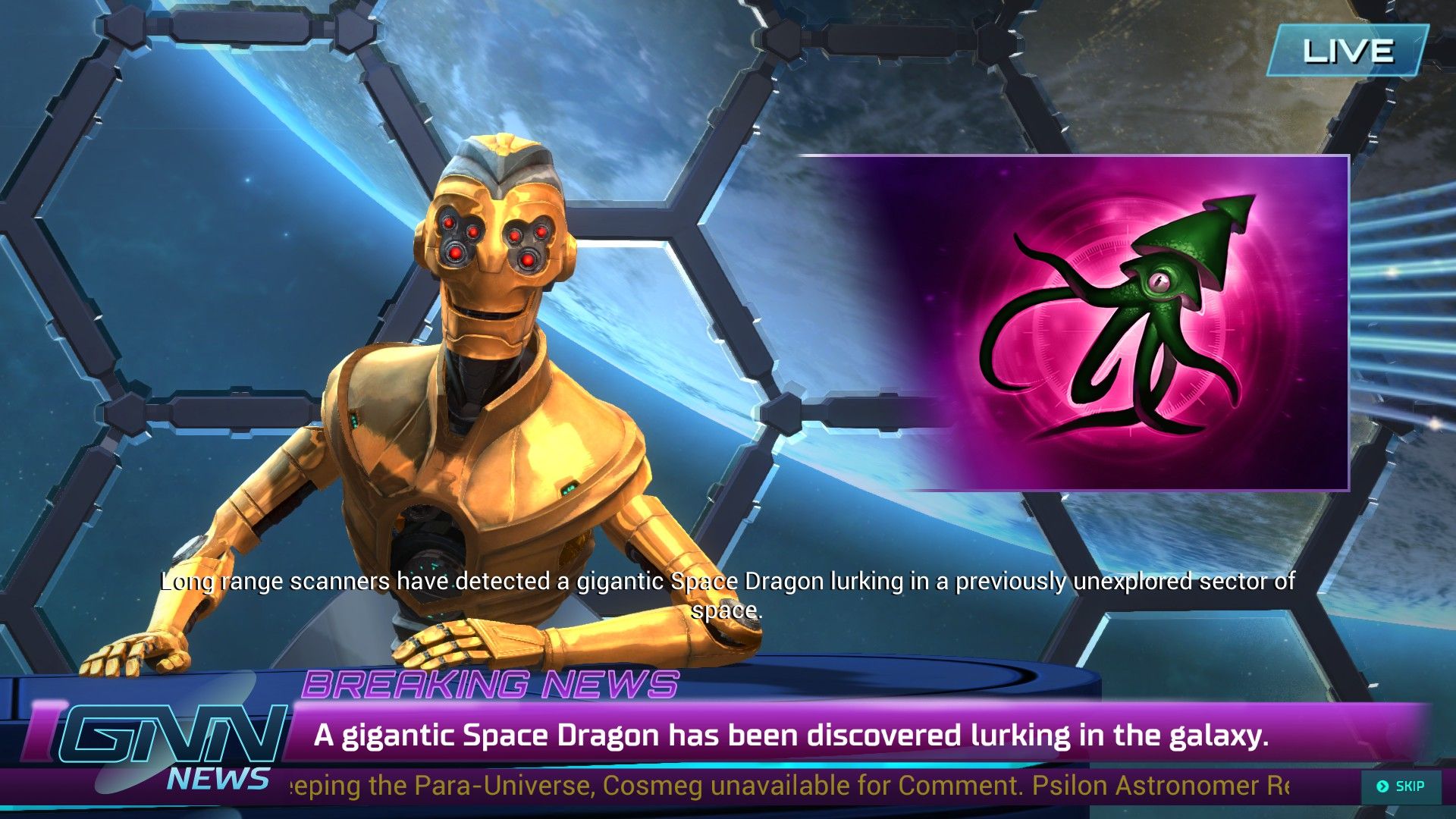  A year later, long-range returns from Pherd suggested the presence of something very large and alive in the system, something capable of moving about the system on its own power. This gargantuan lifeform dwarfs any Human ship designs, and may be far beyond Human capability to challenge. Events in the galaxy will occasionally give us reports from the robotic newscasters of GNN. I am not bothering to treat GNN as something that actually exists in the fiction, and may not present news reports dealing with things we'd have no way to hear of. Exploration over the past two decades has revealed the contents of four different systems, although only two of those have any planets that Humanity could potentially colonise. 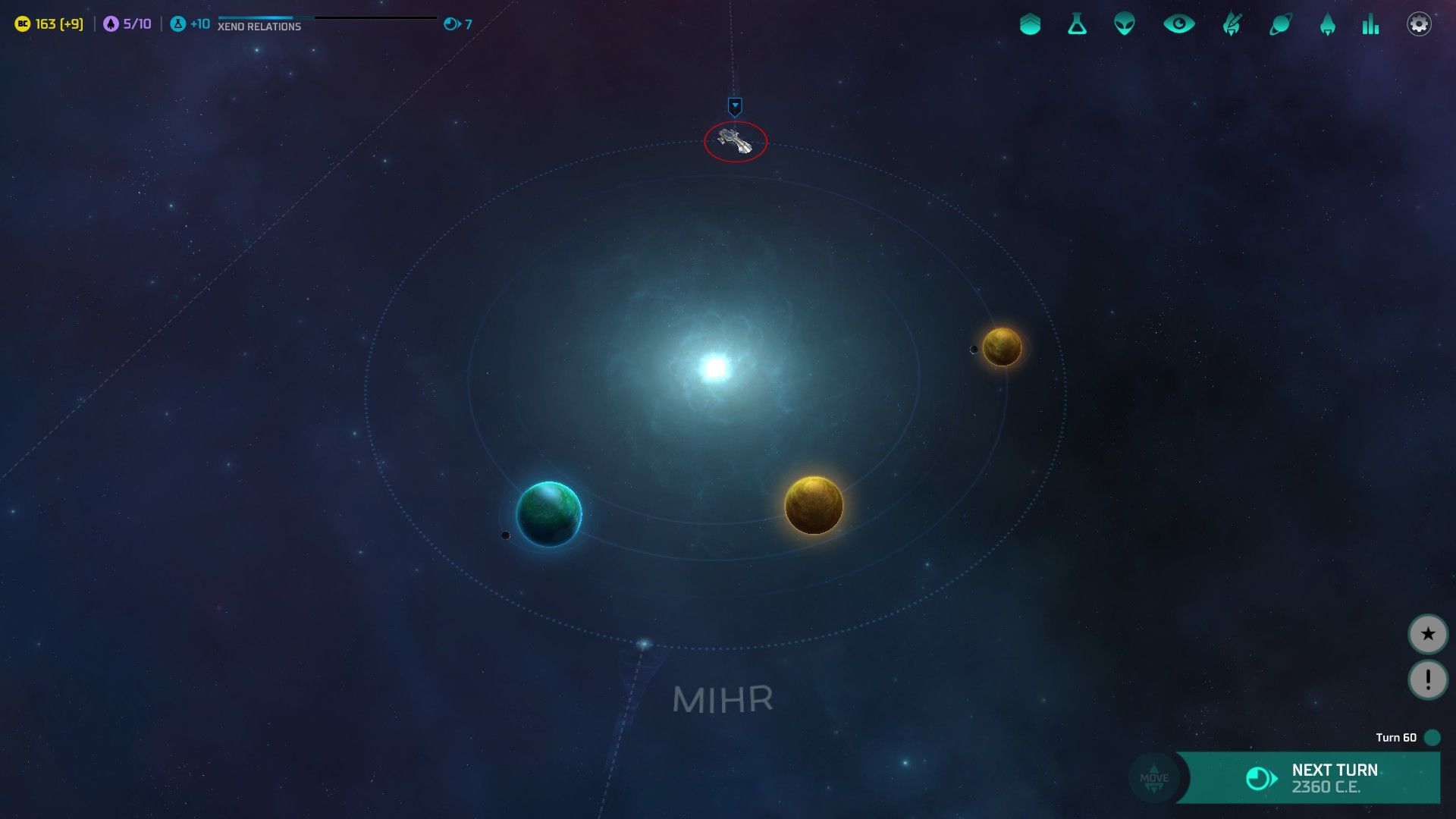  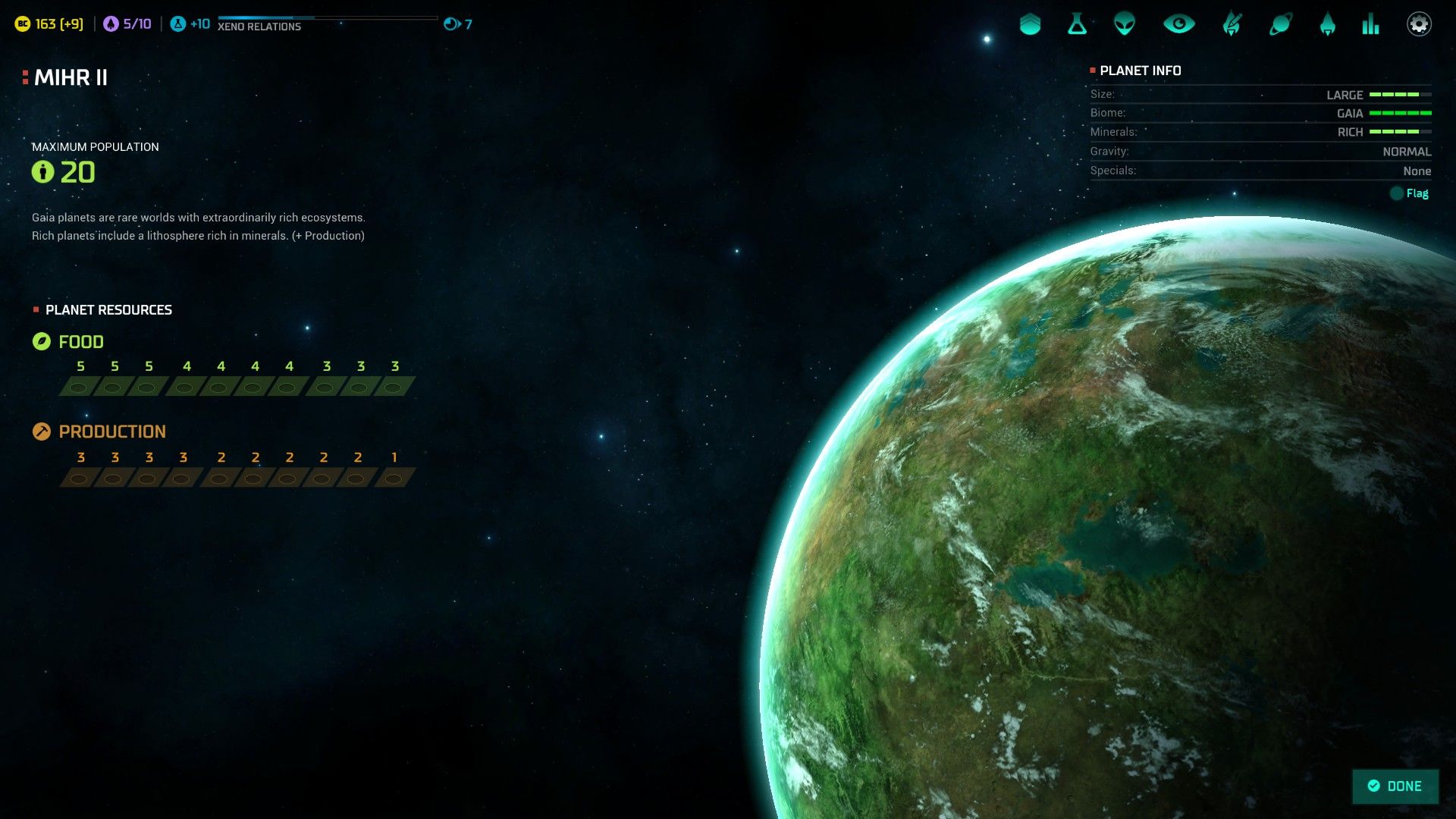 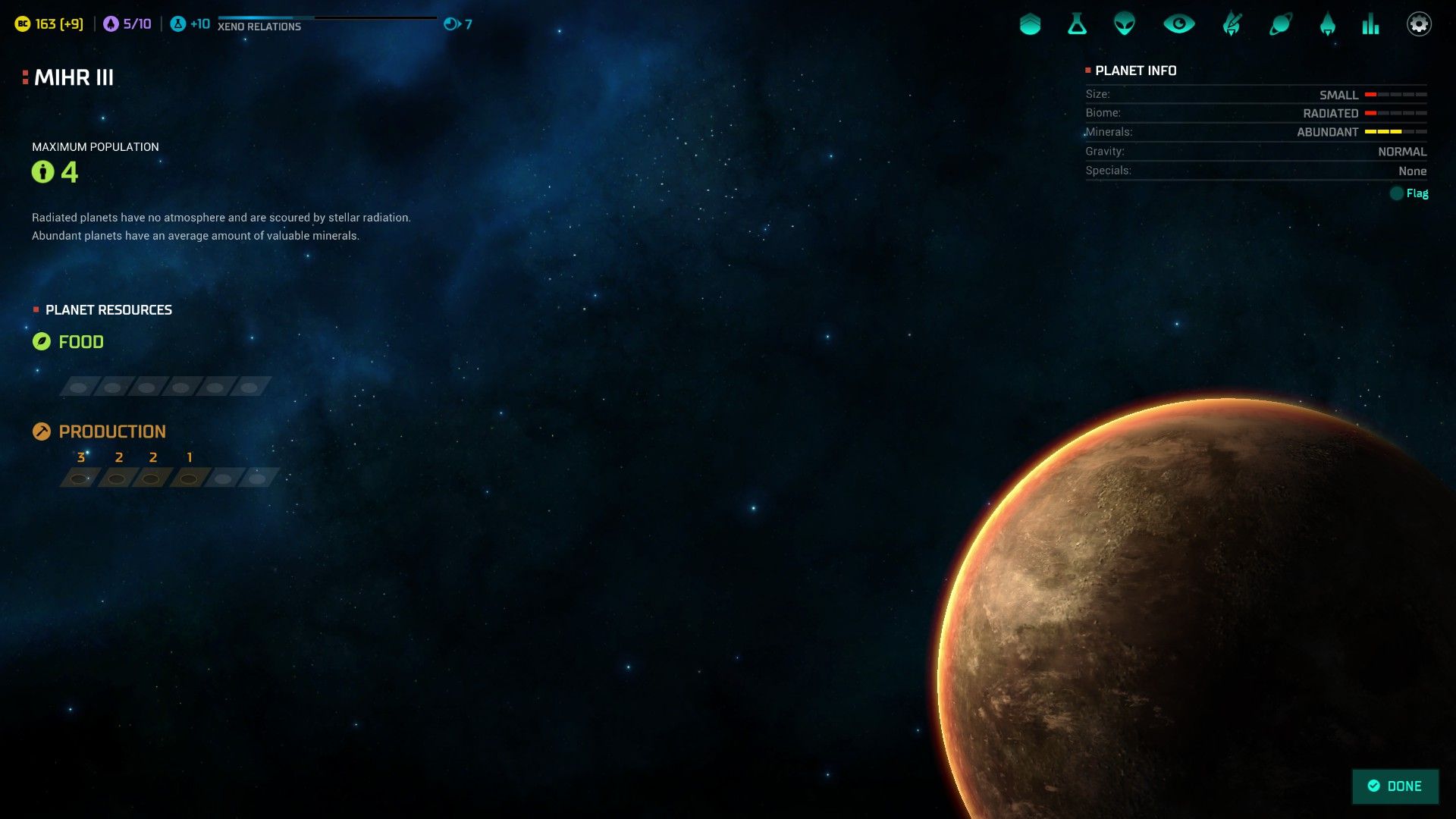 Mihr, the white star at the end of Sol's driftward conduit, has three worlds of potential interest. By far the most exciting of these is Mihr II, or Paradise. Paradise is a warmer, moister world than Earth, with a higher atmospheric carbon dioxide concentration and wide, warm seas. This has resulted in weather patterns with abundant precipitation across the entire planet, moderation of the worst temperature extremes by the close proximity of oceans, small ice caps, and a superb environment for healthy and fertile plant growth. Unlike Earth, Paradise has very few desert biomes, and massive forests and lush plains cover almost its entire land surface. What is more, Paradise is also larger and richer in heavy metals deposits than Earth, which should allow for greater room to expand and easy and profitable mining to support local industry. Mihr Prime and Mihr III, by contrast, are both hot, airless worlds baked by lethal amounts of Mihr's radiation. Mihr Prime is approximately the size of Earth, and is rich in both industrial metals and easily-accessible gold deposits, while Mihr III is notably smaller than Earth and mostly unremarkable in composition. Mihr Prime might be modestly interesting, given advancements in technology making hostile environments somewhat less forbidding to colonise, while Mihr III seems to be of little value. I will confess that I was startled to see we had Paradise right next to us in the Mihr system, after what we already had in Tarazad. Paradise even beats out Tarazad Prime. 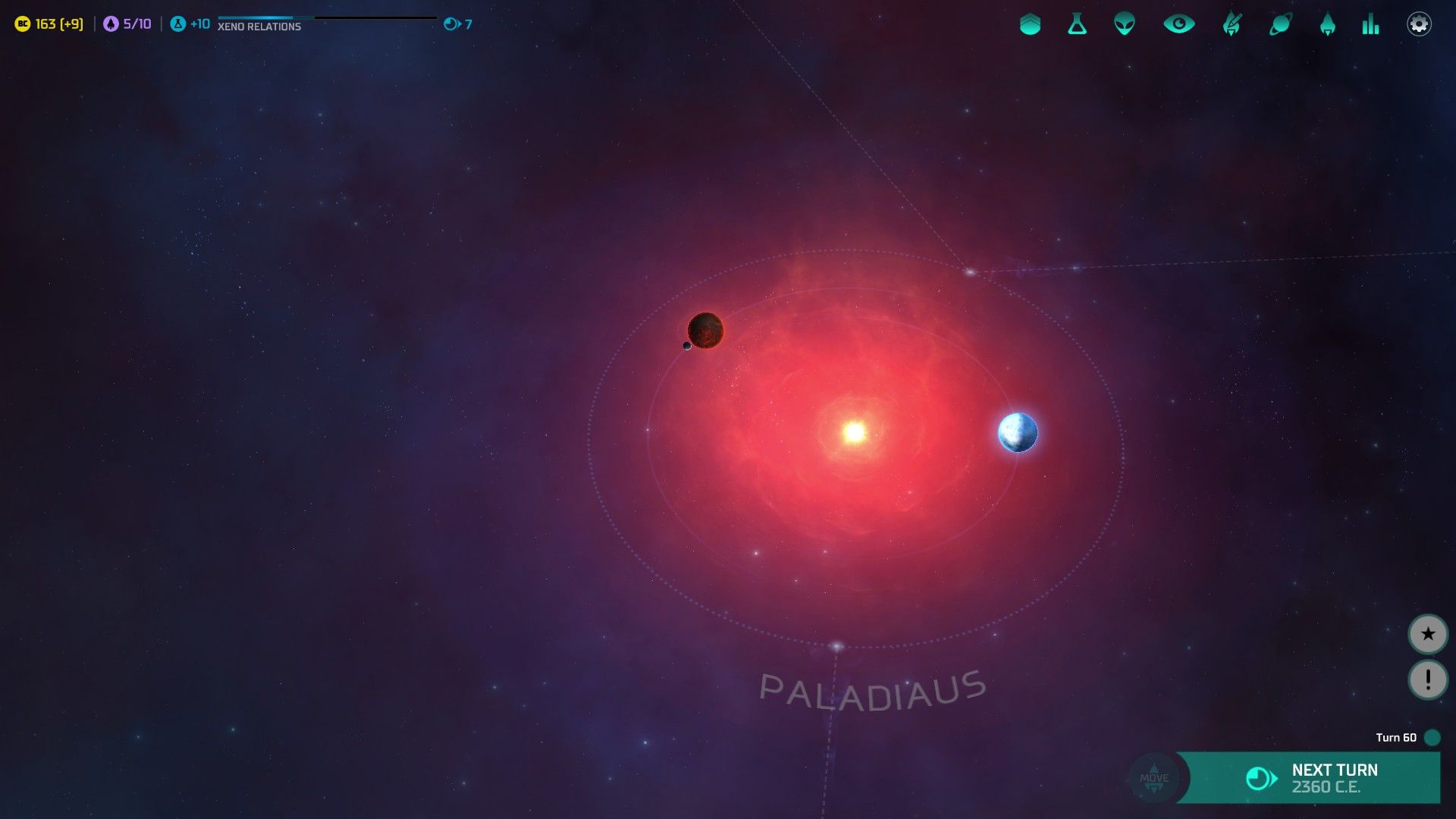 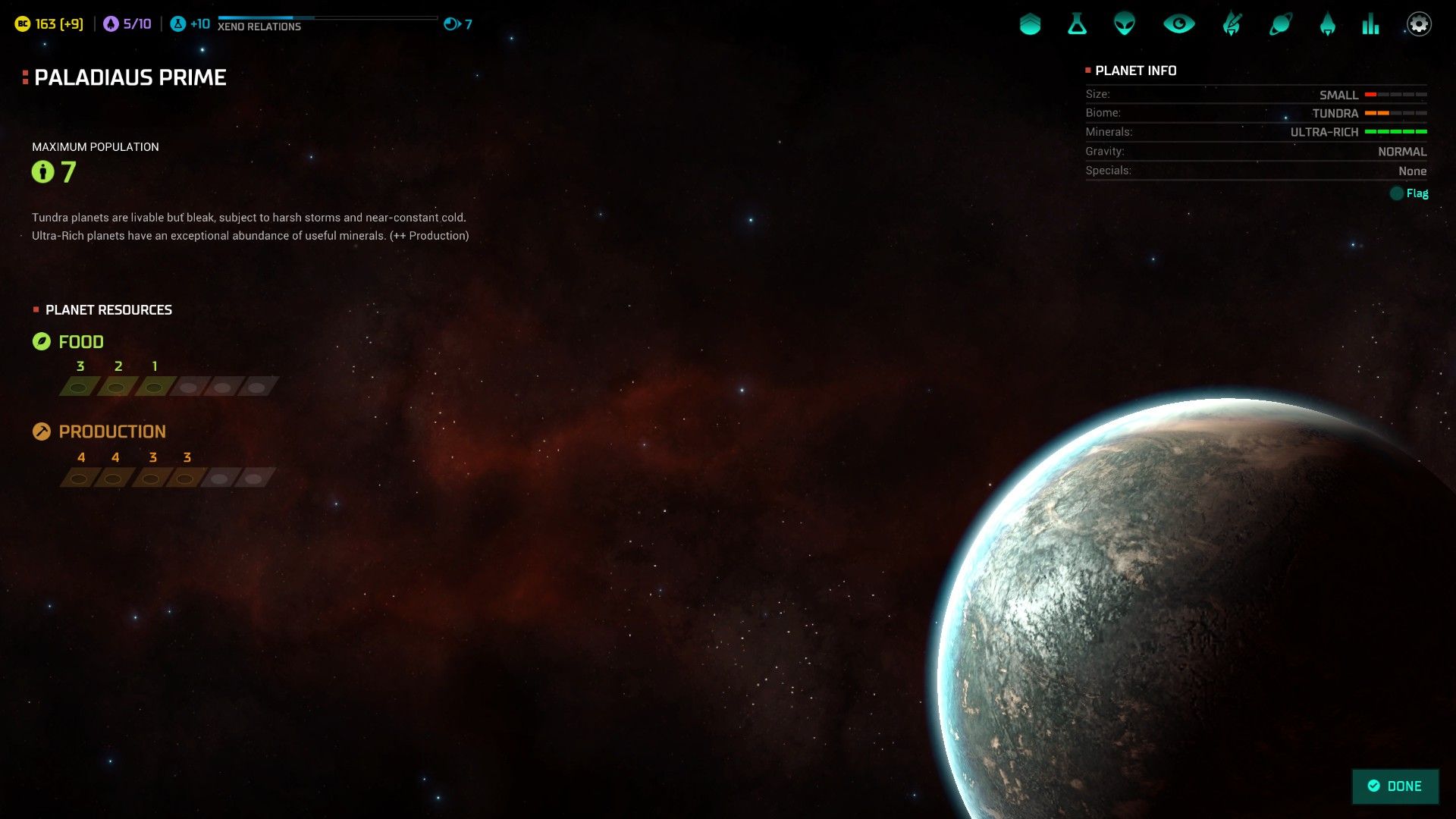 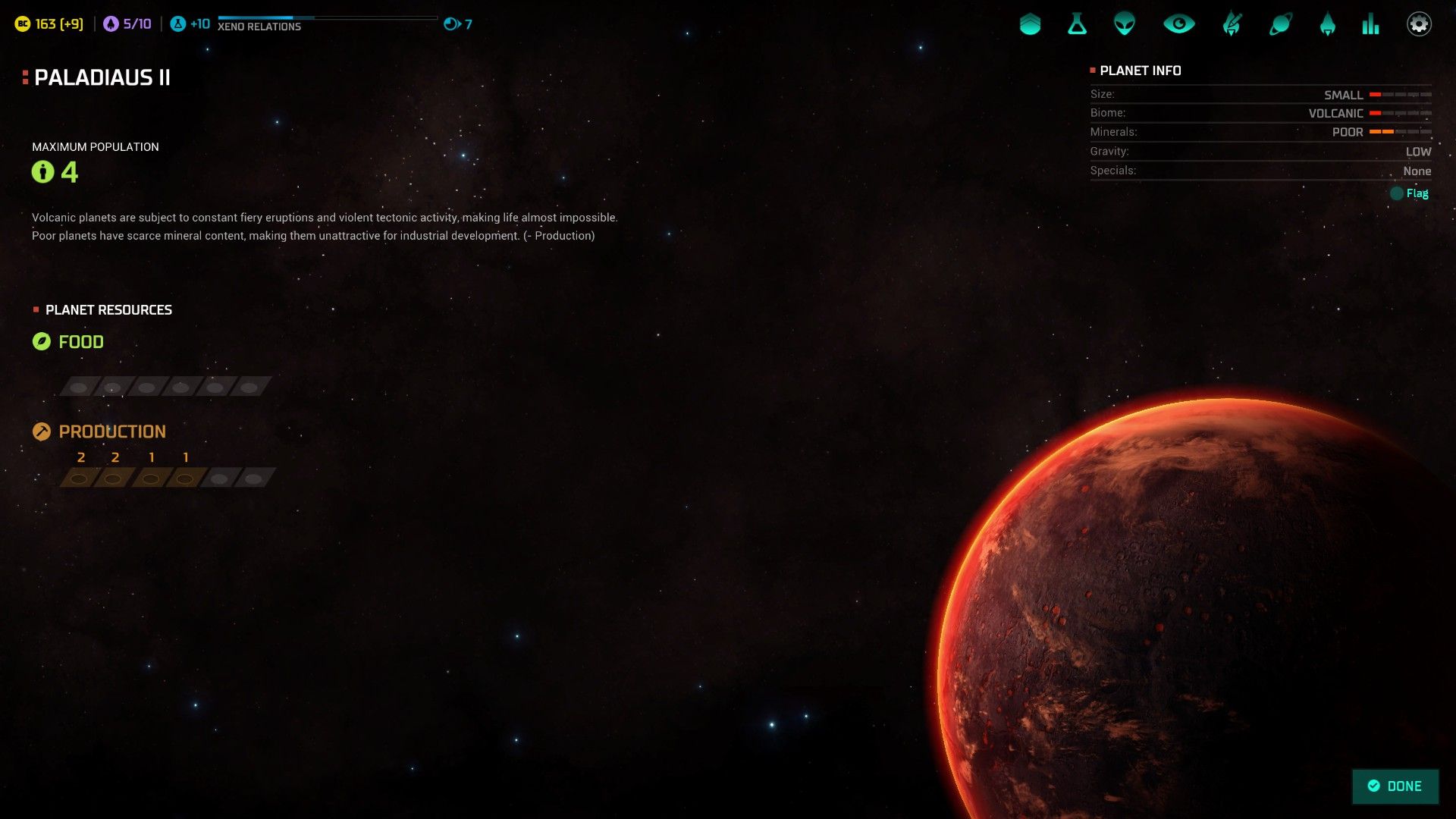 Paladiaus, a cool red star far driftward along the rim, has two planets of potential interest. Paladiaus Prime is a small planet largely covered by frozen water, with a fairly thick inert atmosphere primarily consisting of nitrogen. The planet is harsh, bleak, and lifeless, although the abundance of water would make colonisation and agriculture relatively simple. What makes Paladiaus Prime truly interesting is the staggering density of metals deposits in its crust- immense quantities of titanium, iron, copper, tungsten, chromium, and assorted rare earths and fissionables are scattered all over the planet. The mineral wealth locked in Paladiaus Prime is nearly incalculable. Paladiaus II, on the other hand, is remarkable largely for the almost unchecked vulcanism and tectonic activity on the planet, which constantly releases searing clouds of toxic vapors through the caustic atmosphere and produces an ever-shifting collage of lava lakes dotting the landscape. Despite this immense tectonic ability, Paladiaus II is generally poor in most useful minerals, unless one has a compelling need for flowstone, volcanic glass, or pumice. 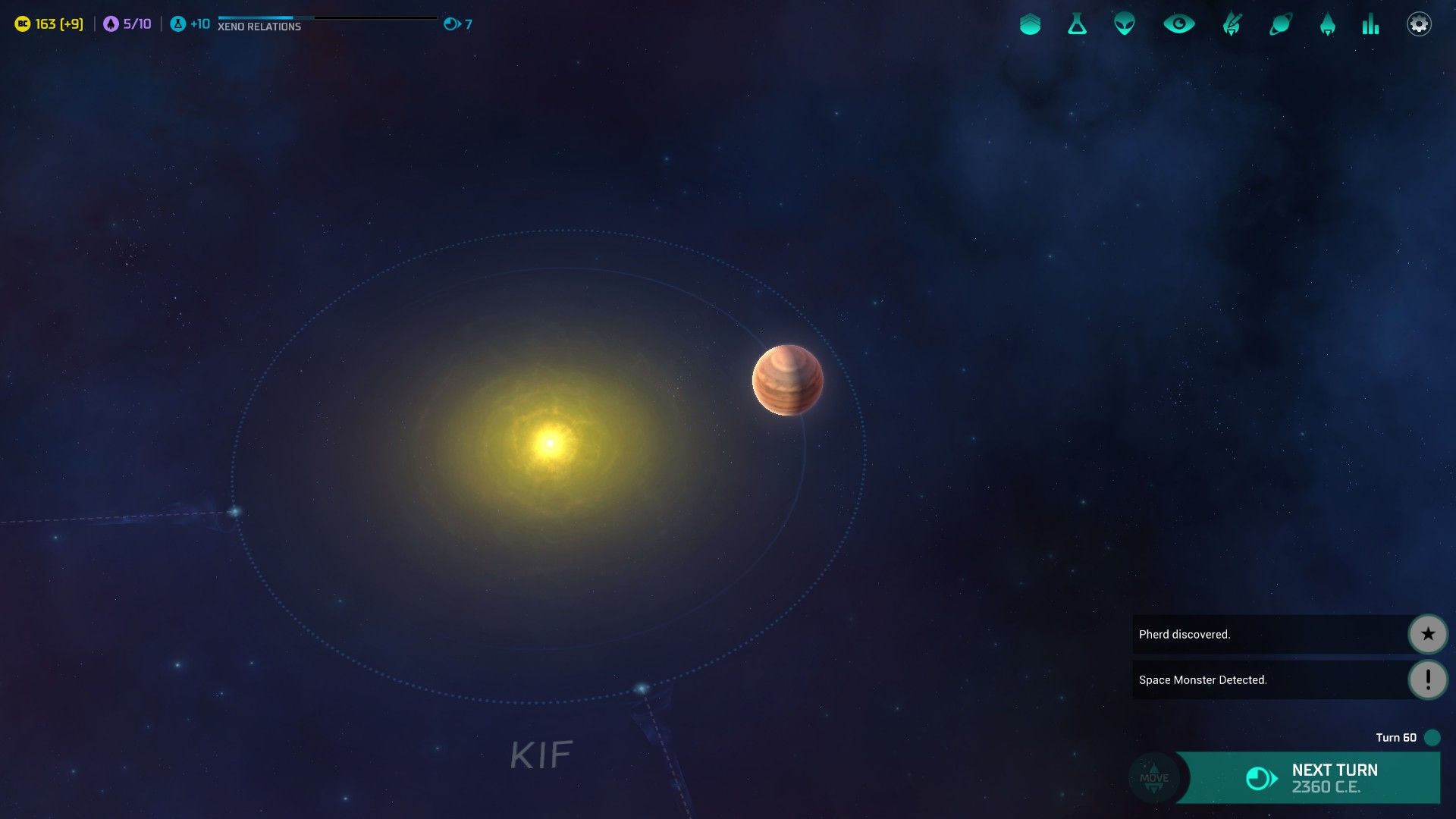 Around Kif, little orbits save a lonely gas giant and the now-looted wreckage of the ancient Lobok Advanced Technologies facility. Although the gas giant might have been of some industrial interest, without a planetary colony to supply mining operations, it cannot be economically exploited. Mining gas giants or asteroids takes a colony in the same system.  Warikomi is much as was anticipated of most brown dwarves, lacking any planets but with a thick belt of asteroids and debris surrounding it. Human pirates and exiles have cobbled together a crude and functional society here, under the rule of a harsh warlord 'admiral'. The Human Republic and Known Space as of 2360 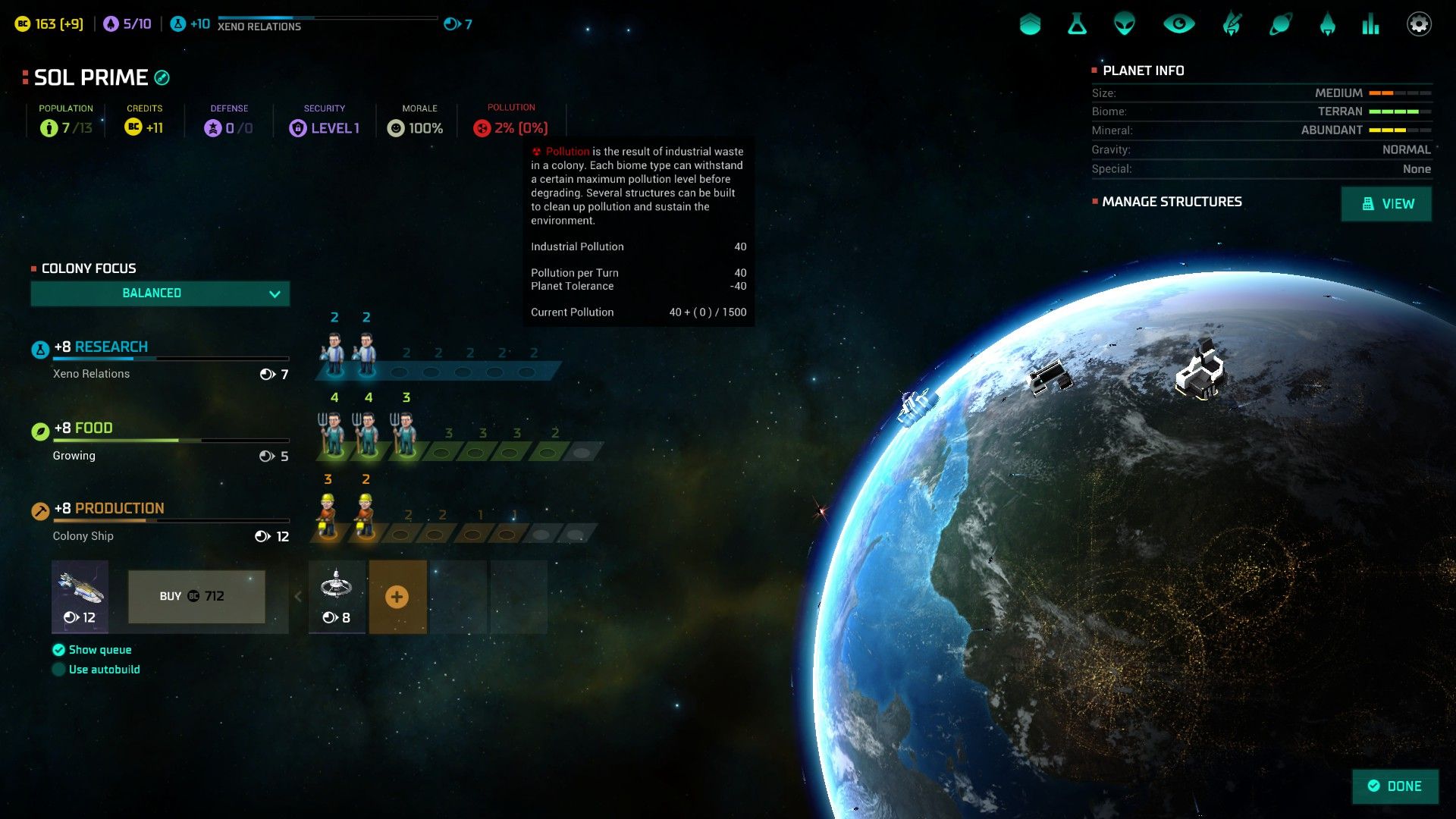 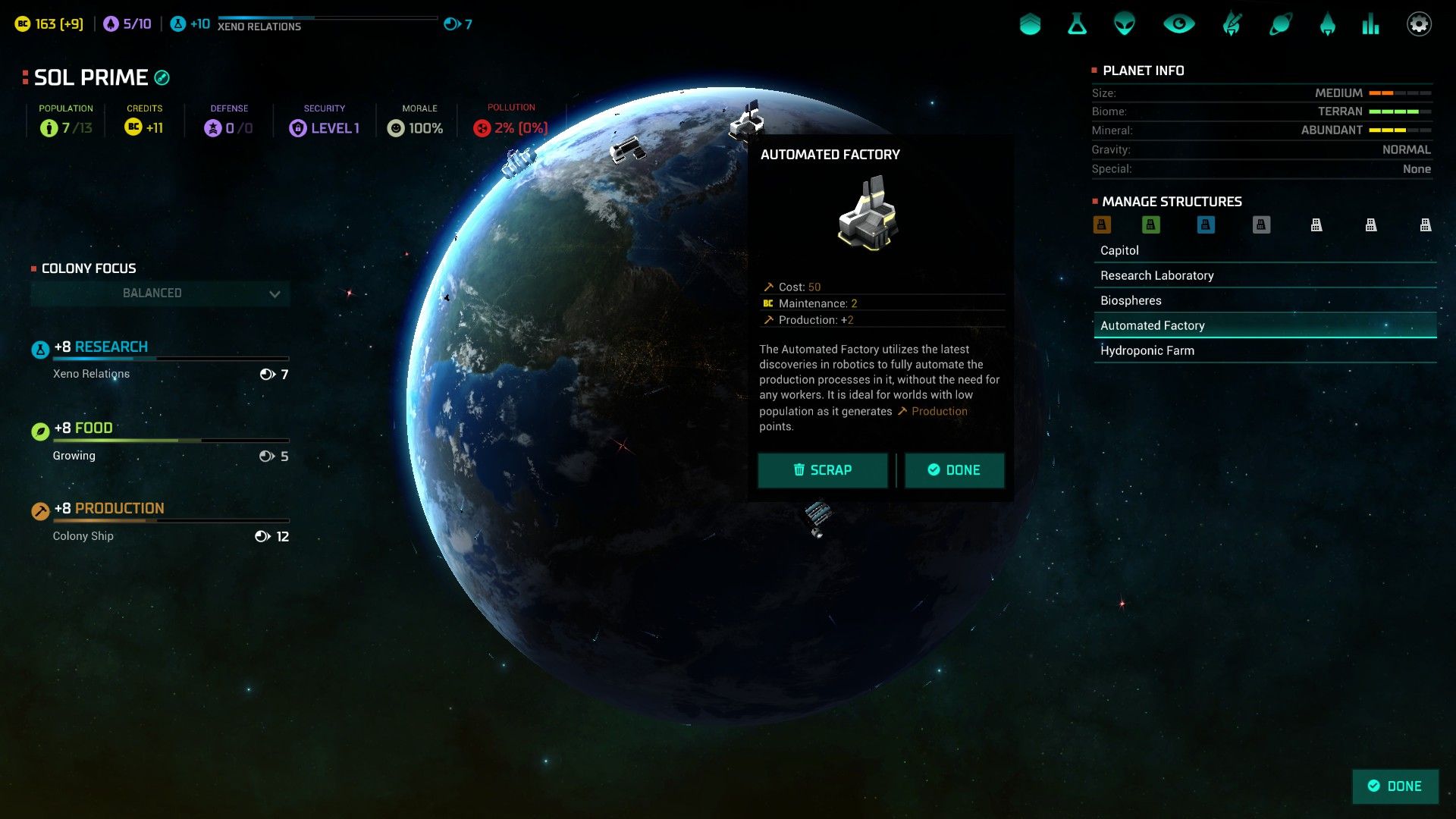 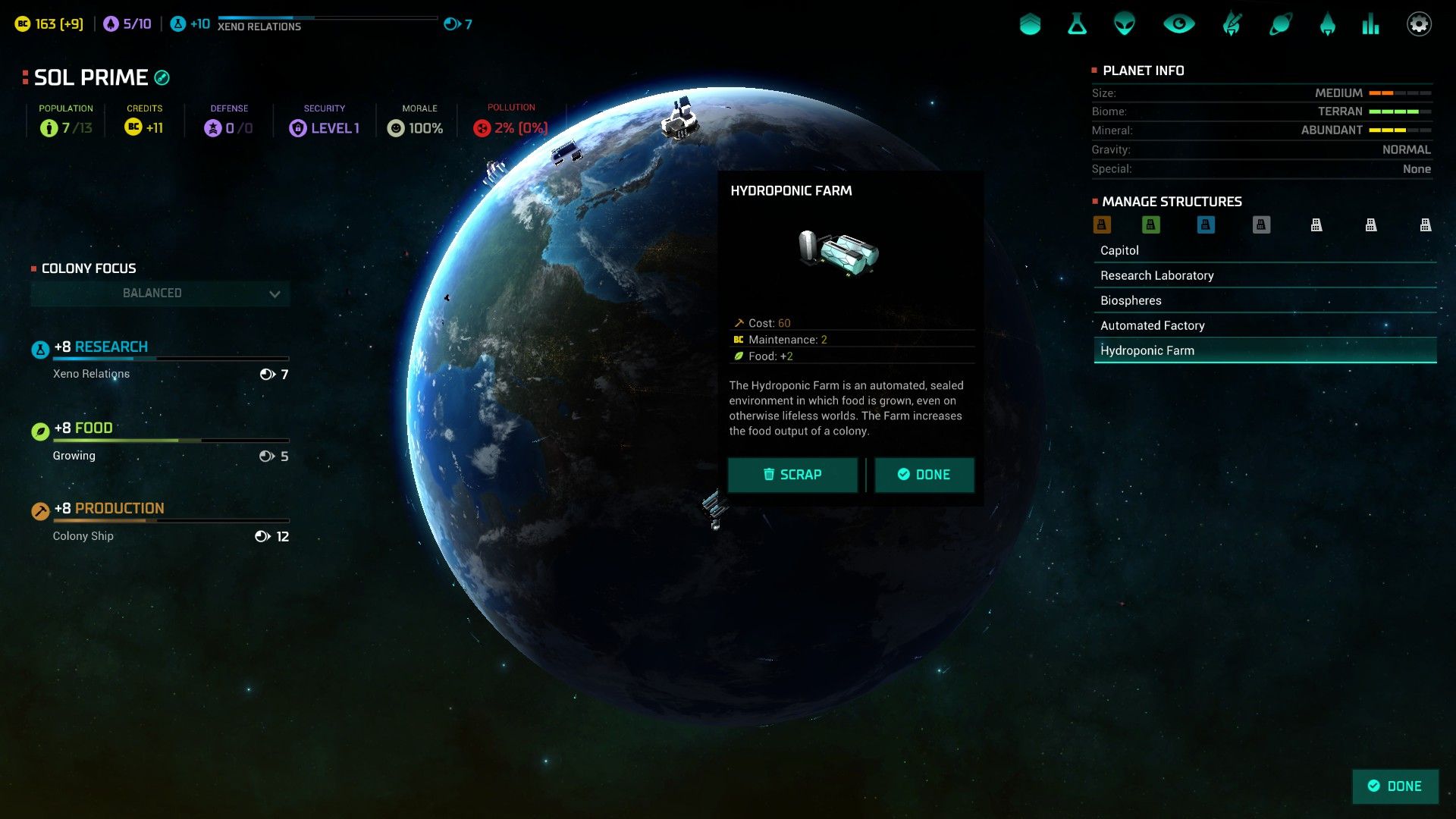 Earth now exceeds 7 billion persons in population, with improved industrial techniques and industrial-scale hydroponics cultivation boosting industrial and agricultural yields on the planet, and its prosperity, even as the assembly of a massive colony vessel to establish a new home for Humanity is under way. Some ecological interest groups suggest that further industrial development of Earth might result in long-term environmental degradation, although as of yet there is little danger. The heavy demands of new infrastructure for supporting specialty industries and qualified technicians have begun to cut into the accumulation of future investment capital, although the improved productivity and prosperity of the planet is surely worth it. We've seen a slight dip in net annual income due to maintenance costs. Planets can suffer from pollution as follows- each turn, the planet's Tolerance (which is based on planetary biome- Terran and Gaian planets have a low Tolerance of 40, with less friendly planets being more Tolerant. Toxic, Radiated, and Volcanic worlds entirely ignore pollution- after all, it's not like tossing your industrial byproducts out the airlock will make things worse outside.) is deducted from however much accumulated pollution was on the planet, to a minimum of zero. Then, five points of pollution are generated for every point of production produced on the planet. If pollution accumulates up to the limit of 1500, Bad Things Happen. This means one extra unit of industrial labor would eventually cause catastrophe, if left alone for 146 years. If you reduce a planet's production below the Tolerance level, accumulated pollution will slowly recover, and devoting the planet's industry to pollution cleanup efforts makes it so that each production point eliminates five units of pollution rather than creating it. 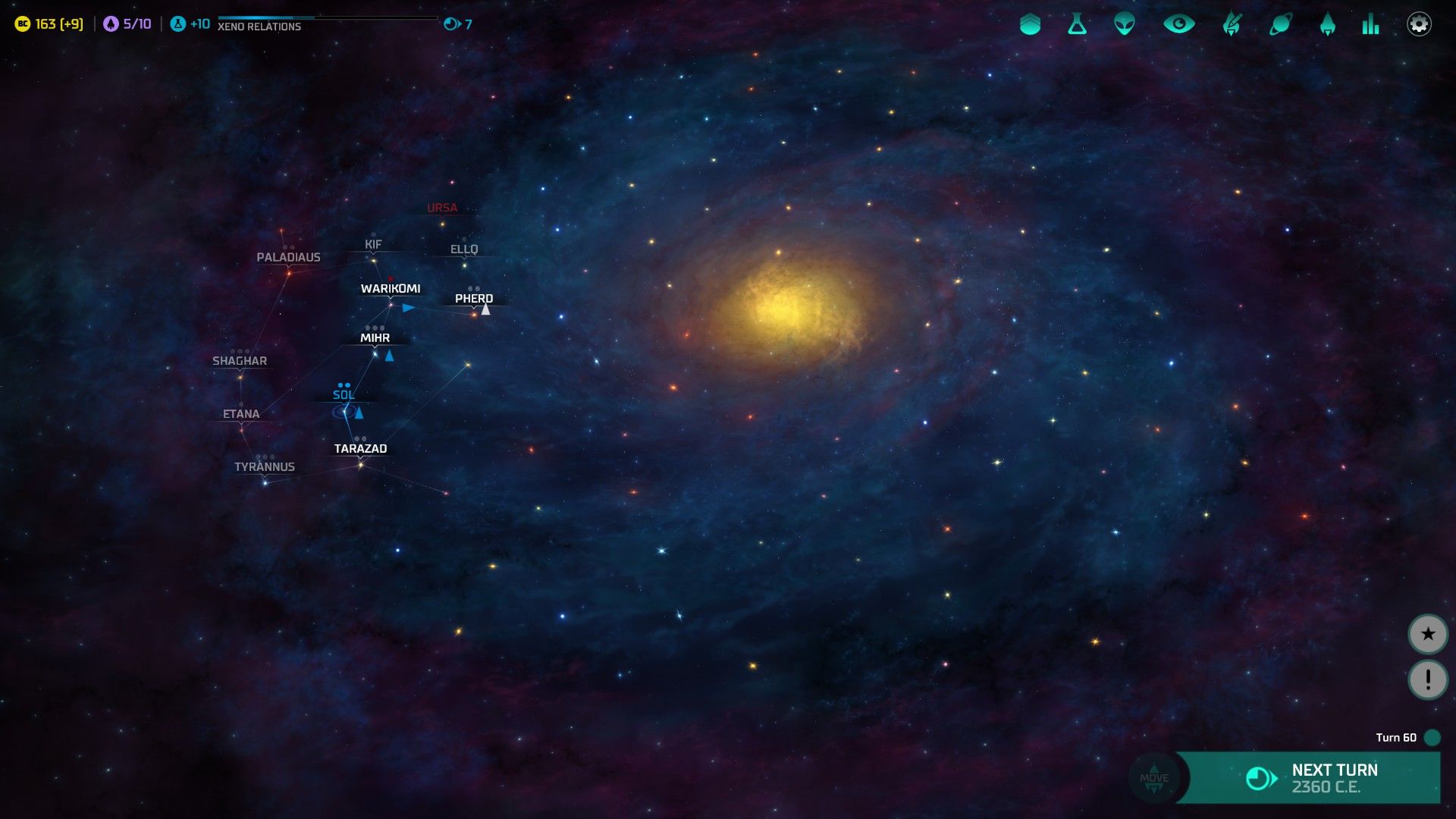 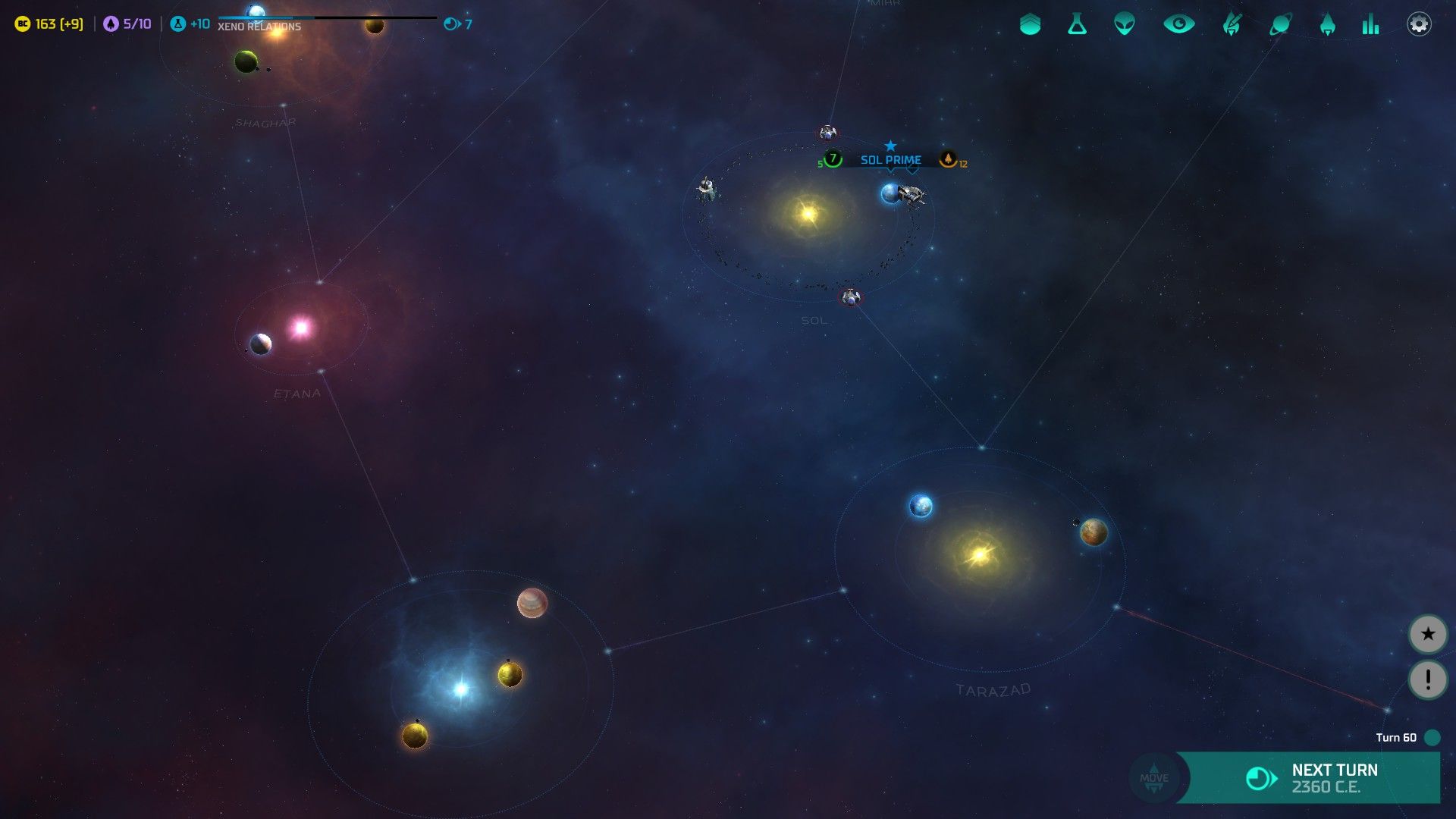 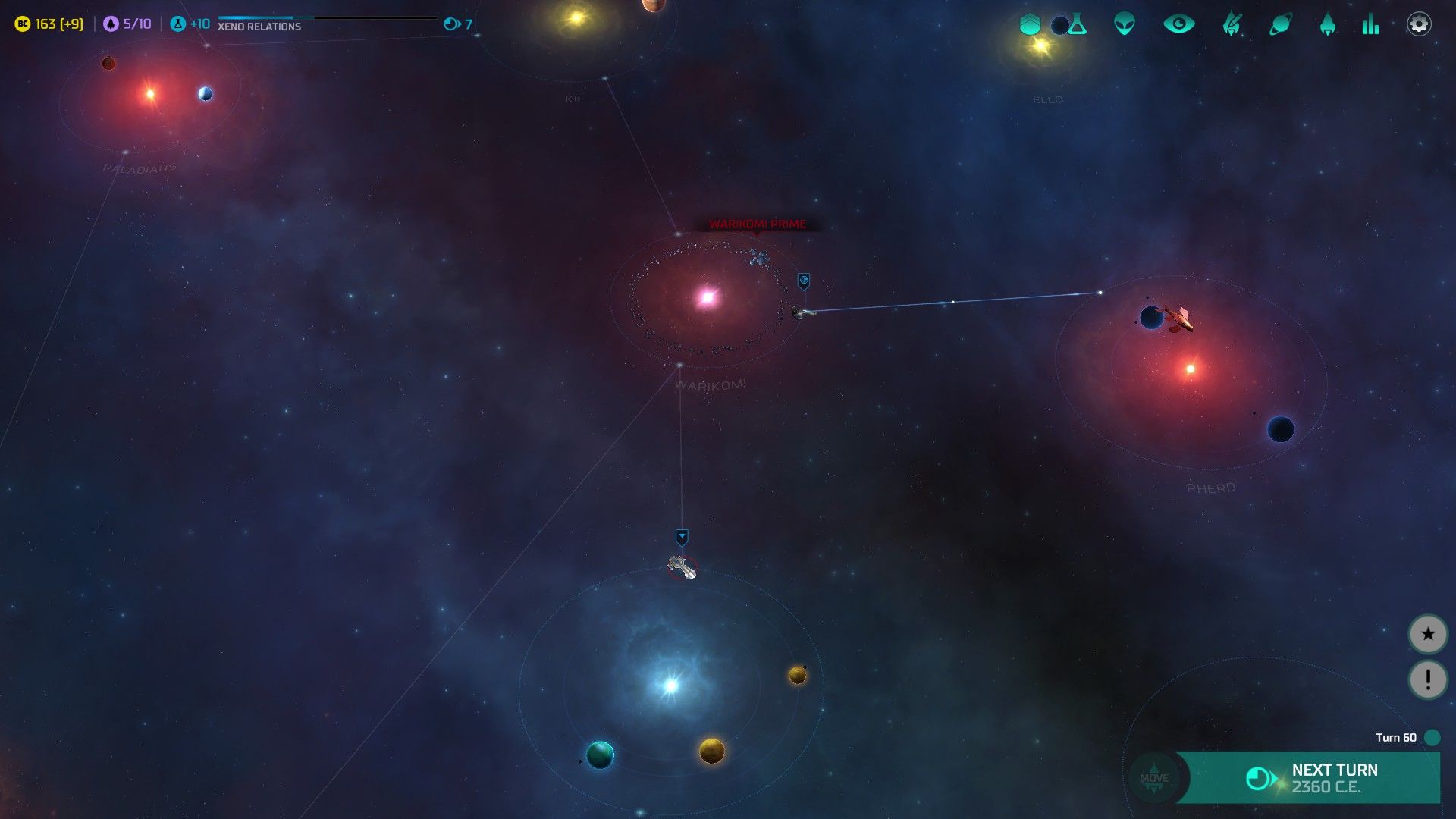 Continued exploration has helped fill in charts of the FTL conduits linking stars in this region, while the brief contact with the Bulrathi Empire has at least revealed the location of their home star, Ursa. The factory ship Industrious has returned to orbit of Earth, with little to do until new systems are colonised, while the Arbalest guards the Mihr system from intrusion and the Werner von Braun prepares for a frantic dash through the Pferd system, hoping to avoid attracting the attention of the massive fish-like 'dragon' in the system. There was some discussion of sending the Arbalest to assault the pirate settlement in the Warikomi system, but its weapons systems are poorly-suited for assault against the asteroid bunkers of the exiles. We need bombs to eliminate the pirate base. 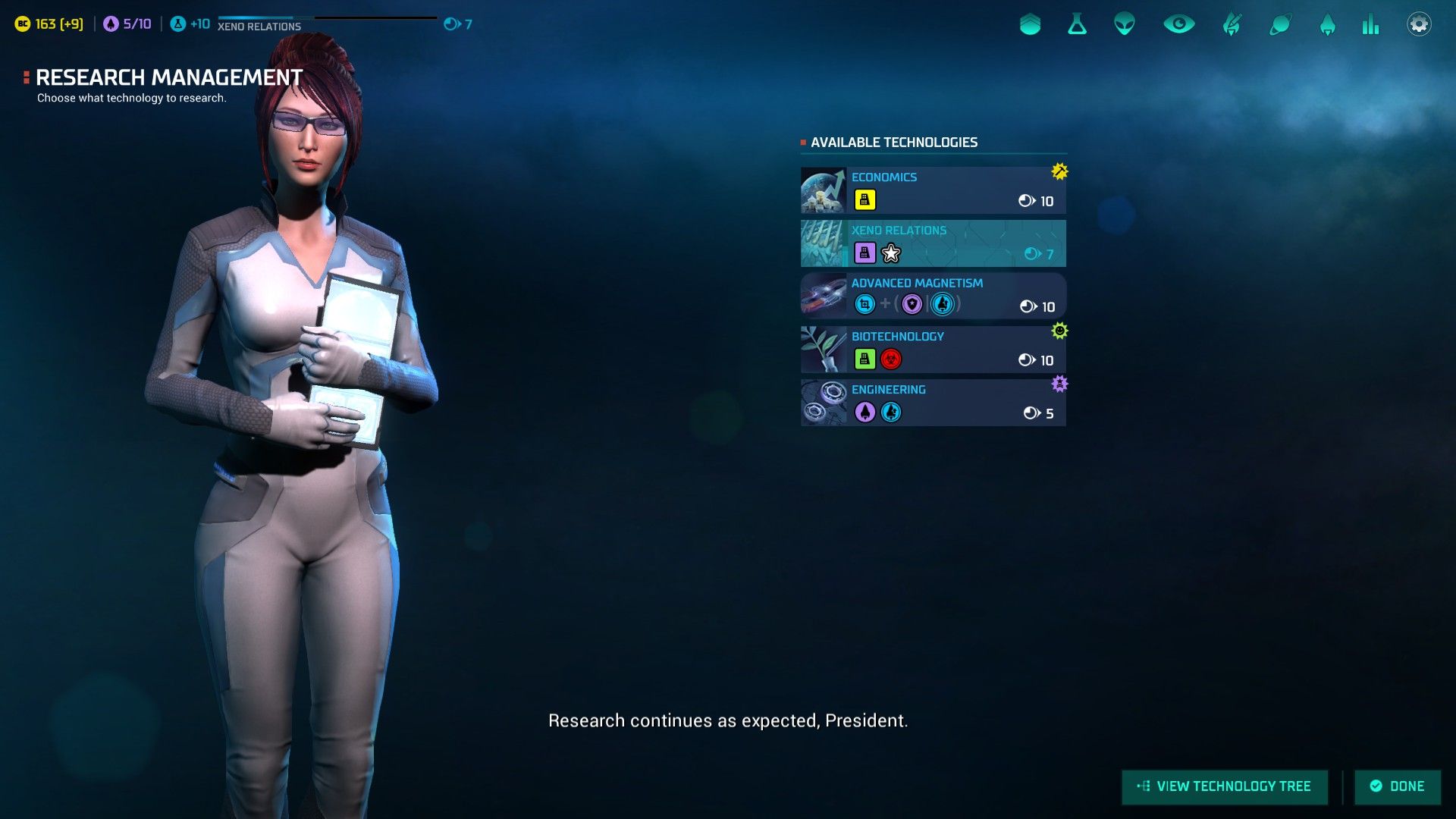 Although there had been significant interest in improving economic sciences and business methods, which had promised to gather the bulk of the research investment in the Republic, contact with the Bulrathi significantly changed the focus of research departments and universities across Earth. Nothing seems so critical at this time as developing a fuller understanding of Bulrathi language and culture, and the organisation of an effective diplomatic corps to open communications with the Bulrathi Empire. Quieter discussions in the legislature focus on the challenges of an interplanetary intelligence and counterintelligence service capable of helping safeguard the Republic's interests. Proposals for the People of the Republic Research Priorities Despite the frantic work ongoing to develop a science of xenology, develop a new diplomatic corps, and adapt to the presence of an active alien society in contact with Humanity, other research work continues quietly in the background. Improved economic research parallels efforts by businesses and the government to restructure operations for efficiency and effectiveness, and some other laboratories quietly work on other projects. Specialised biotechnological solutions to the challenges of harsh, nearly-lifeless environments, continued research into the quirks of magnetism, improved spaceframe engineering, and a quiet set of corporate initiatives for more efficient research and mining operations all enjoy a tiny trickle of funding at the moment, although it is certain that more funding will be diverted to at least one of these fields of study as other breakthroughs occur. Please vote on Biotechnology, Advanced Magnetism, Engineering, or Private Funding for future research, following breakthroughs in Xeno Relations and Economics. Please note that Engineering is the least expensive of these research projects, and Private Funding the most expensive, as Engineering is a first-tier technology, Xeno Relations, Economics, Biotechnology, and Advanced Technology are all second-tier, and Private Funding is third-tier. Military Appropriations The Joint Chiefs of Staff have submitted a request to the legislature for approval of appropriations for a new attack cruiser equipped both for basic space control duties and for surface attack suitable for rooting out the pirates in Warikomi- the Joint Chiefs of Staff as a whole are eager to hunt down and eliminate this threat. Some voices in the Joint Chiefs of Staff also argue for finally completing the half-finished military station over Earth, despite the industrial burden this project may present. Please vote yea or nay on appropriations for a new vessel for the Space Fleet, and yea or nay on completing the star base. Ship design proposals for the new vessel, which is required to be capable both of ground attack, mounting at least one bomb, and space control, mounting anti-ship weapons, will be accepted. Colonisation Efforts The discovery of Paradise has delayed any thoughts of the first Human colony world being Tarazad Prime. In fact, Paradise is such a promising new world, it seems likely that a major second wave of emigrants from Earth will follow the initial colonisation wave. Please vote on whether to dispatch a civil transport after the colony ship in order to give Paradise a population of 2 more quickly. In general, I will not send civil transports unless somebody makes their own proposal to send civil transports between two colonies. Diplomatic Stance Many firms on Earth are eager to take advantage of the opportunity for trade with a new and exotic alien species, and Annette Couture, the Human Republic's current president, hopes to establish at least basic diplomatic relations with the Bulrathi Empire. Ultimately, however, the legislature must agree to any foreign overtures. Please discuss what you would like to see from our diplomatic efforts with our new contact. By default, we can establish an embassy and open trade relations, which will require a very modest bribe to get the Bulrathi to agree to the embassy, which will provide some basic information on the Bulrathi Empire from our diplomats' observations, and an initial sum of credits to fund a trade treaty, which will dramatically increase our income over the next twenty years and improve relations with the Bulrathi. Our diplomats can also investigate what might be required for a cooperative research agreement, technology exchanges, or a non-aggression pact, or we could, hypothetically, not seek to establish an embassy at all, ensuring colder relations and preventing any other agreements. There is an extremely strong desire for at least the basic 'embassy and trade' arrangement, however. Please vote on this matter. Other proposals may be considered. The past decades have revealed startling new things in the galaxy- a planet significantly friendlier to life than Earth itself, an alien species active in the present day amongst the stars, the bizarre space-dwelling alien life in Pferd, and more hints about the ancient Orion Confederation. Many of these developments seem hopeful to many Humans, but only time shall tell the full implications of what Humanity has discovered over these years. nweismuller fucked around with this message at 12:00 on Oct 3, 2016 |
|
|
|
Current ship design parameters: 575 tons available displacement, 10 production base cost for frigate hull. Three weapons slots and three special slots. SPECIALS Augmented Engines: 125 tons displacement, 10 production. Improves mobility, strategic speed, and evasion against direct-fire weapons. ECM Jammer: 150 tons displacement, 12 production. 25% chance of jamming and diverting any incoming missile. WEAPONS LASER AND NEUTRON CANNON Please bear in mind cannon damage drops off at range, and hits at the extreme edge of the range envelope tend to do no damage at all. Point-Defense Laser: 20.4 tons displacement, 1 production. 10 range, 2.25 seconds between shots, 2.5 damage, 25% accuracy bonus, automatically engages incoming missiles. Standard Laser Mount: 60 tons displacement, 2 production for front or rear mount. 75 tons displacement, 3 production for sides mount. 90 tons displacement, 4 production for 360 degree mount. 50 range, 3 seconds between shots, 5 damage. Autofire Laser Mount: 90 tons displacement, 3 production for front or rear mount. 112.5 tons displacement, 4 production for sides mount. 135 tons displacement, 6 production for 360 degree mount. 50 range, 1.5 seconds between shots, 5 damage, 20% accuracy penalty. Heavy Laser Mount: 90 tons displacement, 4 production for front or rear mount. 112.5 tons displacement, 6 production for sides mount. 135 tons displacement, 8 production for 360 degree mount. 75 range, 3.75 seconds between shots, 10 damage. Heavy Autofire Laser Mount: 120 tons displacement, 5 production for front or rear mount. 150 tons displacement, 7 production for sides mount. 180 tons displacement, 10 production for 360 degree mount. 75 range, 1.88 seconds between shots, 10 damage, 20% accuracy penalty. Neutron Cannon: 80 tons displacement, 5 production for front or rear mount. 100 tons displacement, 7 production for sides mount. 120 tons displacement, 10 production for 360 degree mount. 50 range, 3 seconds between shots, 9 damage. MISSILES Missiles have slow travel speeds and are vulnerable to jamming and PD. Nuclear Missiles: 100 tons displacement, 4 production. 60 range, 11 seconds between shots, 20 damage, 2 HP warhead HP. BOMBS Bombs are exclusively for ground attack. Nuclear Bombs: 100 tons displacement, 4 production.
|
|
|
|
Libluini, frigates are limited to three distinct types of weapons (and this includes arcs and modifications, so a forward mount laser is different from a sides mount laser is different from a heavy sides mount laser...). Your proposed design mounts four different types of weapon system, and thus is not a valid design.
|
|
|
|
Libluini posted:Also, in the time it takes to launch another salvo of missiles, the PD-lasers can shoot almost five times at the old one. It does not take 11 seconds by a long shot for missiles to cross the last 10 range to their target. Your statement assumes that missiles are in flight for the entire 11 seconds between salvos, and that they're in point defense range for the entire time they're in flight, neither of which applies. That said, 5 point defense guns is a respectable quantity. nweismuller fucked around with this message at 17:02 on Oct 3, 2016 |
|
|
|
Mechanical Ape posted:Space superiority is the best way to ensure peace and safety! Space monsters date at least back to Master of Orion 2; pirates had an implementation in MoO2 that was just 'station ships in this system to stop losing freighters and getting your trade income tanked' as one of the possible random events in that game (another was getting a chunk of your treasury spontaneously stolen by pirates). I forget if any piracy implementation existed as one of the random events in Master of Orion 1. Either way, the monsters in this game are simply continuing the legacy of MoO2, and I imagine the pirates are an attempt to make the original pirate random events look more interesting with actual ships and bases.
|
|
|
|
Humanity and the Human Republic in the 24th Century Humanity in the 24th century, after a long history of internal conflict and tyranny, is united and free. Equality under the law, freedom of conscience, freedom of speech, and freedom of trade are enshrined as inalienable Human rights. Citizens are protected by law against searches and surveillance without due process, which the courts fiercely enforce. The Human Republic is structured as a federation, with significant autonomy by member states to set policy within constitutional bounds, and with a federal government primarily concerned with high affairs of defense, foreign affairs, and justice. The specifics of the responsibilities of the Republic's member states vary, with the Republic's constitution providing fairly wide latitude for the questions to be decided by local democracy. The economy is primarily dominated by a diverse and changing collection of private firms, and internal trade is conducted with vigor and enthusiasm. The Federal government is modelled in at least partial imitation of the original structure of the United States of America, and is divided into legislative, executive, and judicial branches. The legislative branch, which is generally seen as the most powerful of the three branches, consists of a Senate, with each member state appointing a Senator for ten-year terms by whatever means is specified by their own internal laws (most commonly appointed by the legislature of that member state), and a Popular Assembly, with members elected to two-year terms by popular vote and with members per state weighted by population. Senators are constitutionally limited to a single term in office, while Assemblypersons may serve up to four terms. The executive is headed by a President, elected by popular vote to five-year terms, to a maximum of two terms in office. The judicial branch is headed by a Supreme Court, whose members are nominated by a popular vote eliminating any candidate who cannot command at least 10% of the popular vote, then with the legislature confirming an appointee from the nominees. The legislature maintains several specialist advisory boards, amongst the most prominent of which are the Senate Scientific Committee, which has the responsibility to brief the Senate on scientific and technical matters as they may impact upon policy, and the newly-formed Xenorelations Council, intended to provide any information that may be needed for developing ties with non-Human species. Although the Terran Revenue Service, responsible for collecting tax revenues from the Republic's member states, is properly speaking an executive agency, it frequently reports directly to the legislature, which has sole power of the purse in the Republic's federal politics. The Joint Chiefs of Staff under the President head the military, the most prominent arm of which at this time is Space Fleet. There exist an Army, Navy, and Air Force on Earth, but their staffing and strength is minimal. The Coast Guard and Orbital Guard serve similar functions to each other in different environments, and remain well-staffed and active. Although a diverse and polyglot array of cultures and peoples exist in the Republic's various member states, English and Mandarin Chinese are the official languages of business for the federal government, and English remains the most common language of interstate business and science. There is hope amongst many Humans that Humanity can as easily accept whatever diversity of peoples exists amongst the stars. Humans in nuMoO have the following traits: Traders, Charismatic, Diplomats, -20% Security. Traders gives us a +25% bonus to all revenue generated by producing trade goods or entering into trade treaties, through Human mercantile culture and expertise. Charismatic improves the impact of our positive diplomatic actions on relations with other powers, reduces the impact of negative diplomatic actions, and improves the attractiveness of any offer we make to other powers in diplomacy- our diplomats are both skilled and dedicated. Diplomats lets us start with the Government technology, once we have Space Travel researched, and gives a +5% bonus to morale- the personal freedoms and patriotism of the Human Republic make for a happier, more satisfied populace. Finally, -20% Security means that our defense against enemy spies is crummy- even when we have a whole apparatus of Big Brother security measures in place, the Republic's hands are tied to use them effectively like other powers might. nweismuller fucked around with this message at 07:06 on Oct 4, 2016 |
|
|
|
Poil posted:Wait, so we might have bears sneaking around and gathering information on us without our knowledge? Very stealthy, those space bears. That said, I have very strong doubts we're getting spied on right now- I don't think they've pinpointed any of our colonies to infiltrate, and I'm pretty sure they don't have Xeno Relations researched in order to establish a Spy Center.
|
|
|
|
Looking over votes, it appears I need a tiebreaker for whether or not to send a civil transport to Paradise. I can start playing through the update as soon as I see one.
nweismuller fucked around with this message at 12:45 on Oct 5, 2016 |
|
|
|
I'm too tired to organise and upload images and do the writing for a full update now, but I can provide a little something from the Xenorelations Council. Please stand by.
|
|
|
|
Xenorelations Council Report: The Bulrathi and the Bulrathi Empire, 2367 The Bulrathi are the native sapient species of Bulra, a planet in the Ursa system. Bulra is both larger and richer in heavy metals than Earth, and as such has a surface gravity of approximately 1.4 G. The Bulrathi, adapted to this higher gravitation, are stocky and muscular- although they average approximately similar to Humans in height, they have notably greater mass, with powerful, ropy muscles and thick bones that bind iron in their structure to strengthen them. The Bulrathi are warm-blooded mammaloids covered in shaggy hair; they originally evolved in cold subarctic forests on one of the continents of Bulra's northern hemisphere, although they have since spread across all the land masses and climate zones of Bulra. The Bulrathi Empire has been shaped for the centuries of its existence by the twin forces of war and religion. The Empire originated as a regional nation-state centered on the original Bulrathi evolutionary region, led by a military aristocracy and guided by a line of religious leaders known as the 'Hags'. The military aristocracy hold essentially autocratic power over their holdings, with a widespread serf class and with an Emperor holding supreme power over the whole of the Empire; the Empire has slowly expanded into other territories through outright military conquest. The aristocracy, as part of their fitness to rule, are expected to personally serve in the battle lines as field leadership as long as they are physically fit to do so; any aristocrat who does not serve as needed can expect to be relieved of his holdings by the Emperor with the full support of his peers- or, in the rare historical cases where an Emperor refused to serve personally in battle, be assassinated by the lower aristocracy as unfit to rule. The Hag is the head of the Empire's religion, which can be understood as a form of animism holding that harmony with all living things will bring spiritual enlightenment and peace. A Hag names her own successor from amongst the network of wise women that serve as spiritual advisors to the 'lodge' estates of the aristocracy, or occasionally even from those who minister to the serfs or freemen of the Empire. The current Emperor of the Bulrathi is Grorvog, a veteran of the last campaigns to unify Bulra in the early 24th century. Current Bulrathi society balances between the military power of the Emperor and the aristocracy, the religious guidance of the Hag and the wise women that provides a unifying touchpoint for the Bulrathi, and the economic and technical power of prominent freemen, needed to maintain a high-technology spacefaring society. Although the aristocracy is fairly linguistically and culturally homogenous, drawn from the original territories of the Empire, successful freemen are far more varied in origin and language, representing essentially every cultural-linguistic group on Bulra. Bulrathi religious doctrine encourages careful preservation of large wilderness reserves, deliberately left untouched; this has tended to promote a population distribution split between small villages and large, densely-populated cities with as small a land-use footprint as possible. Even in the cities, cultivation of personal gardens in apartments and the keeping of animal companions is almost universal, allowing even the urban Bulrathi some small contact with nature. Bulrathi, like Humans, have a long tradition of recreational intoxicant use, with by far the most popular intoxicant amongst Bulrathi being alcohol. If anything, Bulrathi make far heavier use of alcohol than Humans, and have an awe-inspiring variety of distilled spirits manufactured either locally in villages or by various freeman trading houses. Bulrathi have a large, rich homeworld with normal G, but are nonetheless tolerant of high G forces and ignore any penalties from high-G worlds. They gain a 50% bonus to ground combat strength from their toughness, strength, and military traditions. They are also Ecologists, and begin the game with the Biology technology once they research Space Travel, and reduce all pollution they create by 25%. nweismuller fucked around with this message at 17:53 on Apr 29, 2017 |
|
|
|
Crazycryodude posted:What cruel and unkind god thought it was ok to give grizzly bears thumbs and laser rifles? And, in this take on them, literal iron-reinforced bones!
|
|
|
|
Libluini posted:So now we're at two Master of Orion remakes? That's five games now in this series. If we can get someone to remake the second and third part, we could overtake Civilization in terms of sequels! I hate to break it to you, but nuMoO is a lot more of a remake of the second game than the first. And yes, treating the second game as a 'sequel' to the events of the first is basically ridiculous, which helped me to fail to take the MoO3 backstory seriously.
|
|
|
|
See, it's actually not very convoluted at all. MoO, MoO2, and nuMoO are all basically the 'same thing' in the same way that each game in the Civilisation series is the 'same thing'. As somebody who played both MoO and MoO2, nuMoO owes much more about its mechanics and concepts to MoO2. The only thing that complicates things is MoO3, which, it's worth noting, had a totally different design team from MoO and MoO2, which tried to introduce elements of continuity where they didn't fit- which means taking MoO3 as an authority on MoO and MoO2 is pretty much like taking fanfiction.net as an authority on, say, Star Trek.
|
|
|
|
The Settlement of Paradise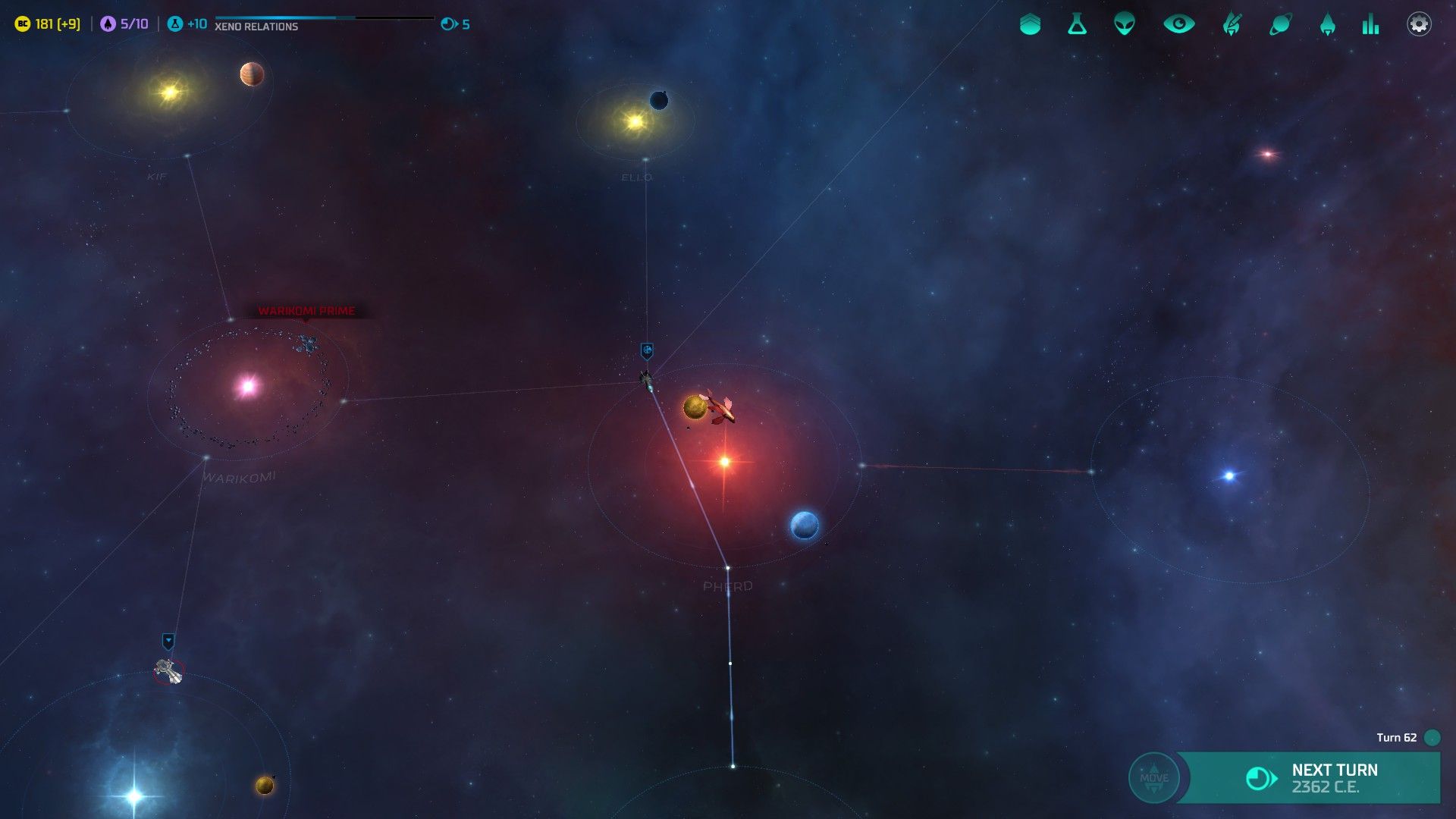 In 2362, the Werner von Braun, continuing its mission of exploration, cautiously set a course around the perimeter of the Pferd system, hoping to get from one FTL conduit to another without attracting the attention of the 'dragon' in-system. Fortunately, this course of action seemed to work, and it proceeded on with its mission. Space monsters normally do not seem inclined to head to the jump points at the edge of a system to engage intruders, but will wreck you if you try to visit a planet.   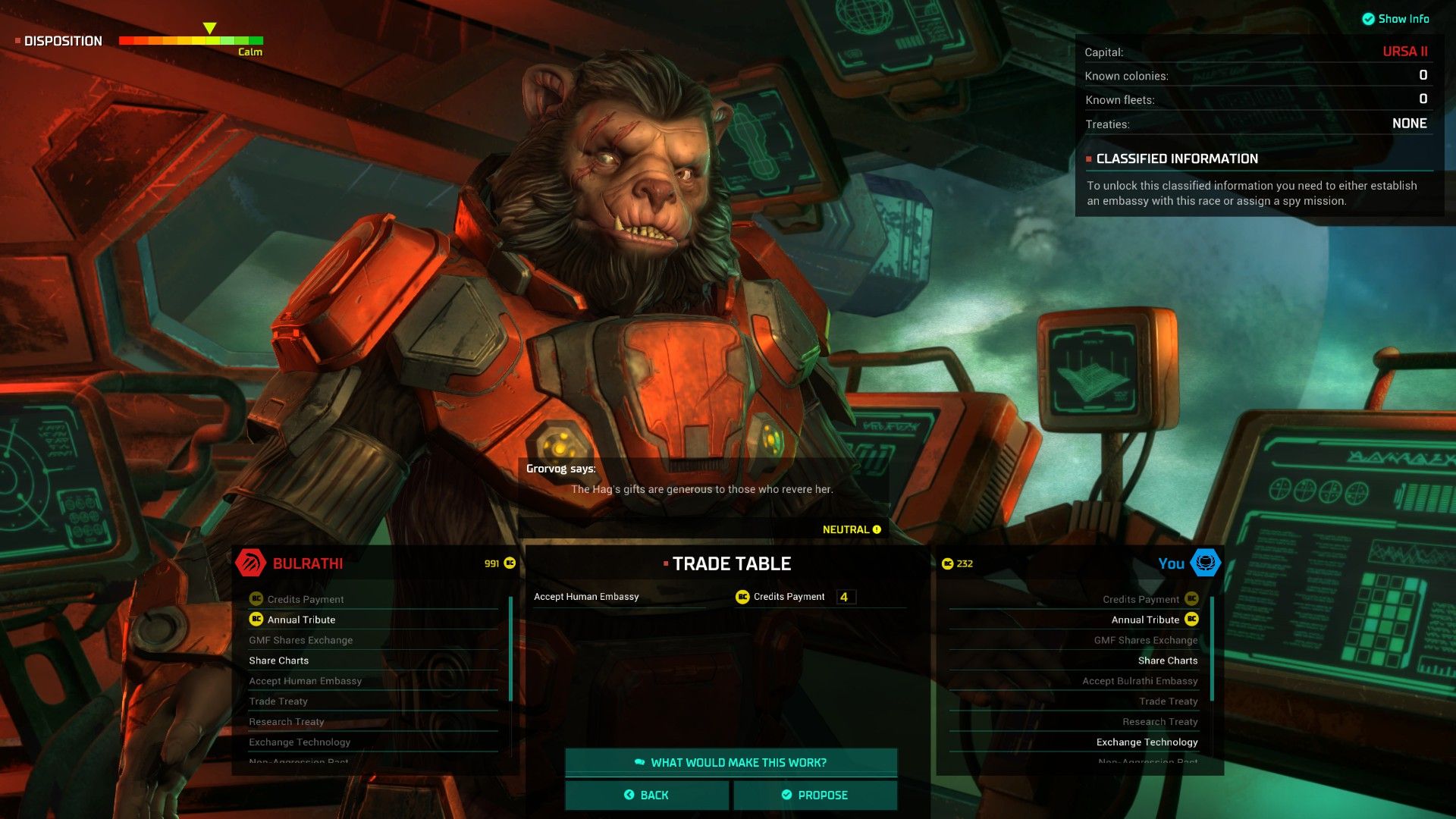 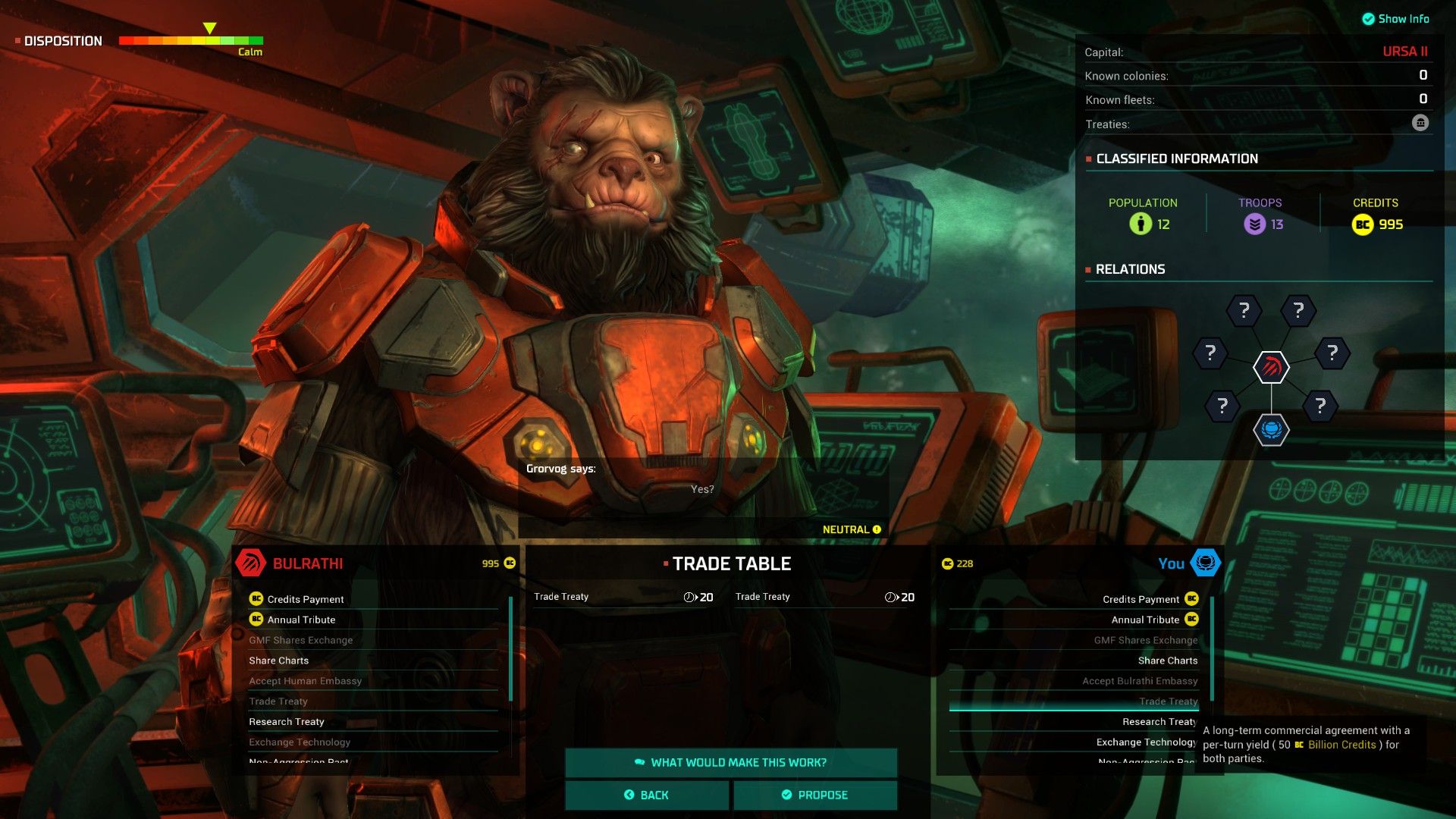 Meanwhile, work continued frantically on Earth to learn more information about the Bulrathi and assemble a diplomatic service suitable for establishing permanent relations with the Bulrathi Empire. By 2367, matters had progressed far enough that negotiations were opened to send a permanent Human diplomatic team to Bulra, the Bulrathi homeworld, to establish lines of communication. With this new embassy established, diplomats negotiated an agreement to open the borders of the Bulrathi Empire and Human Republic to long-distance trade, which started a steady stream of industrial and consumer goods flowing between Earth and Bulra, not the least portion of which was a trade in alcoholic beverages on either side- both Humanity and the Bulrathi had a long history with alcohol as an intoxicant. The Bulrathi Empire proved to be an autocratic state balanced between the secular authority of the Emperor and the other military aristocracy and the nature-venerating religion led by the Hag, an elderly wise woman who guided the Bulrathi people. The Bulrathi, too, have have difficulties with pirates that splintered off from their own species, but viewed the battles with the pirates as an opportunity for glorious battle. You need at least one side to have an embassy established before you can establish almost any diplomatic arrangement, including trade treaties. Setting up an embassy also lets you see the population, army size, and treasury of the other power. Trade treaties last only 20 years, taking an initial investment of credits on both sides and paying back an annual income until they need to be renewed. We spent 50 BC setting the agreement up.    The Human pirates in Warikomi completed assembly on another ship in 2368, which arrived at Mihr in 2372. The Arbalest promptly engaged, launching off its missiles at long range and destroying the ship before it could even open fire- the Republic Space Fleet's technical superiority over the pirates seemed to render any battles almost a foregone conclusion. 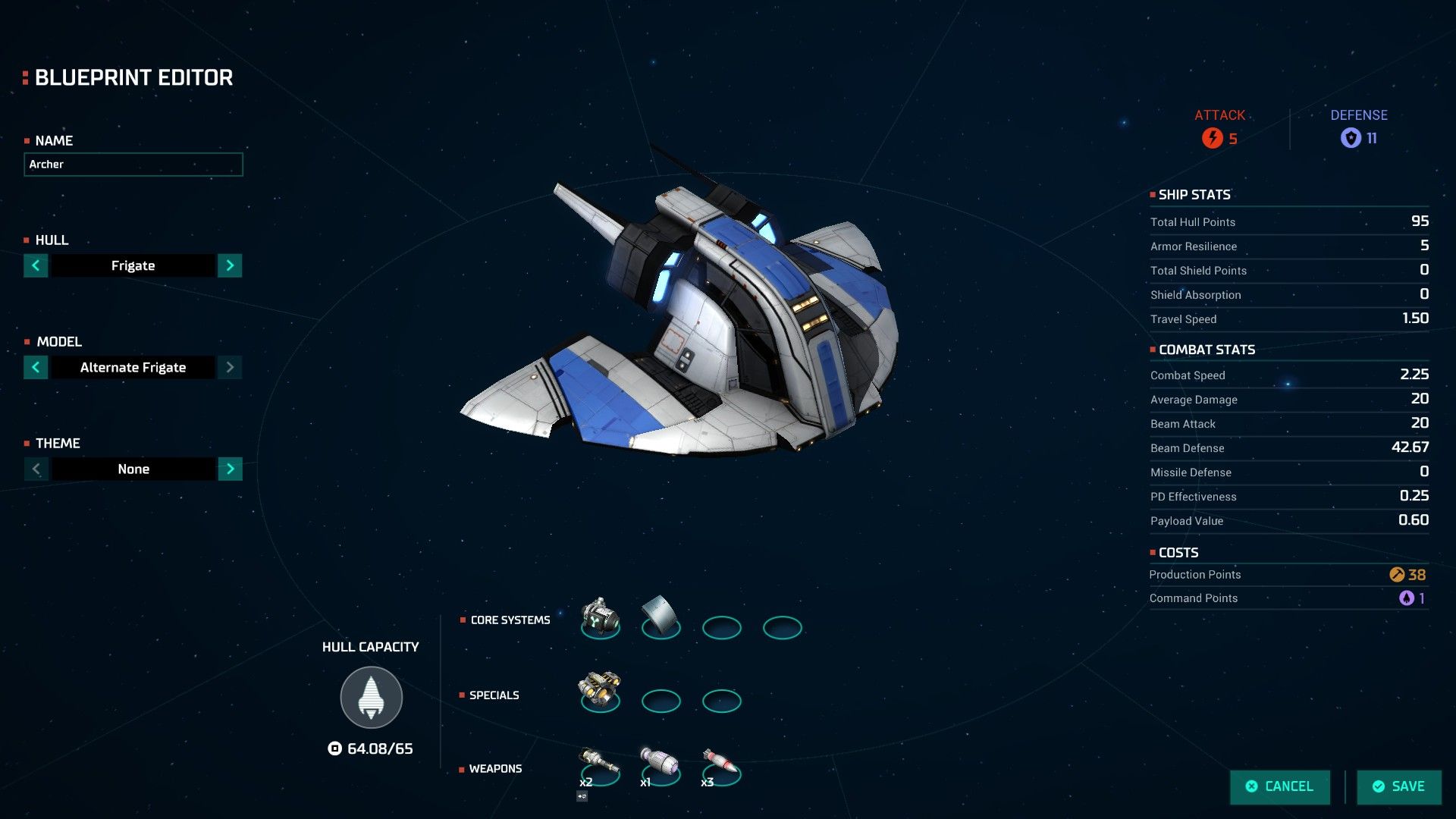 Only weeks before the battle in Mihr, the Space Fleet's second combat vessel was launched. The Archer, designed by Galaxy Technologies, sacrificed a missile tube relative to the Arbalest to mount a launcher for heavy unguided nuclear warheads, hardened against atmospheric re-entry and suitable for the systematic demolition of the pirates' infrastructure in the asteroids of Warikomi. Ground attack against colonies, pirate bases, or infrastructure on asteroids or gas giants is not possible without bombs, so the Archer class mounts one nuclear bomb for pirate-hunting.  The Bulrathi made an offer that same year, proposing to share their survey data with Humanity in exchange for Humanity extending the same courtesy. In the interests of continued friendship between the Human Republic and the Bulrathi Empire, the Foreign Department submitted the proposal to the legislature and had it ratified. 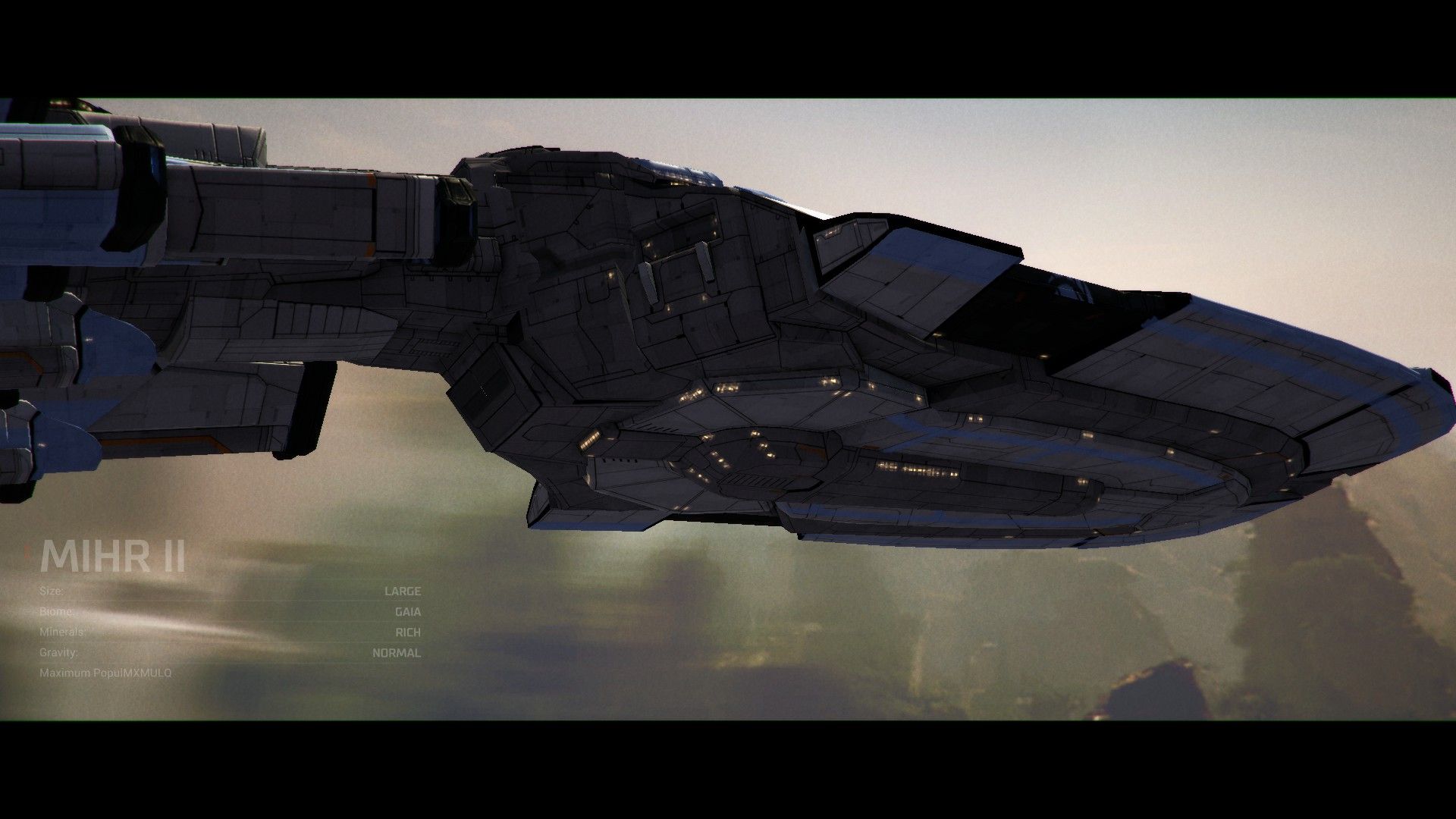 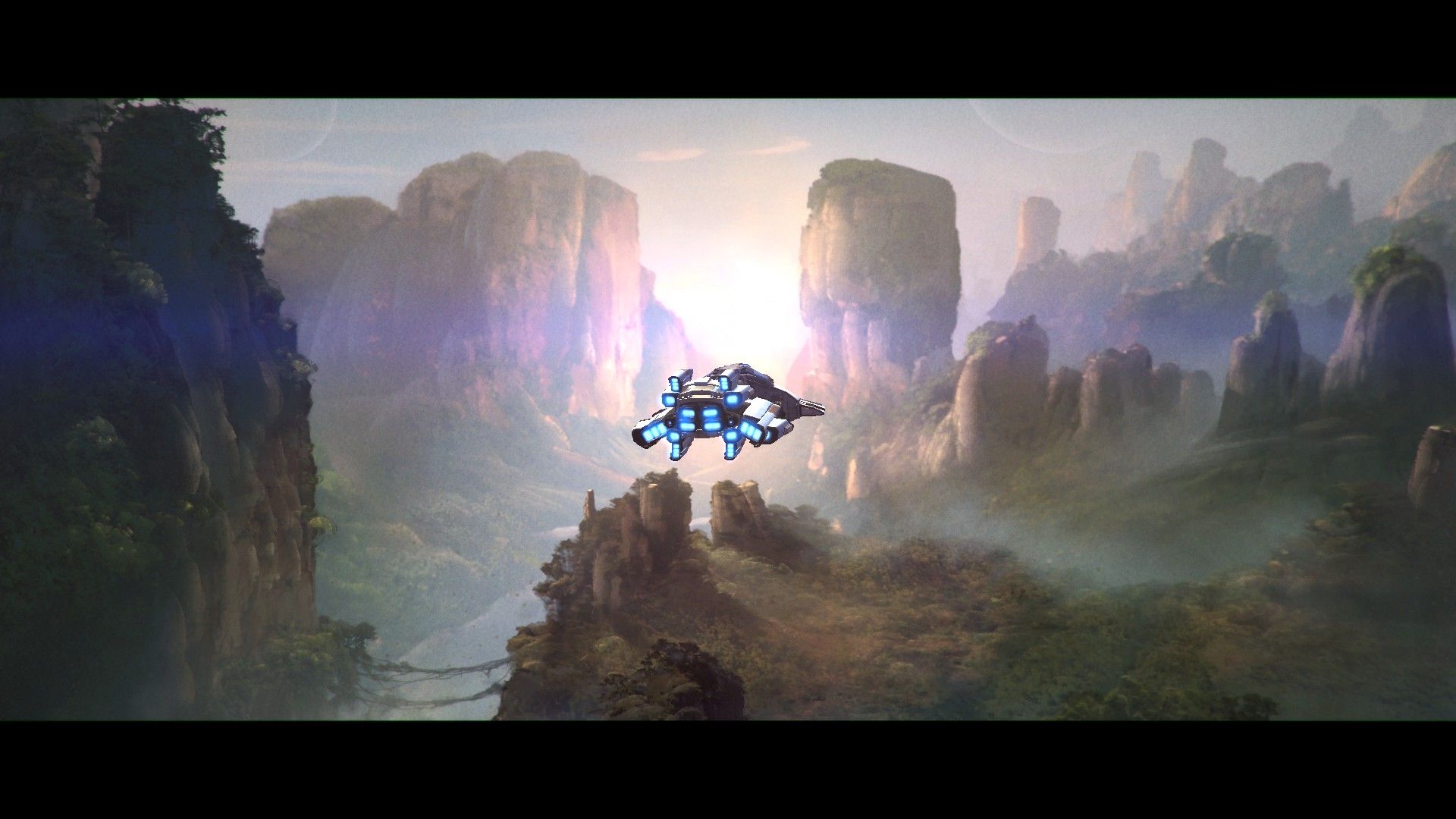 In 2374, Humanity finally established a permanent colony on another planet, landing a major colony mission on the planet of Paradise in Mihr, shortly followed by a second wave of eager colonists. Although the gravity on Paradise was uncomfortably high at 1.3 G, nonetheless it was within the range of Human tolerance, and otherwise the planet was a lush and fertile wonderland with rich mines that fed a boom in newly-established local industries. The factory ship Industrious, on contract to the Space Fleet, promptly began assembly of a new military station guarding the conduit between Mihr and Warikomi, helping to firmly secure Mihr as the Republic's territory. Colonising new worlds gets you a neat little animation, based on the environment of the planet colonised, in which a colony ship of your race lands on the surface of the new world.  Continued work in the study of economics on Earth helped with the development of new analytic methods that should help render the operations of both business and government more efficient, rapidly identifying points in an organisation where expenditures are wasted or determining the most efficient way to secure new revenue streams. These breakthroughs almost immediately spurred a wave of investment and competition on Earth, members of the business community working to adapt, lest they be left behind by more efficient competitors. The Colonial Revenue Service, like other revenue-boosting structures, has no upkeep cost. It seems clear that even without the 'Colonial Revenue Service' you have tax collection, and the description seems to focus more on improved analysis methods anyhow.  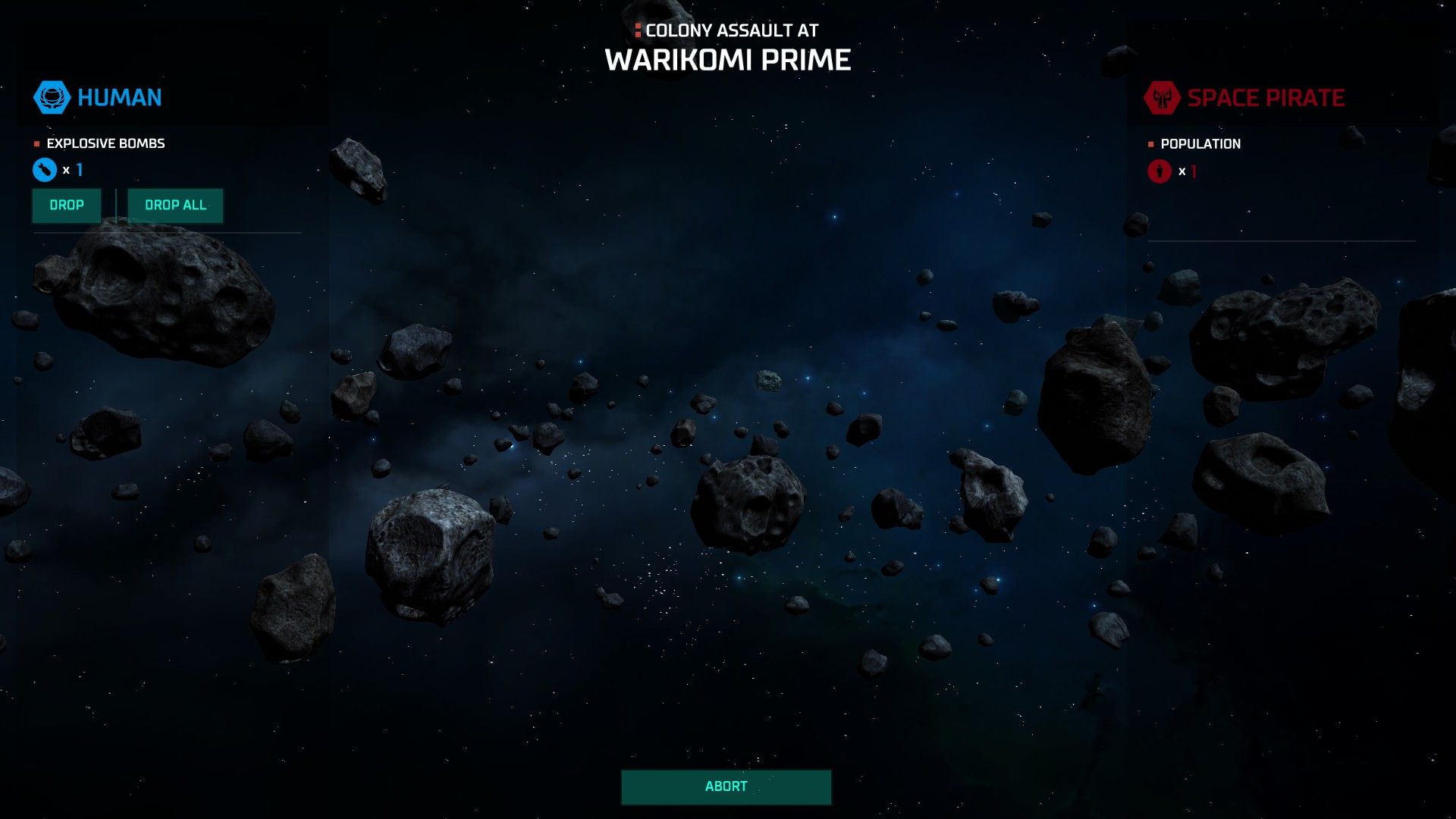 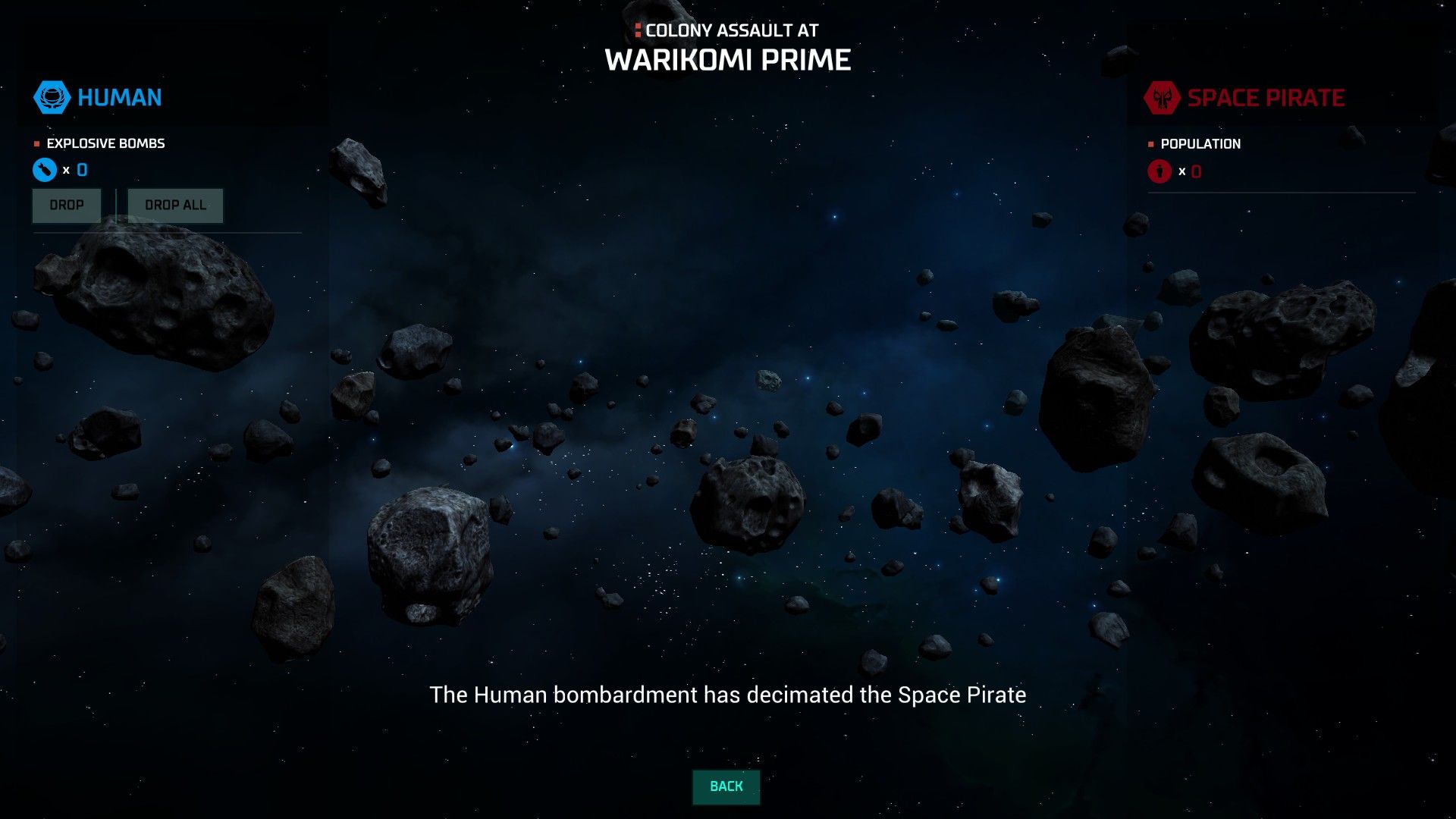 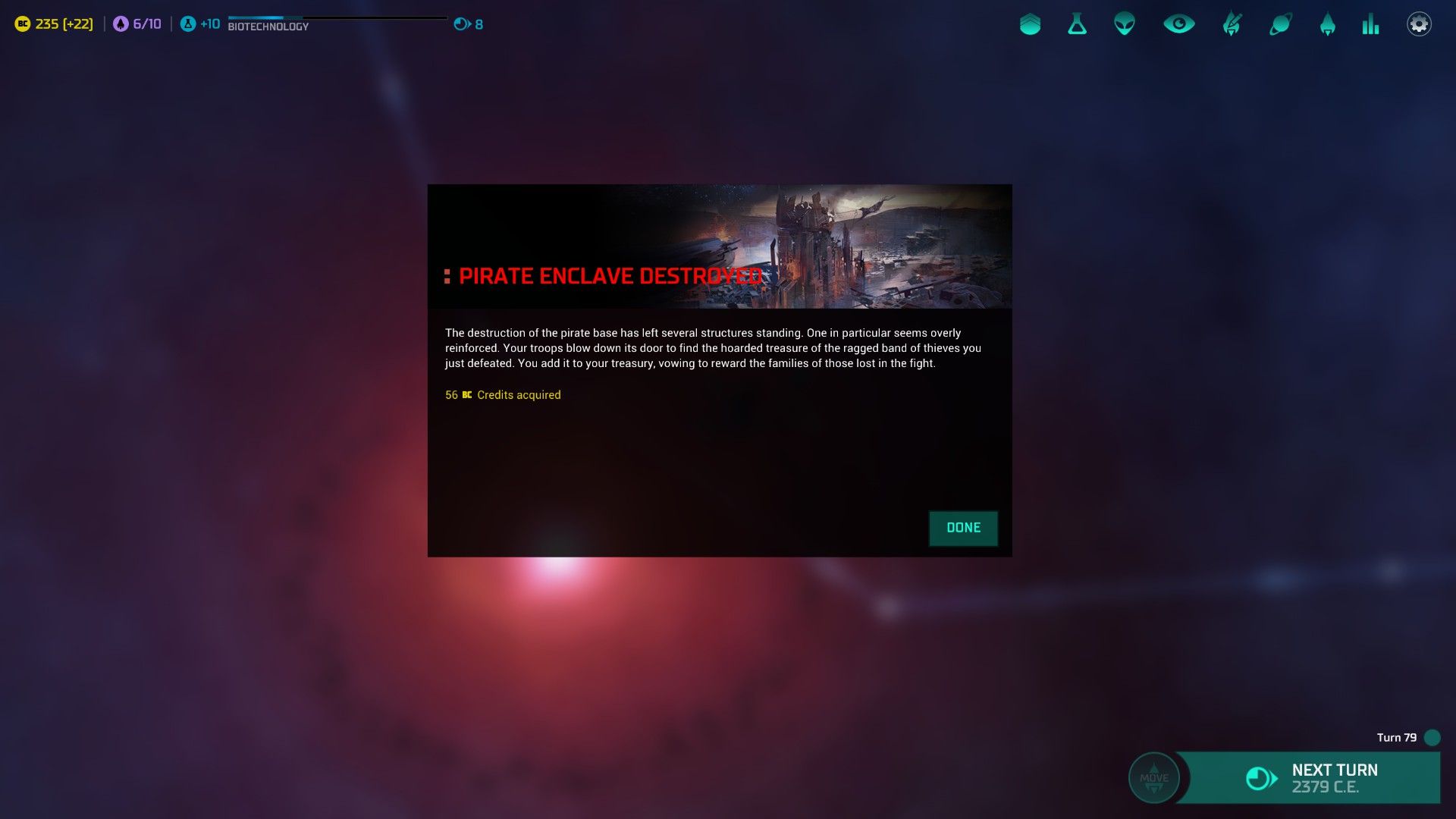 When the Archer finally arrived at the pirate settlement in Warikomi, matters were concluded relatively swiftly. A month of targeted strikes against the scattered facilities of the pirates left them disorganised and scattered, their shipyards destroyed, their infrastructure smashed, and the survivors ready for pickup by the Republic Space Fleet. The Archer's crew was able to recover a significant stock of metals waiting for processing from pirate refineries, taking a portion of the value as prize money, while the remainder went to the Republic's treasury. The Human Republic and Known Space as of 2380 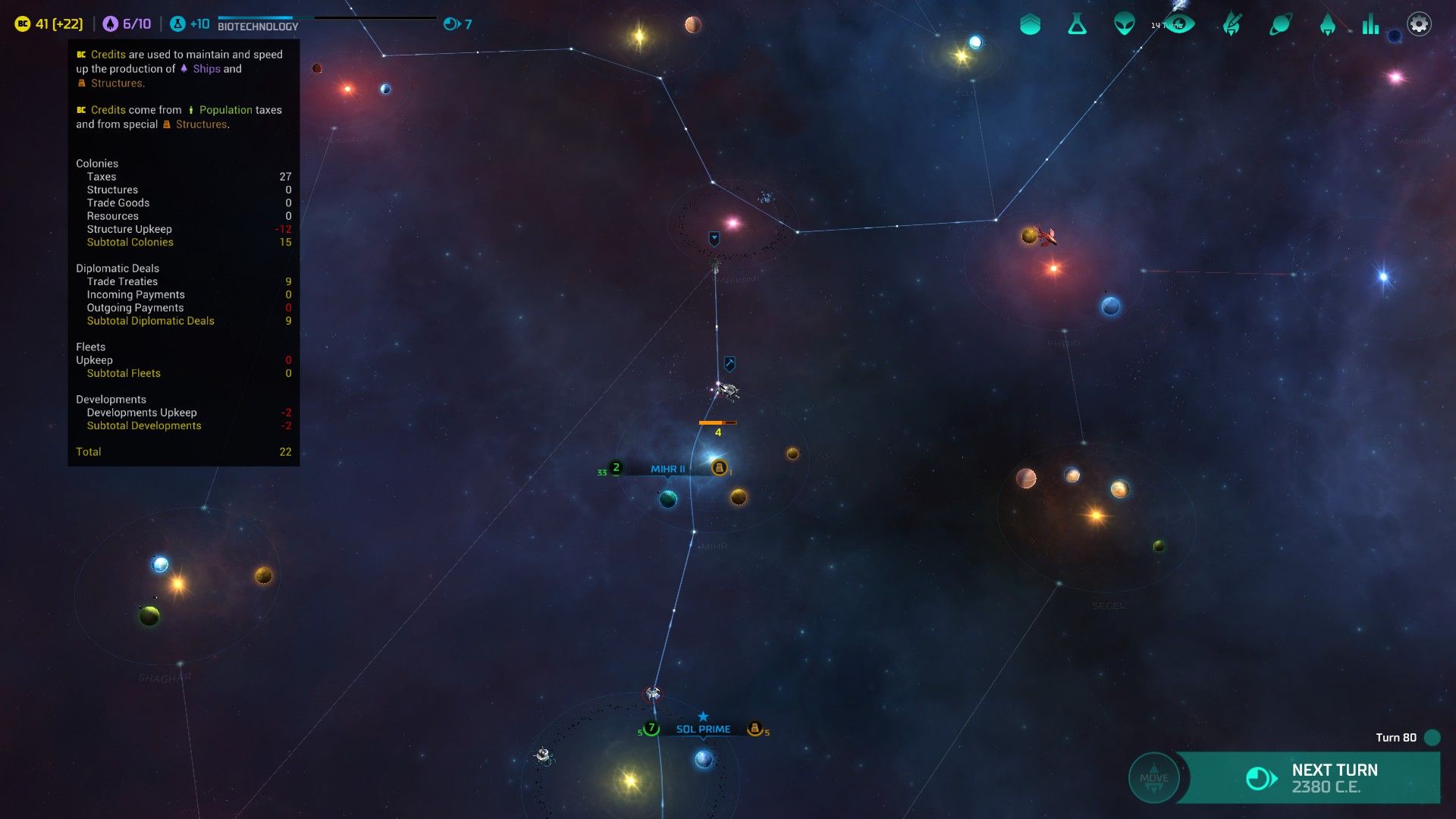  Trade with the Bulrathi Empire has proven a massive boon to the Human economy, giving access to exotic goods for Human consumers, bulk metals from the rich mines of Bulra for industry, and bulk gasses for the fuel and chemical industries from the gas giant harvesting of Ursa, with Humanity tending to provide precision and scientific equipment to the Bulrathi. The trade with the Empire has expanded the Human economy by trillions of of credits per year. The exploration of this portion of the galaxy continues, with the last three accessible unexplored conduits to take leading from Paladiaus, Ellq, and Rosemund. It is believed that the unexplored brown dwarf connected by conduit to Ellq is likely the site of a settlement of Bulrathi rebels and pirates. The Chiefs of Staff are interested to see if there exists a conduit between the red star linked by conduit to Paladiaus and the brown dwarf linked by conduit to Ellq- the presence or absence of such a conduit would significantly change the strategic landscape of the driftward galactic rim. It is believed that the Bulrathi are still only settled on their homeworld of Bulra, although it seems likely that soon they too shall establish distant colonies. As can be seen, the trade treaty has been giving us 9 BC per turn- a very nice payoff indeed for the initial investment. The 'developments' section of the finances report is for deep-space infrastructure like asteroid labs and mines- our labs in the asteroids in the Sol system are costing us 2 BC per year. 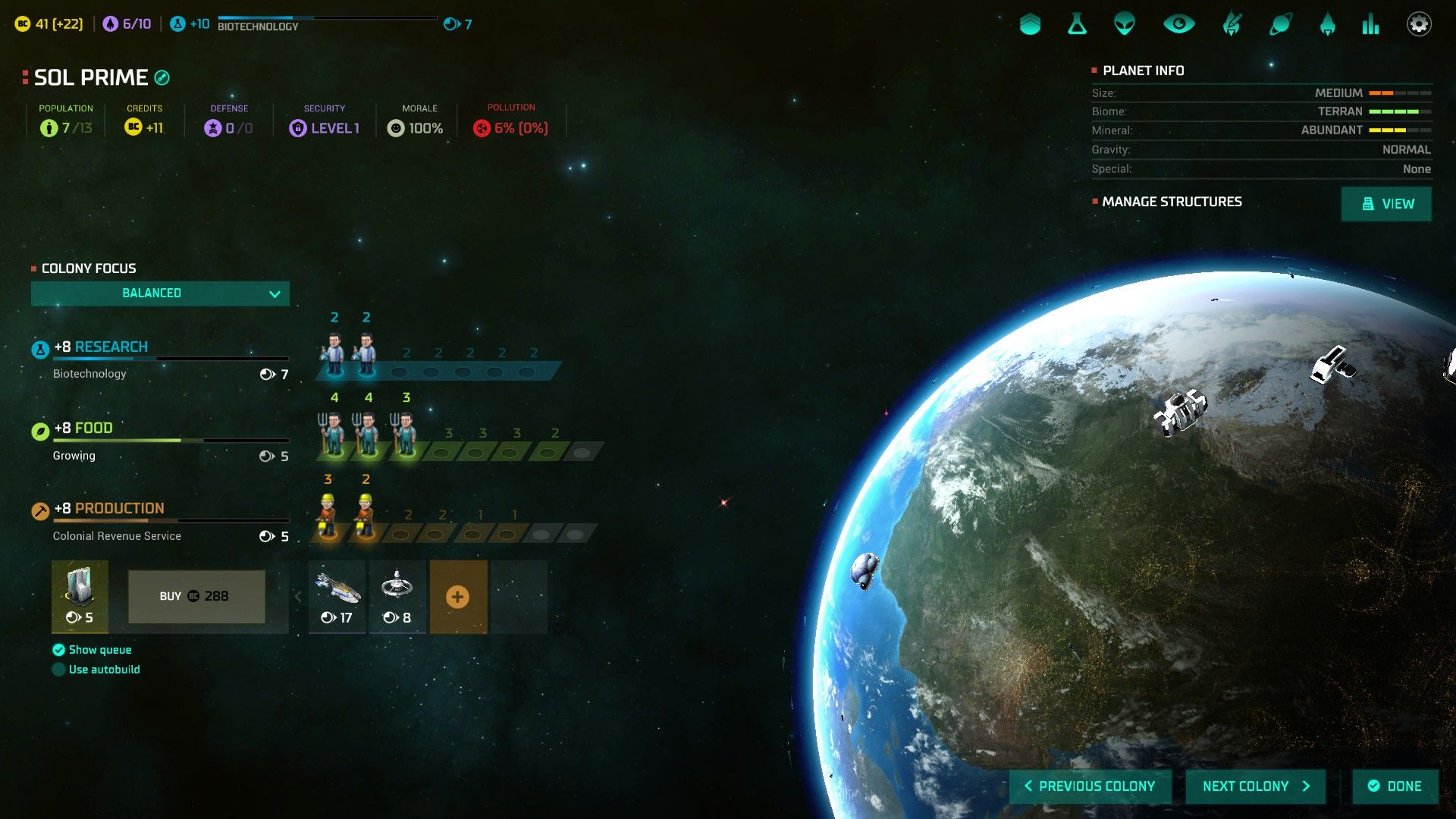 Earth is in a state of economic ferment as businesses and the member state governments of the Republic reorganise their operations. Jobs are being created and lost daily as departments are shut down as inefficient and unprofitable, while new startups are created and other departments increase hiring to expand operations. Hopefully the net effect of the massive changes will eventually be an improvement in incomes and living standards across the planet. There has been a slow increase in pollution on Earth over the past twenty years, although environmental conditions are still generally good. The population is mostly unchanged from twenty years ago, with population growth having been drawn off by the new colony at Paradise. A colony ship and the half-built star base are left in the queue after the Colonial Revenue Service, at the moment. Building Colony Ships seeds the ship with an existing population unit, so rapid colonisation can slow growth on a planet or even shrink it. 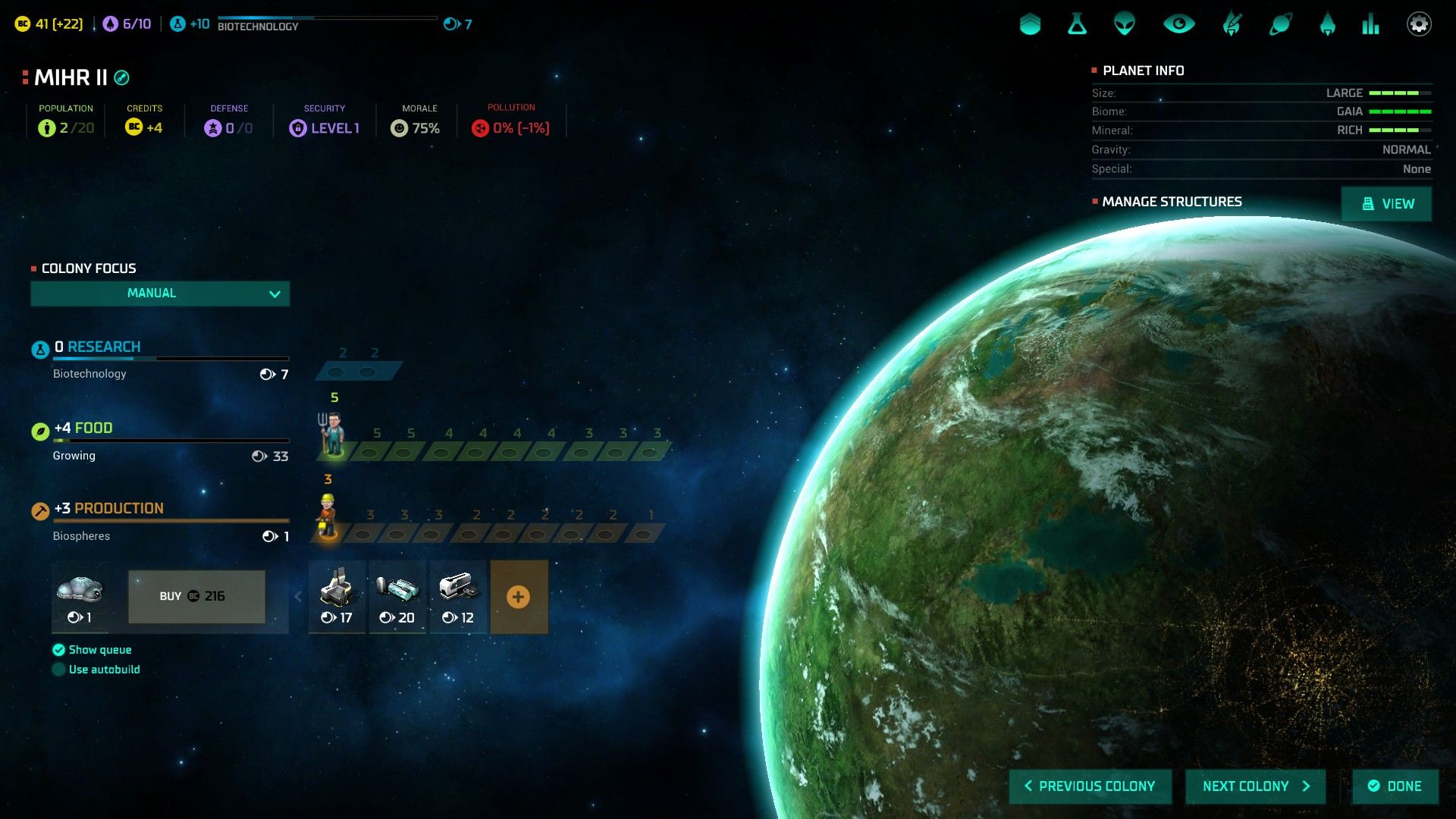 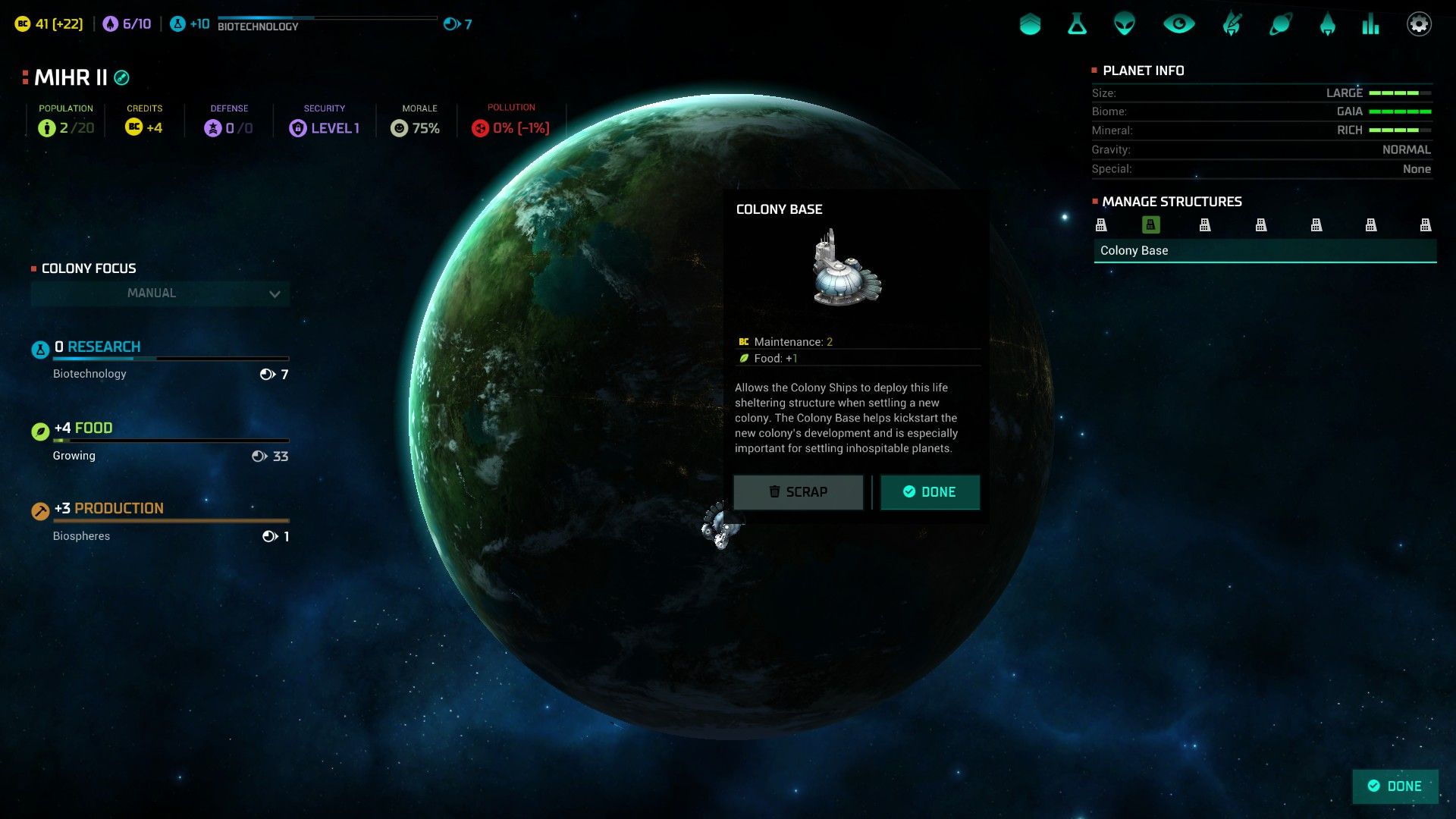 The colony on Paradise has rapidly spread beyond the initial habs, establishing a string of industrial cities and a wide swath of agricultural land with routine bumper crops. Although the somewhat more than two billion colonists here regard the planet as, indeed, a paradise in many ways, local infrastructure is still relatively primitive compared to Earth, and local governments have their resources stretched to their limits maintaining things in good order. It is hoped that as the economy here grows better-established, local governments can improve their operations. Establishment of sealed environments for scientific study and specialty crops is well under way, and local crop yields are expected to be even greater next year. Paradise has a morale of 75%, with 'morale' indicating the percentage of the population willing to work. This may result in irritating issues when the population grows over four billion. Our base morale as things stand is 75%, while other races would have a base morale of 70%. Earth has a morale of 100% due to the 25% morale bonus associated with being the capital. Currently available morale boosts for colony worlds are a Government Support Facility, giving +10% morale, and Marine Barracks, granting +5% morale- having a reserve of troops in the event of civic disorder does wonders, it seems. The current production queue is Automated Factories, Hydroponic Farms, Research Labs. 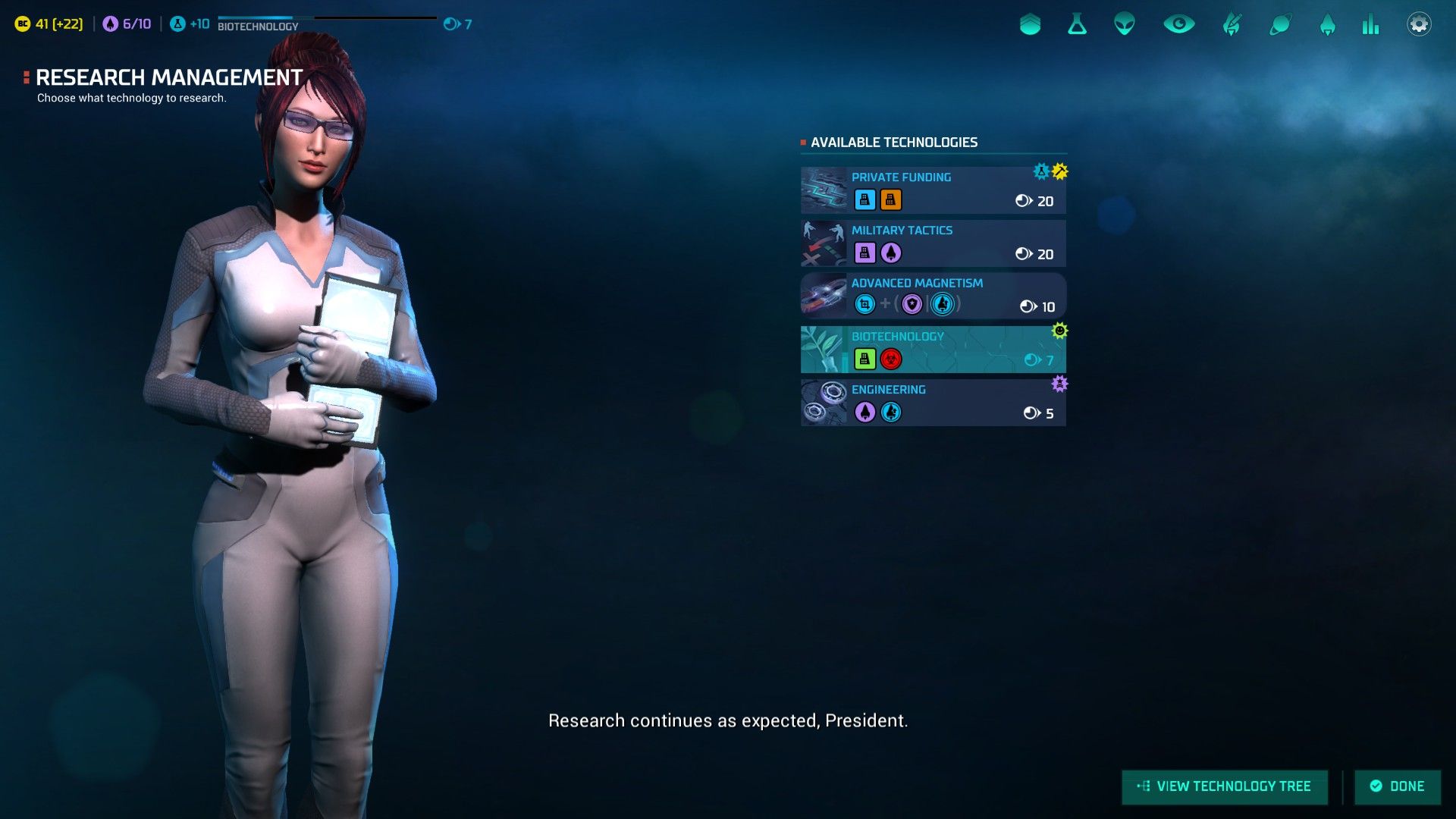 Studies into biological engineering of organisms have started to produce some results in engineering extremophilic fungi and molds that can endure an astonishingly wide array of environmental conditions and that could be cultivated even on the most unpromising planets. Unfortunately, the practical applications of this research on garden worlds is likely to be fairly limited. 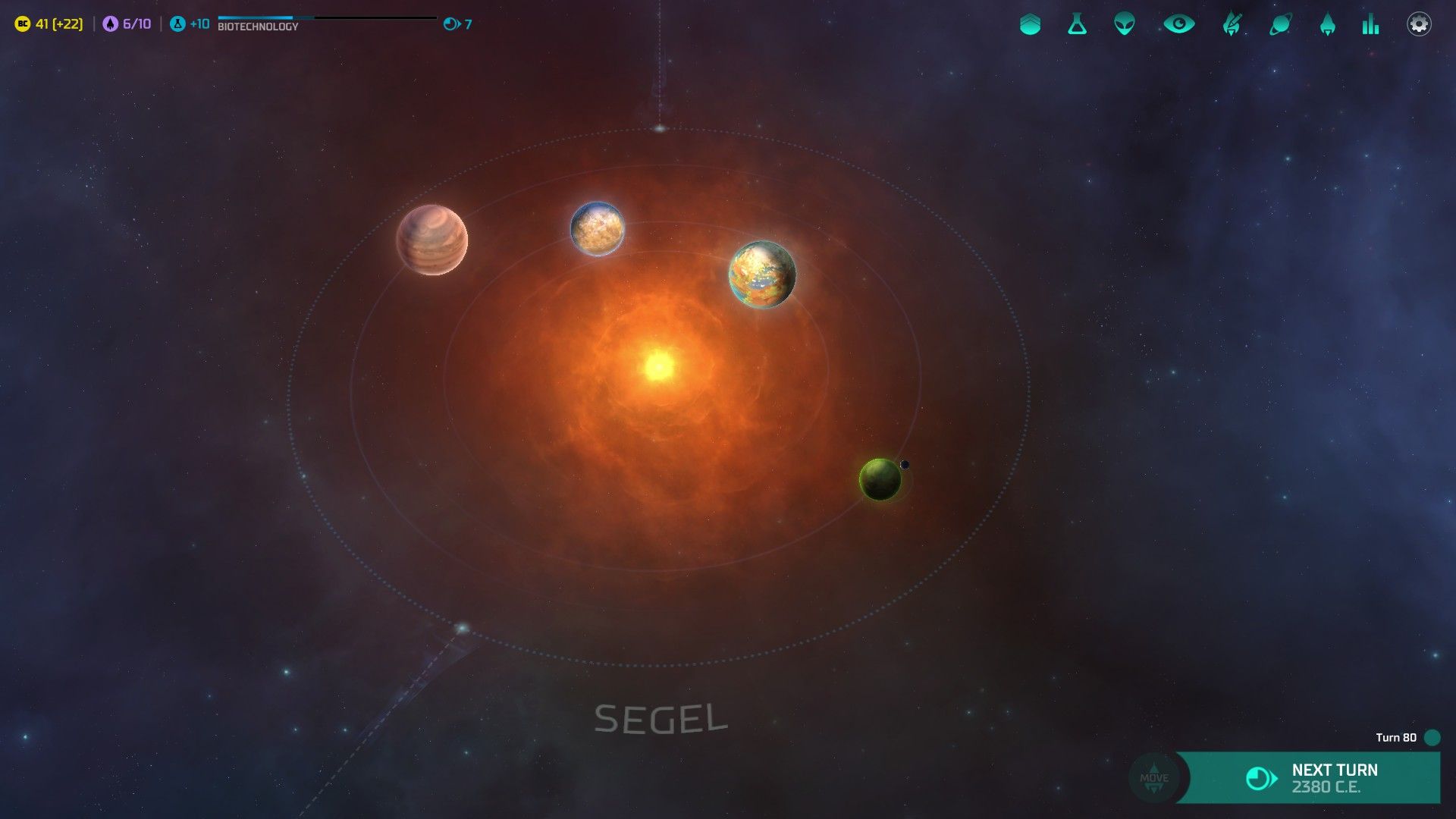 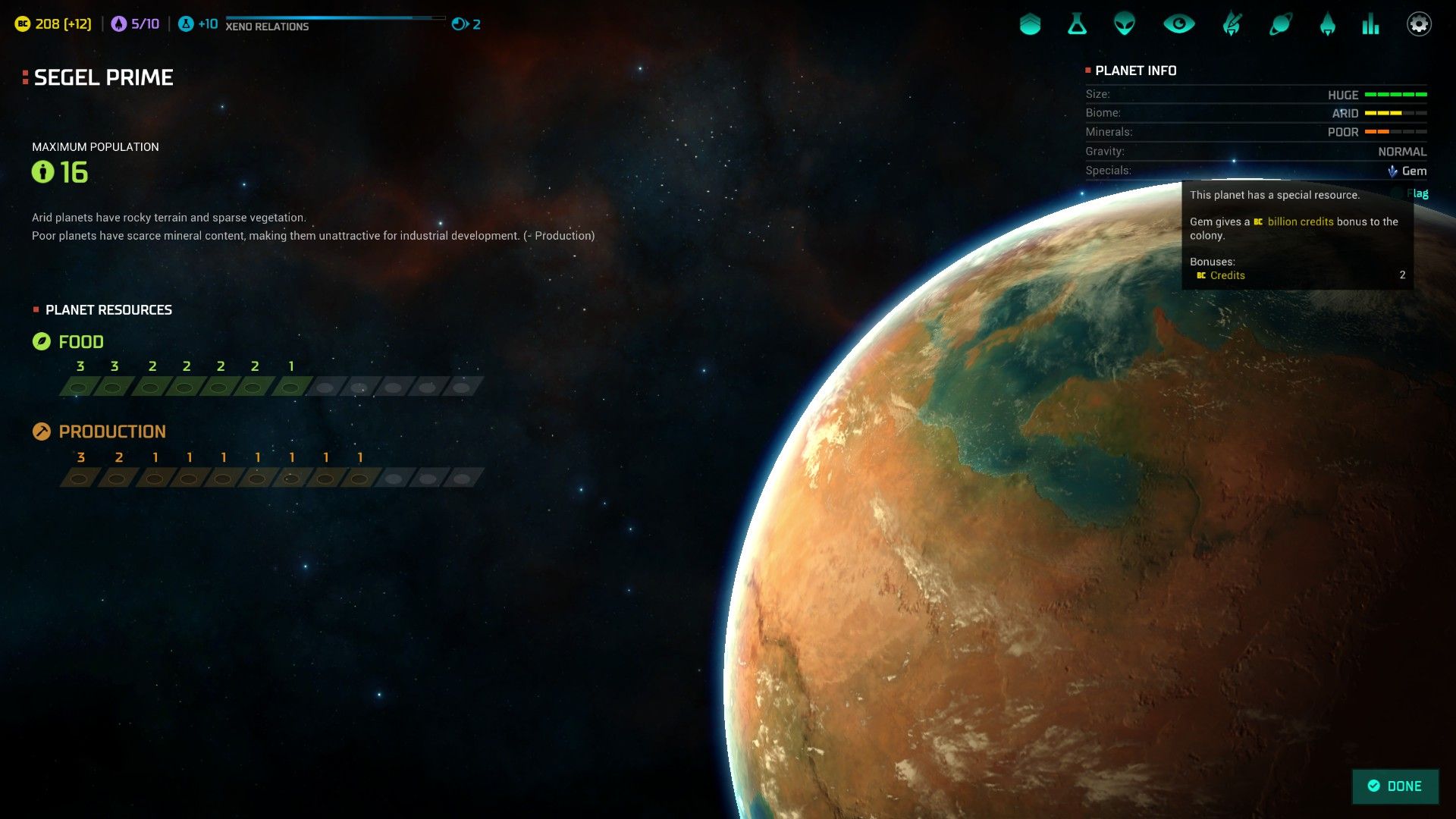  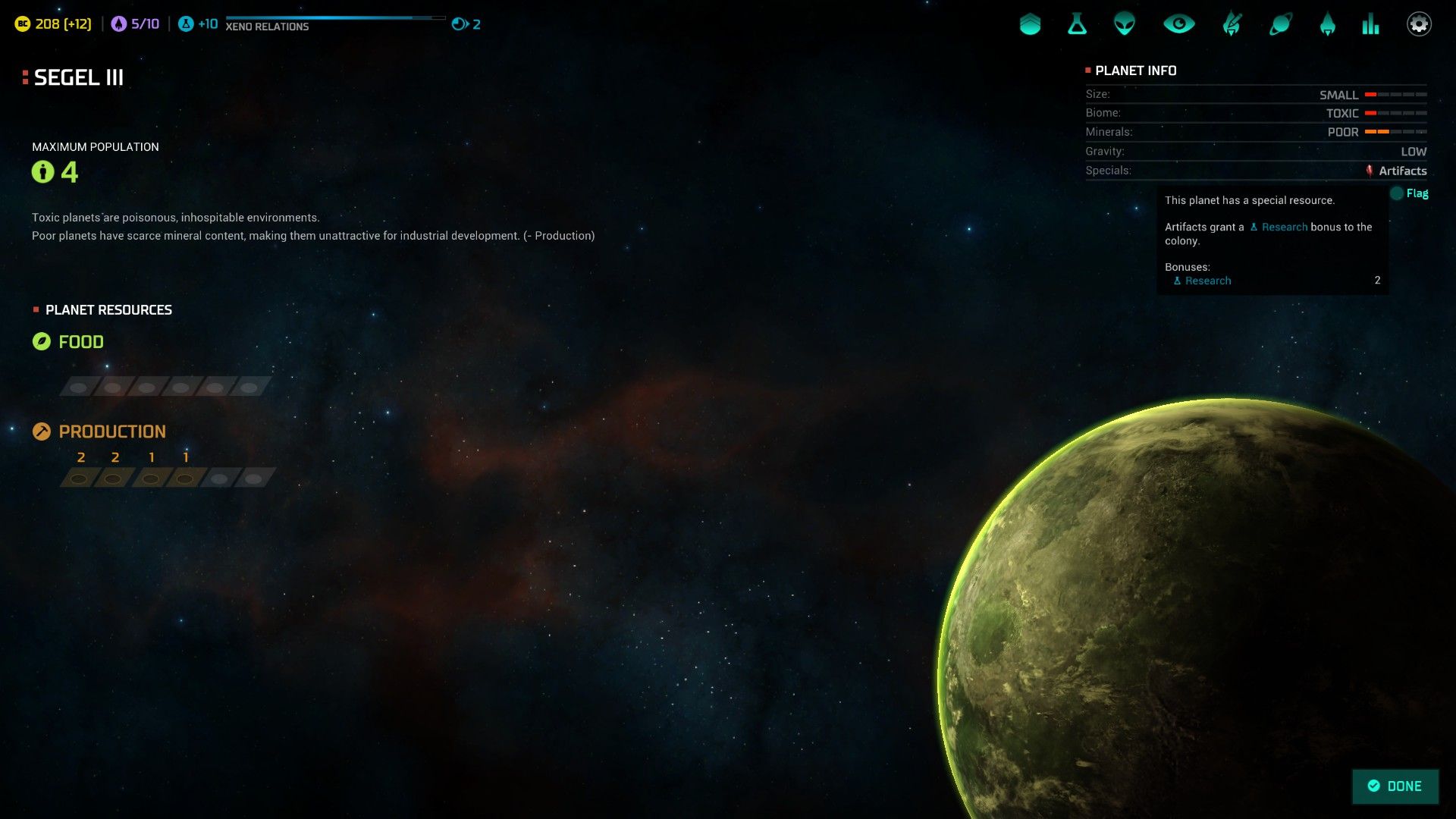 The orange star Segel between Tarazad and Pferd is orbited by four bodies of potential interest. Closest in is Segel Prime, a massive world with its own life-bearing ecosystem. Although relatively poor in water, much like Tarazad II, it still has small seas and relatively rainy basins surrounding the seas. It is fairly poor in heavy metals, although richer than Tarazad II, but has extensive crystalline deposits that could easily be mined and repurposed for ornament and jewelry. Segel II, although bleak and desolate and covered with cold deserts, with what little water is present locked in subsurface ice, nonetheless has an inoffensive inert atmosphere with reasonable carbon dioxide content, that could support farming with artificial fertilisation, irrigation, and warming. Segel III has a choking ammonaic atmosphere, with the crumbled but still-recognisable remnants of ancient industrial plants and cities scattered over its surface. Although these ancient ruins are far from salvageable, careful study may well be able to uncover some of the secrets behind the technology and society of whatever ancient civilisation created them. Even further out, Segel IV is a gas giant that should be suitable for mining operations, with a planetary colony to serve as a local logistical base for its operations. Artifacts provides 2 RP per year, much like other planetary specials that produce 2 BC, 2 production, or 2 food.  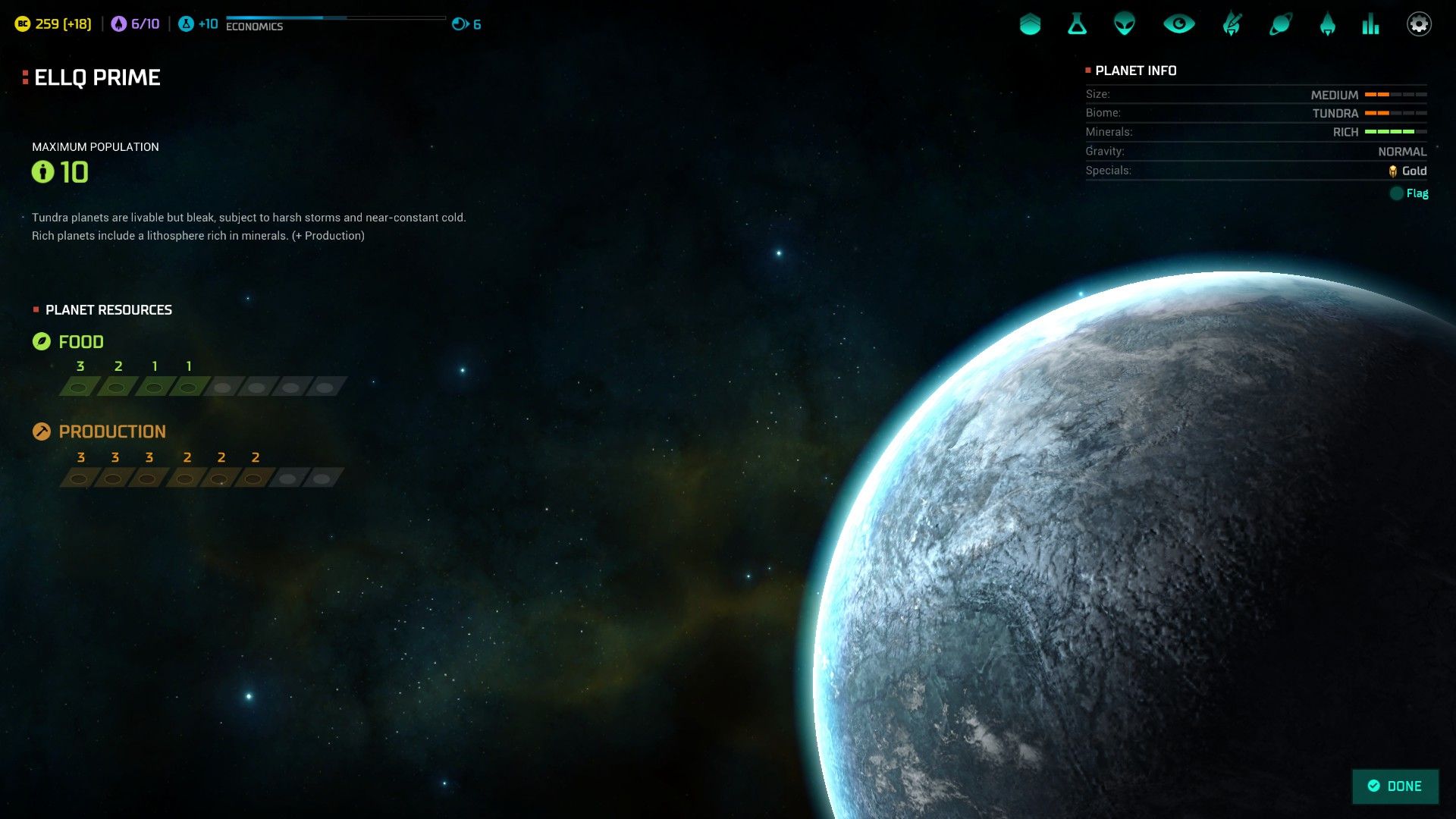 Ellq, the yellow star midway between Warikomi and Ursa, is orbited by a single body of potential interest. Ellq Prime is notable for having a partially oxygenated atmosphere- although the planet, which is nearly Earth-sized, is almost entirely covered with permanent sheets of ice, a narrow band around the equator reaches temperatures above freezing, which supports a primitive ecosystem of mosses and small crustacoids around the coasts of the oceans exposed by the equatorial melt. A rich assortment of different metals can be found in the icy mountains of Ellq Prime, including remarkably large deposits of platinum.   The cool orange star Ursa is orbited by the Bulrathi homeworld Bulra and a gas giant that the Bulrathi have begun to exploit for its immense wealth in volatile gasses. Bulra is a planet both larger and richer in metals than Earth, providing vast space for Bulrathi settlement, abundant ores for processing in their factories, and a gravitational force of approximately 1.4 G, which has helped ensure the immense physical strength the Bulrathi have evolved.  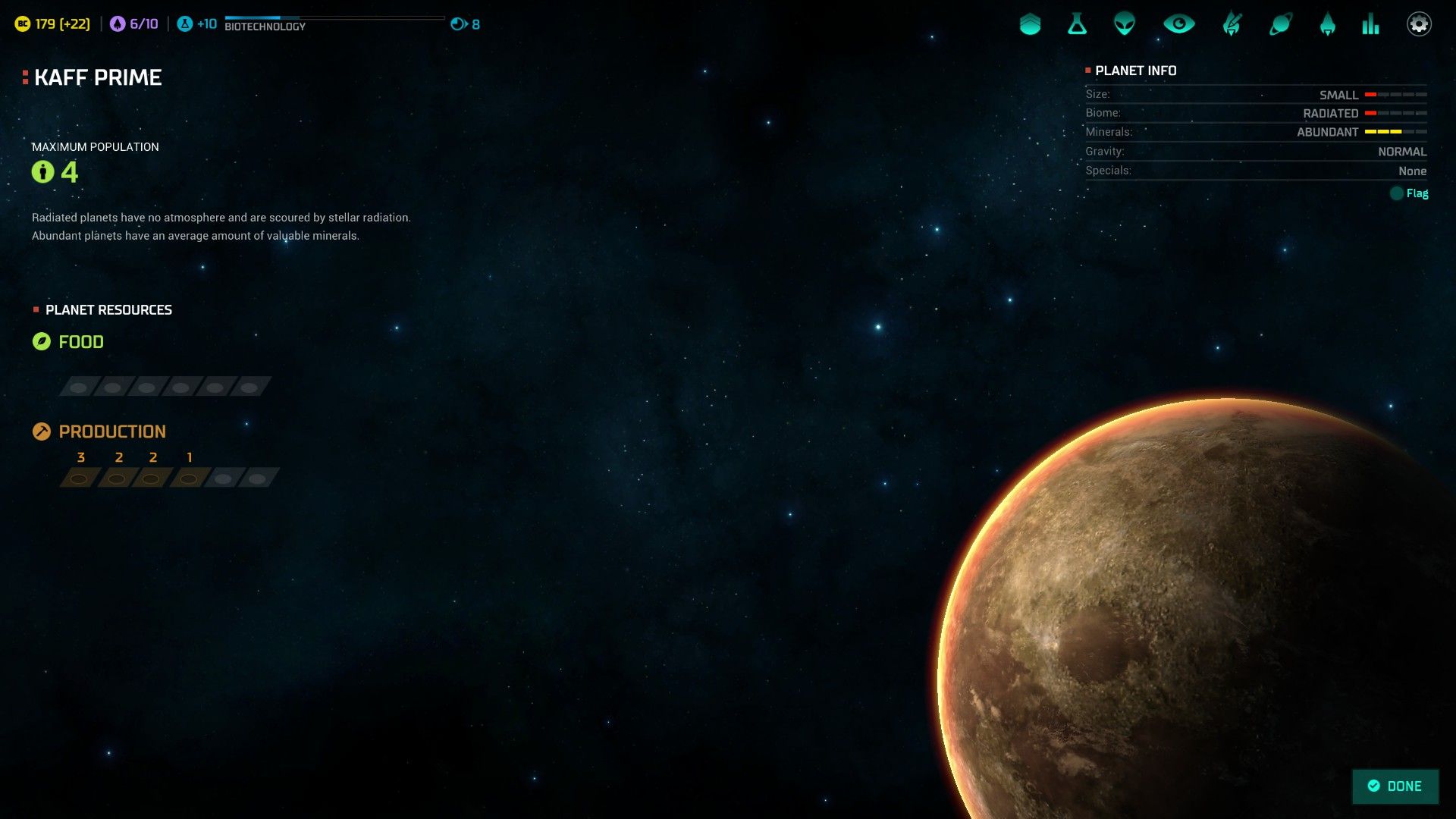   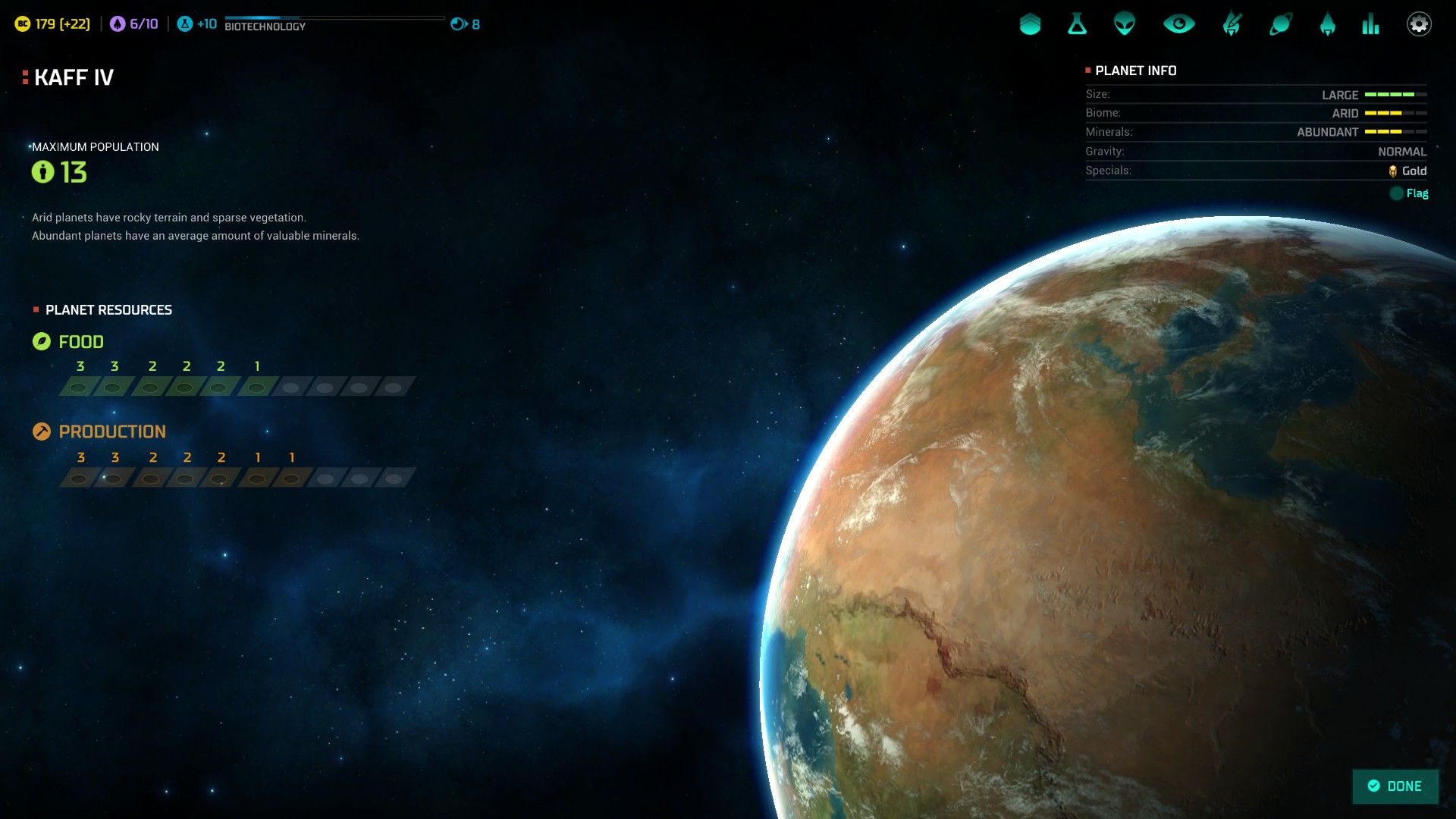 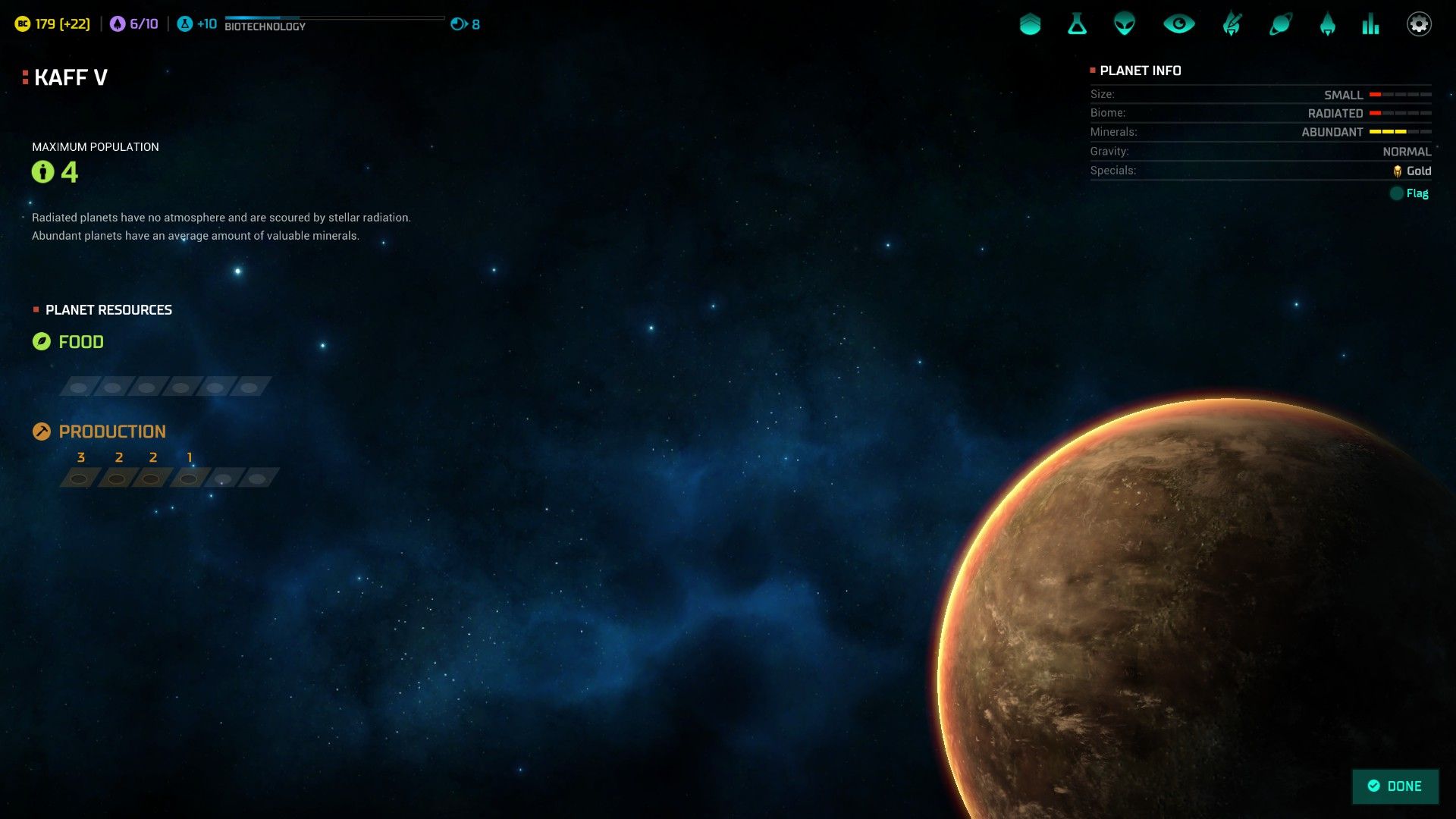 The searing blue-white star Kaff is the farthest coreward Human or Bulrathi explorers have yet reached, far driftward from Sol. Around it, fully five bodies of potential interest orbit. The closest, Kaff Prime, is a small planet continually seared by intense radiation, which reaches surface temperatures that would nearly melt lead. Despite some modestly interesting mineral deposits, the planet is, on balance, hardly one of any very great value. Kaff II is larger, with the gravity and magnetic field to retain an atmosphere. Unfortunately, that atmosphere is a thick blanket of gasses including vaporised sulfuric acid, covering a bleak wasteland of broken rocks oppressed by constant, fiery heat. Even the gold and silver scattered about the surface are a poor inducement to visit. Kaff III is a far more promising world, an arid garden world similar to Tarazad II or Segel Prime, with small seas and limited rainfall supporting a relatively extensive ecosystem. Although hotter than either of those two worlds, Kaff III is still quite a promising target for colonisation, with a breathable atmosphere and a 'shirtsleeves' environment. An Earth-sized world, Kaff III has rich and extensive industrial metals deposits. Kaff IV is another arid garden world, larger and somewhat cooler than Kaff III, although still warmer than Earth. Although not quite as rich in most metals and Kaff III, Kaff IV is extremely rich in gold and silver, a fact of interest to many. Finally, furthest out, Kaff V is a relatively small airless rock, hot on the dayside and bitterly cold on the nightside, and dosed by lethal quantities of hard radiation from the system primary. The planet at least has notable extensive deposits of gold, for what that is worth on such a hostile environment. 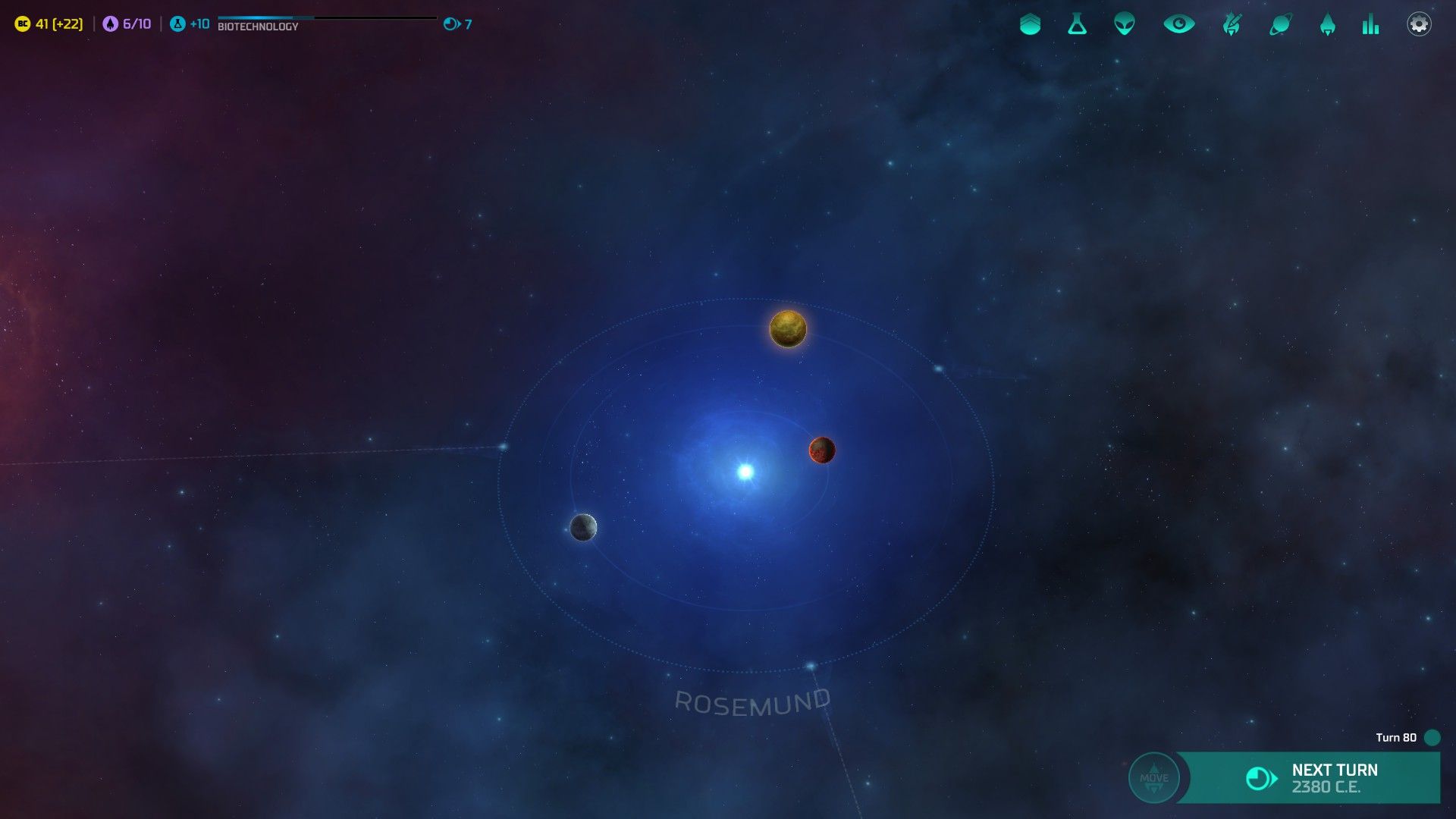 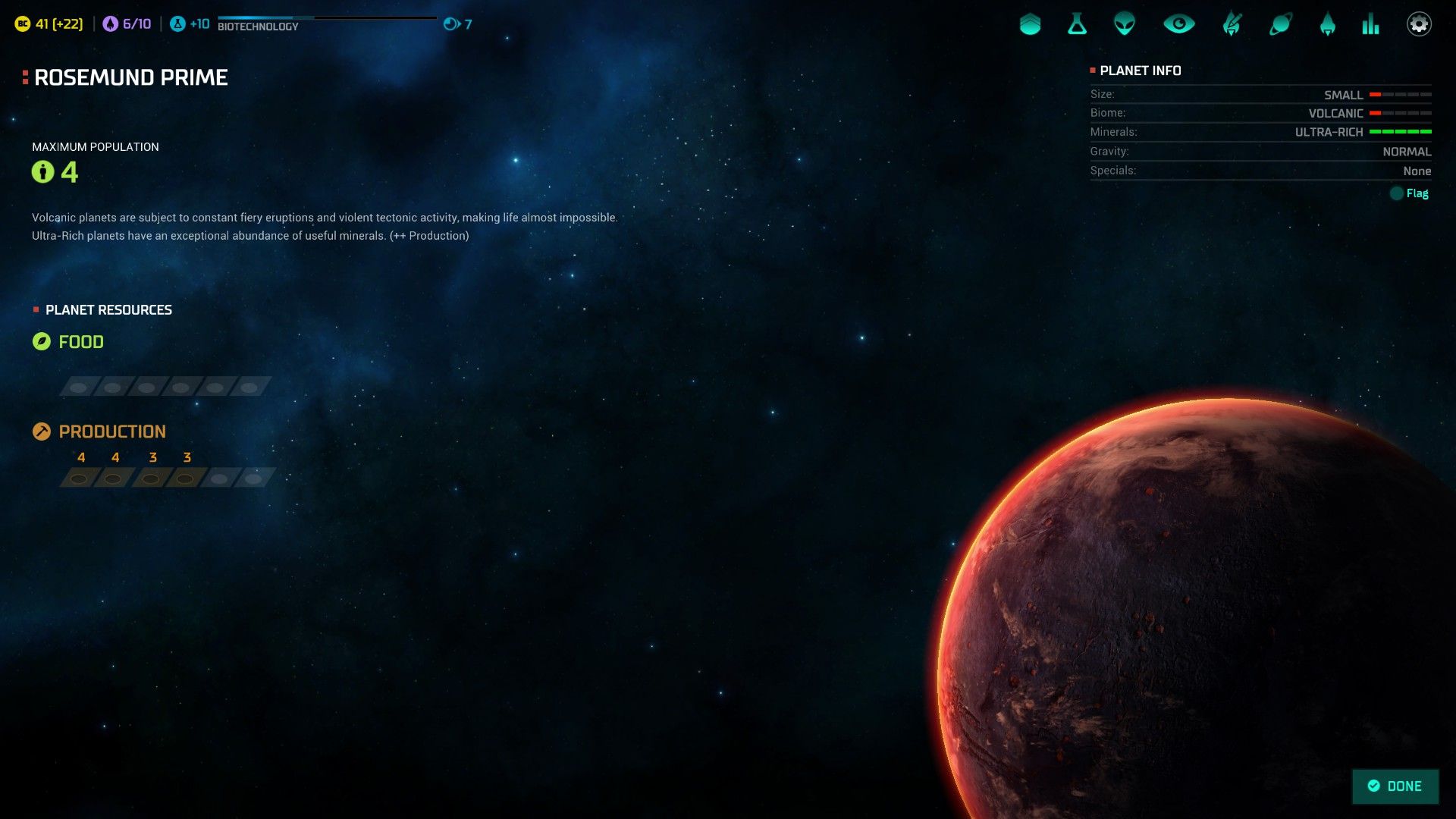 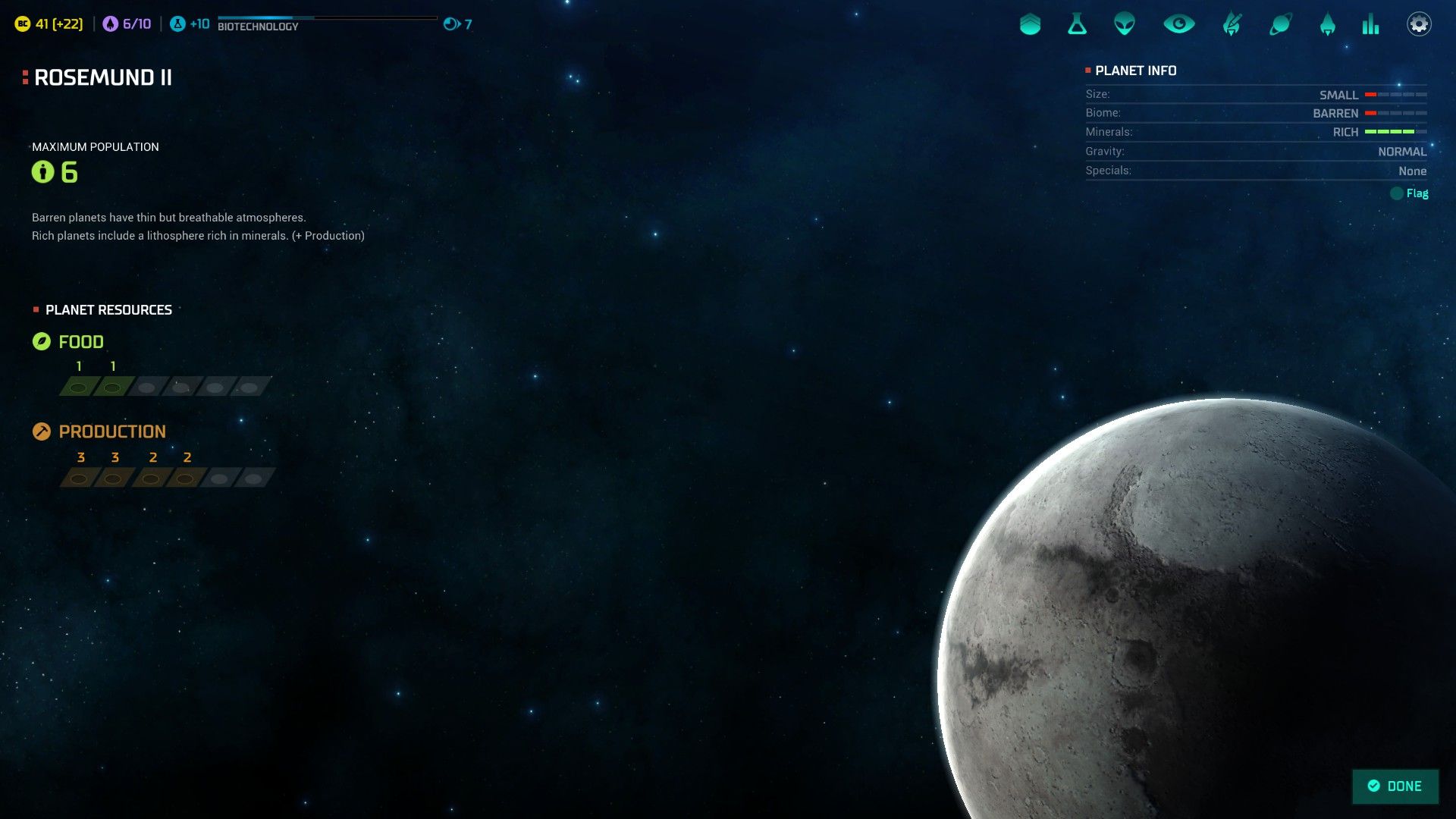 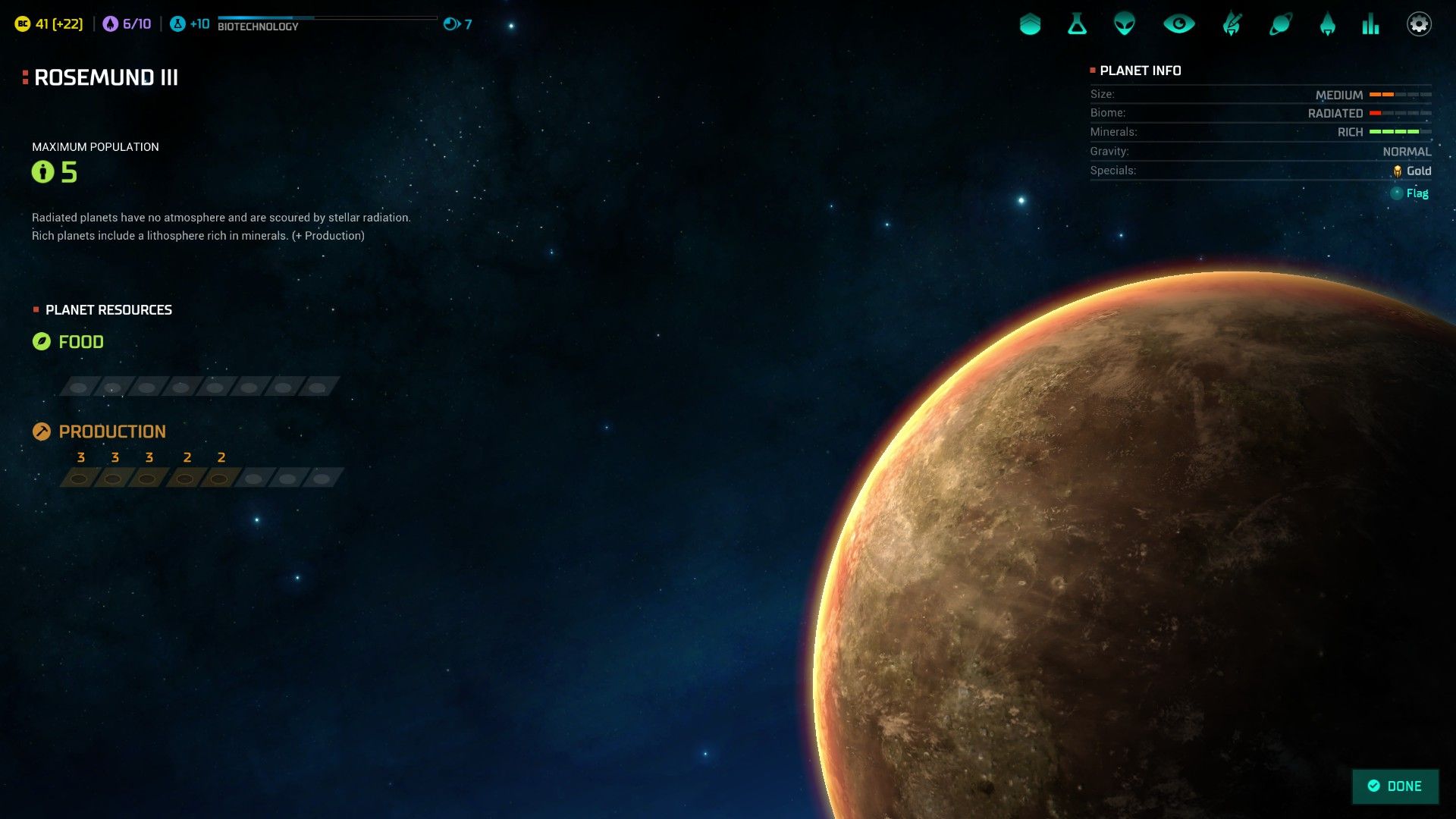 Rosemund is another hot young blue star, orbited by a small collection of inhospitable worlds. An unexplored FTL conduit exists on the driftward side of the system. Rosemund I, although astonishingly rich in metals, orbits close enough to the star that its crust slowly melts on the dayside over the course of a planetary rotation, eventually refreezing during the night. Even where the surface is solid, the constant flows of molten rock render it prone to constant earthquakes. Rosemund II, although small, is extremely rich in metals and has a molten core that generates a powerful magnetic field that protects it from the worst of the radiation from the system primary, allowing it to retain a reasonably thick inert atmosphere. The environment on Rosemund II is suffocatingly hot, but survivable. Rosemund III is the largest of these three planets, but its weak magnetic field has led to its thin atmosphere eventually being entirely stripped by radiation from its primary, leaving the surface unprotected and constantly bombarded by lethal radiation. The planet is rich both in standard industrial metals and in various precious metals, rendering it of some industrial interest. 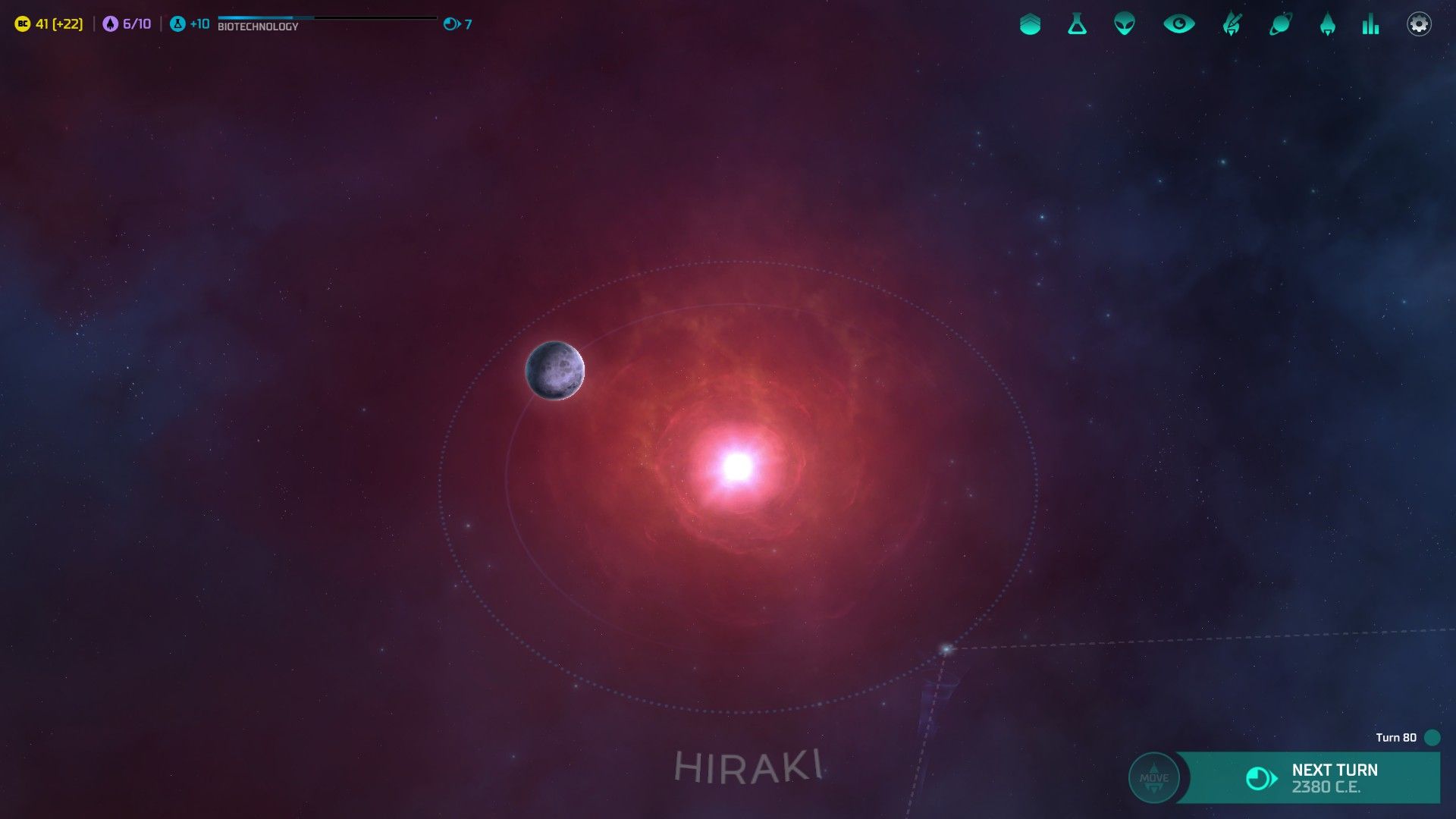 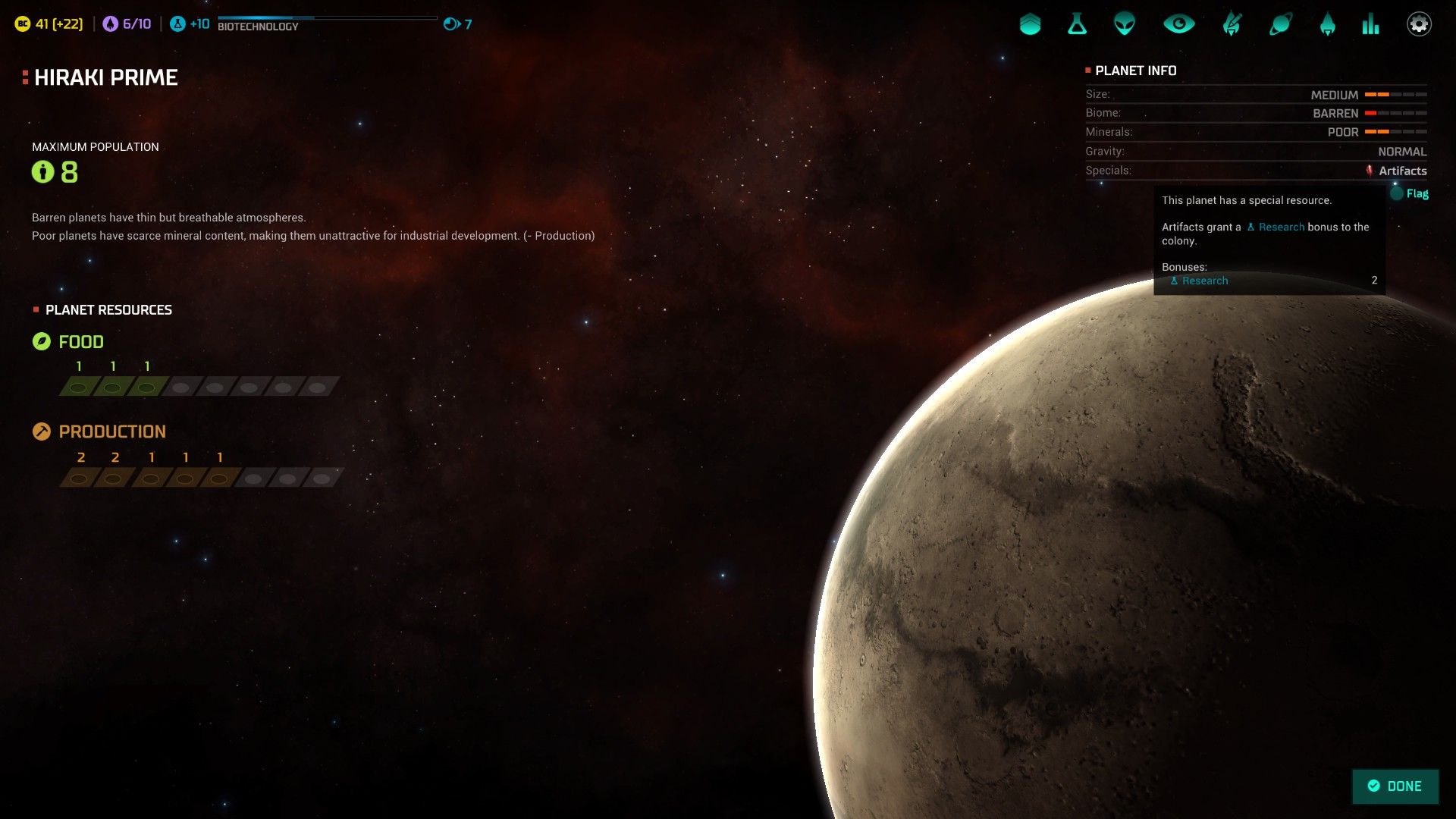 The cool red star Hiraki lies driftward of Ursa, orbited by only one body of any interest. Hiraki Prime is a dead world, bleak and arid. There is evidence that once oceans covered much of Hiraki Prime and the planet hosted extensive life, but the planet is scarred by extensive cratering it a pattern that scientists believe is unlikely to be natural- far too much of the cratering is concentrated towards former coastlines for it to be coincidental. Some small ruined settlements of an ancient civilisation can be found on the desolate surface on the areas that were once the continents of this world, away from the craters, perhaps still holding some of the secrets of their builders. Proposals for the People of the Republic Research Priorities As continued work on extremophilic engineered organisms continues, it has become apparent that the immediate results of this research will be of fairly limited application, even if it potentially lays the groundwork for more promising fields later- some researchers believe that the experience from this research may help allow for the first tentative Human projects of large-scale ecological engineering, possibly allowing for manipulation of the chemical content of hostile toxic atmospheres. Other research fields continue to draw their own slow trickle of funds- continued research into some of the more exotic properties of magnetic fields, continued work on spaceframe engineering, or certain applied corporate initiatives into improved R&D and mining survey. Some engineers believe that continued focus on engineering and chemical sciences may eventually allow for development of more efficient missiles and of systems to help manage industrial waste in a cost-effective fashion. Please vote on whether to continue researching Biotechnology, or to put it on hold. Vote also on our next research priority- Engineering (tier 1), Advanced Magnetism (tier 2), Private Funding (tier 3), Xenobiotics (tier 3), or Molecular Manipulation (tier 2). Higher tier technologies are more expensive to research. Please do not vote in favor of Xenobiotics unless you vote in favor of continuing to research Biotechnology. A vote for Molecular Manipulation will also be counted as a vote in favor of Engineering, which is its prerequisite. Military and Security Appropriations Both the Chiefs of Staff and the Xenorelations Council have recommendations for the legislature, given the possible threat presented by the Bulrathi Empire. The Chiefs of Staff are interested both in commissioning a second Arbalest-class space control cruiser to reinforce the Space Fleet, while the Xenorelations Council believes that training and recruiting an effective intelligence agency capable of responding to potential future Bulrathi espionage and gathering information about Bulrathi capabilities may be a matter worth the investment of effort. Taxpayer groups and colonist sponsor organisations, for their part, are not particularly enthusiastic about new appropriations. Please vote yea or nay on a new Arbalest-class vessel to be constructed on Earth, and please vote yea or nay on the construction of a Spy Center on Earth to found our interstellar intelligence agency. Military Deployments Rival plans for the disposition of the Space Fleet's combat vessels have been passed back and forth in the Department of Defense, with more to be accomplished than can necessarily be done at once. Some advocate for a hunting mission by the Archer to find the Bulrathi pirates, while others believe a quick scouting mission spinward of Paladiaus would be a safer and more critical use of Space Fleet assets. There are arguments that holding a picket force in place at Warikomi, Segel, or at both at once could help ensure Human claims on the entire spinward segment of known space, while more conservative planners believe that a reinforcing presence held in place by the fixed fortifications at Mihr would strongly discourage any attack and best preserve the Space Fleet's strength. Please discuss what objectives you most wish to see the Space Fleet attempt to achieve, and put forward any preferences for what vessels should undergo what missions. Other proposals may be suggested. Humanity has finally established a new home for itself beyond its homeworld, establishing lines of interstellar trade running between Earth, Paradise, and Bulra. Whatever the dangers of the stars, Human prosperity seems to be increasing, and the future seems bright. nweismuller fucked around with this message at 22:21 on Oct 12, 2016 |
|
|
|
Mzbundifund posted:What determines colony morale? Is it an expansion inhibitor that gets worse with each subsequent world settled? It's a base value determined by your tax rate (and one of the rules I've set for myself behind the scenes in this playthrough is not jacking up the tax rate) plus any bonuses. At the default tax rate of 3 BC/population unit, base morale is 70%. Humans get a 5% morale bonus- which I'm assuming, in their case, is at least partly due to personal liberty in the Human Republic. Other possible bonuses at current technology are the capital (+25% morale), a government support facility (+10% morale, only on non-capital planets, reflecting a better-organised local colonial government), and a marine barracks (+5% morale, because large numbers of armed troops provide a disincentive for people to start trouble). Worth noting the capital also provides +1 to science, food, and production- so I tend to assume part of what the 'capital' reflects is the better-developed nature of the ancestral homeworld and a certain amount of concentration of wealth. It's, perhaps, a fairly marginal effect later on, but the capital tends to be a bit more productive due to higher morale and higher base outputs than other equivalent worlds. nweismuller fucked around with this message at 23:41 on Oct 6, 2016 |
|
|
|
FredMSloniker posted:I'm confused. Why, then, is Engineering its own thing on the ballot? If it's something that could be researched so quickly that you'd get it and start on Molecular Manipulation in the same update, what other branches from Engineering might we consider? Because the way I'm counting votes, runners-up will take second priorities. Imagine, for a moment, that, say, Engineering took first place, but not Molecular Manipulation- instead Private Funding took second place. Engineering takes five years to research, and we'd blow through it- but instead of proceeding on to Molecular Manipulation, we'd instead switch over to Private Funding. Engineering has nice advantages for researching it all on its own, and I can see people wanting to grab it even without necessarily wanting Molecular Manipulation as much. Poil posted:Yea on the new ship. Can we name individual ships by the way? Feel free to propose names for new ships. As far as I can tell, you can't individually rename ships in the UI, but I'll do my best to track what ships are where. In the absence of other proposals, the second Arbalest-class space control cruiser will be the Ballista.
|
|
|
|

|
| # ¿ Apr 29, 2024 02:45 |
|
I'm away for the weekend, so no update during that time, but I'll still be able to check the forums. I'd like to thank everybody who's reading and participating for their part in things. I really appreciate Xenocide's RP effort, even if it's a little sillier than I tend to aim for, so I want to thank them in particular. You do a lot to help make doing this LP more fun for me, and I appreciate it! E: Xenocides, BTW, you didn't specify what to do about Biotechnology in your post, can you clarify on that point? nweismuller fucked around with this message at 03:10 on Oct 7, 2016 |
|
|



